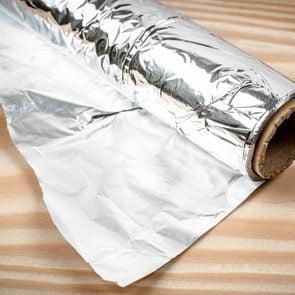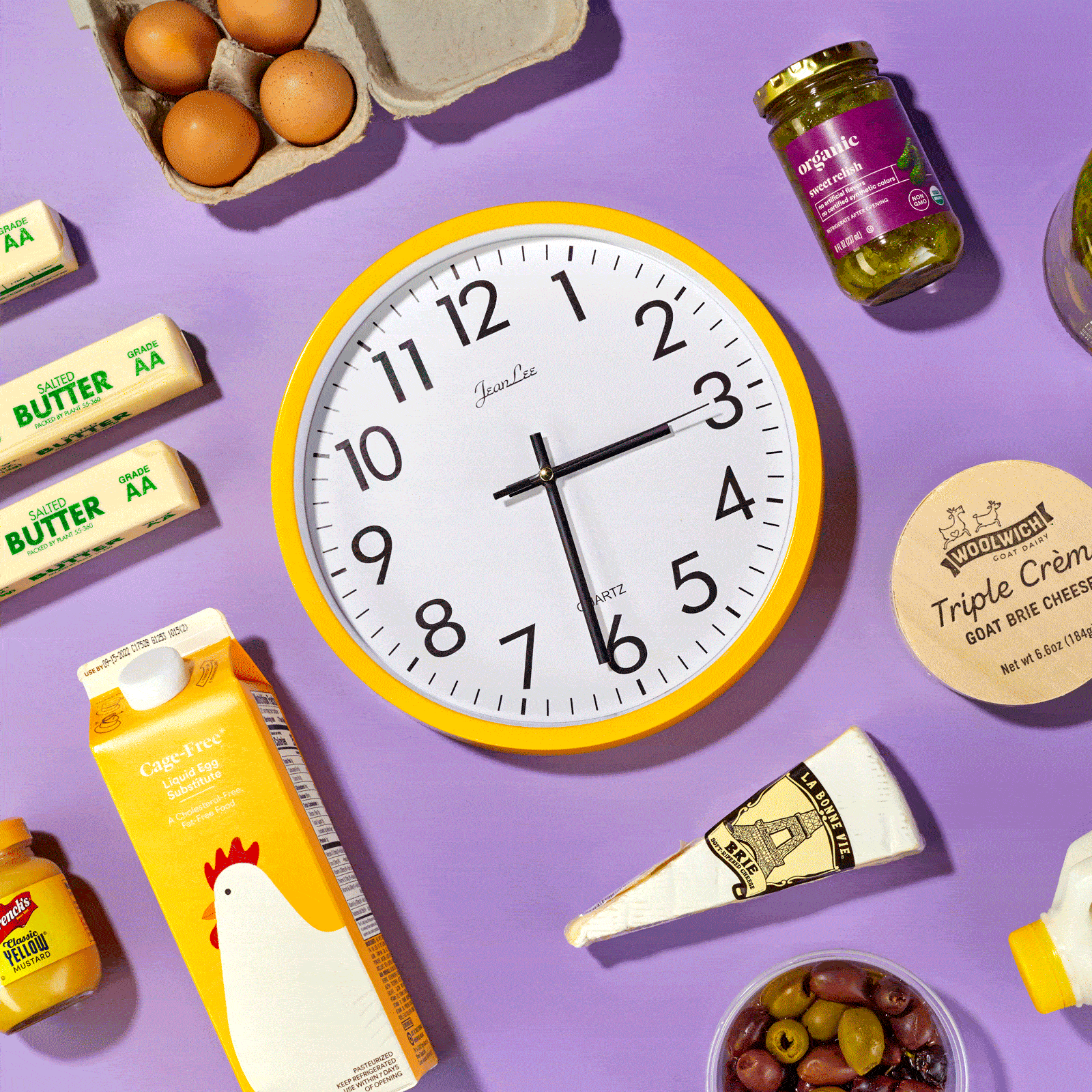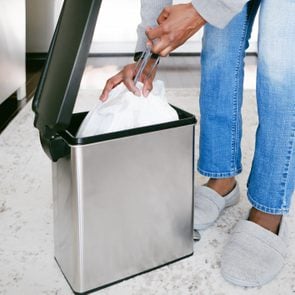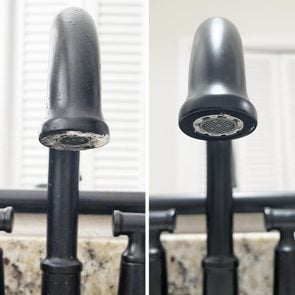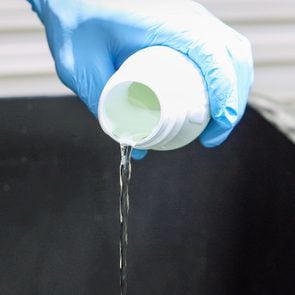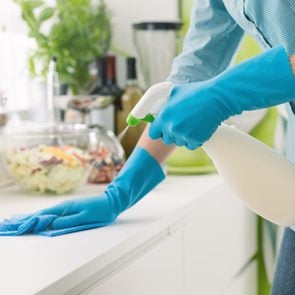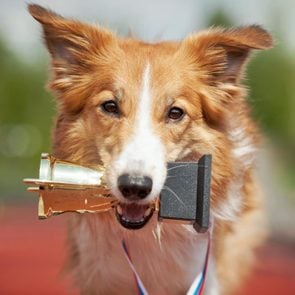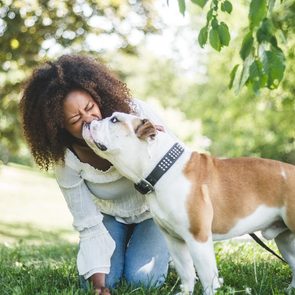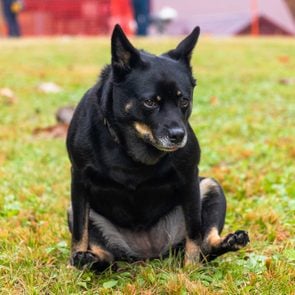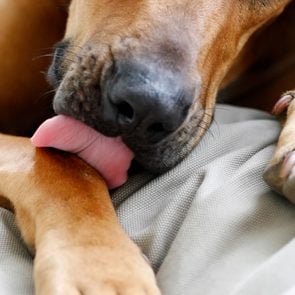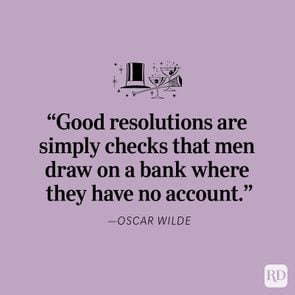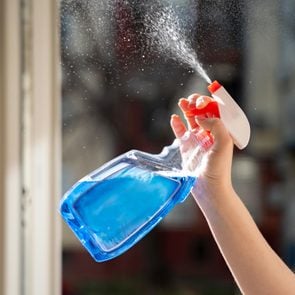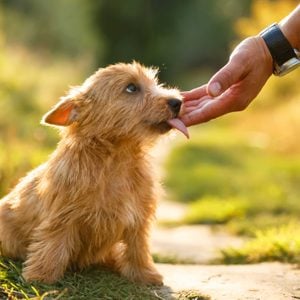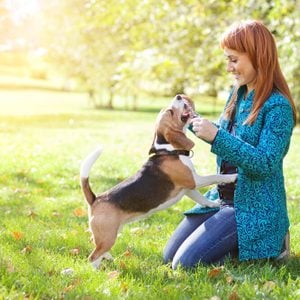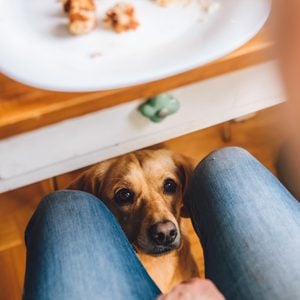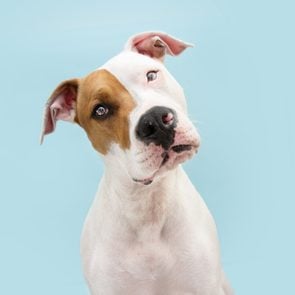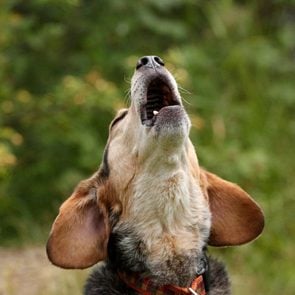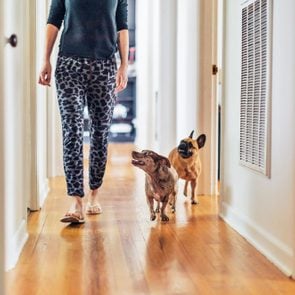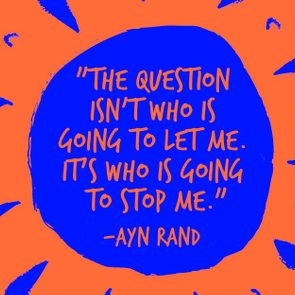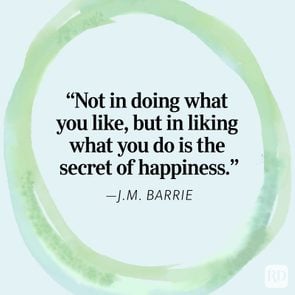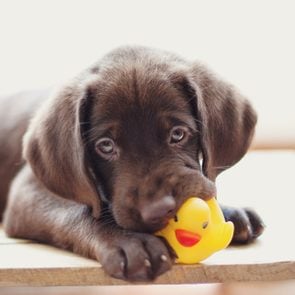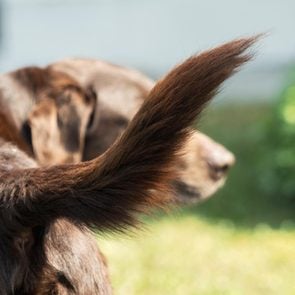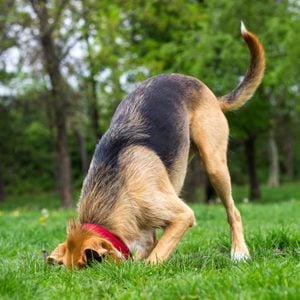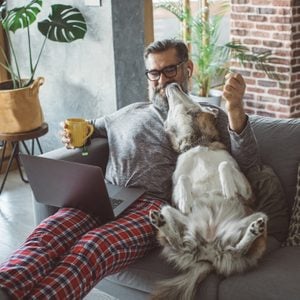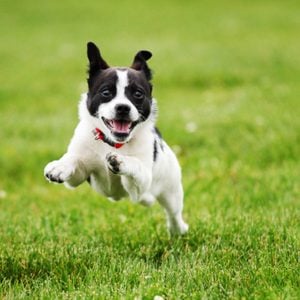Nearly all of us have a set of Corelle dinnerware in the cupboard. It may have been purchased after a ’70s kitchen update or kept on hand since the kids were born in the ’80s. (It is unbreakable, after all.) Because of that decades-long connection, it feels like a member of the family.
But that lengthy life span might also work against some of these pieces. Here’s why you should use caution when eating off of older Corelle dishes—and how you can tell whether your dinnerware is safe.
Get Reader’s Digest’s Read Up newsletter for more dining, humor, travel, tech and fun facts all week long.
It’s a problem with the paint
To understand why you might want to keep retro Corelle in the cabinet, you have to understand the manufacturing process (and how it’s changed over the past several decades). Before the FDA placed regulations on how much lead could be used in tableware, plenty of companies used paints that contained lead on their products. Those regulations came into effect only around 40 years ago, meaning that if you have a set of dishes made before 1980, there could be lead in the paint. If the paint leaches—chipping, flaking off or mixing in with the food—you might consume lead along with your meal.
We don’t have to tell you this, but lead can lead to some nasty side effects. It can be especially harmful to children, and there’s really no safe level of the stuff you can put in your body either. So while dish-related lead poisoning isn’t as serious as exposure to lead from house paints or water, those gorgeous designs on your Corelle could make you sick.
In an email posted on Lead Safe Mama, Corelle itself recommended any dishes made prior to 2005 be used for decoration only.
Do I need to throw away my Corelle dishes?
Not necessarily. Corelle products purchased after 2005 are safe and comply with FDA regulations. But if you have any older dishes, it’s a little trickier. You’ll want to avoid eating off of older Corelle dinnerware if it shows obvious signs of deterioration—for example, if the glaze is worn or the paint is melting or chipping.
To make sure you’re not consuming lead, avoid eating hot foods on the dishes or drinking hot beverages from old cups, and don’t put them in the microwave or store food in them for long periods of time.
What else can I do?
How can you be absolutely sure that your Corelle is safe to serve dinner on? Lead Safe Mama tested a few Corelle pieces. If none of those patterns look like yours and you’re not sure when your set was made, use a lead test kit. Amazon offers several options, although it should be noted that test kits are more useful for detecting high levels of lead, rather than trace amounts.
In the end, if you’re concerned, it’s probably best to put the dishes in a display cabinet and replace them with newer, safer designs.
I only just discovered that WD-40 can do so much more than fix squeaky doors—and I’ve been writing about cleaning and organizing for well over a decade. After speaking with cleaning and chemistry experts, I’m well-versed in how WD–40 Multi-Use Product, the Original WD–40 Formula works and know all of the genius WD-40 uses the pros employ. I, for one, will never be without my own can (or several) again!
WD-40 meets all of my criteria for a household cleaning product everyone should have on hand: It’s extremely versatile and inexpensive, and it both solves and prevents common problems. Ahead, you’ll learn how a WD-40 expert and a chemist suggest using the product around your house.
Get Reader’s Digest’s Read Up newsletter for more cleaning, humor, travel, tech and fun facts all week long.
About the experts
|
The history of WD-40
The name WD-40 hints at the story of how the product came to be, says WD-40 brand manager Stepan Harmanlikian. The product was invented in a San Diego lab in 1953 by Rocket Chemical Company in an effort to develop rust-prevention solvents and degreasers for the aerospace industry. “After 39 attempts, the company’s three employees finally perfected their water-displacing formula on the 40th try,” he says. That formula became WD-40 Multi-Use Product.
WD-40 has a wide variety of uses, including cleaning several notoriously difficult but common types of household messes. And there are even more surprising WD-40 uses, ranging from getting gum unstuck to detangling jewelry.
How does WD-40 work?
While the exact composition of WD-40 is such a closely guarded trade secret that the formula is locked in a California bank vault, the product’s safety data sheet notes that it contains organic solvents, propellants and mineral oil. Erika Womack, PhD, a chemist with the state of Mississippi, an associate research professor and the director of the Chemical Laboratory at Mississippi State University, explains that WD-40 works through lubrication, water displacement, rust prevention and cleaning.
“When sprayed on moving parts, WD-40 leaves behind a thin film of lubricating oil that helps reduce friction, which is useful for loosening hinges, nuts and bolts,” she says. “WD-40 also helps protect against moisture-related issues and prevent rust and corrosion.”
Since water displacement is part of WD-40’s name (yes, that’s what the WD stands for) and a big factor in how it works, it’s helpful to understand a bit more about the process. “Water displacement by the oils in WD-40 is due to the low surface tension,” Womack explains. “The molecules in oil are typically nonpolar, while water molecules are polar. This difference in polarity results in different cohesive forces between the molecules. The oil molecules experience attractive forces among themselves, and they also interact less favorably with the water molecules due to the difference in polarity.”
What does that actually mean? “When WD-40 is introduced onto the water surface, it tends to spread out and push water away due to differences in surface tension between water and WD-40,” Womack says.
Rust prevention occurs through the combination of the lubricating oil and the water-displacing properties of WD-40, which “leaves a protective barrier that inhibits the oxidation process,” she says. Lastly, the “solvents in WD-40 help break down and dissolve dirt, grime and adhesives,” which makes WD-40 an excellent cleaner in some tricky spots, Womack says.
Popular WD-40 uses
Below are the most common WD-40 uses, plus tips for making them work in your home.
Fix squeaky hinges
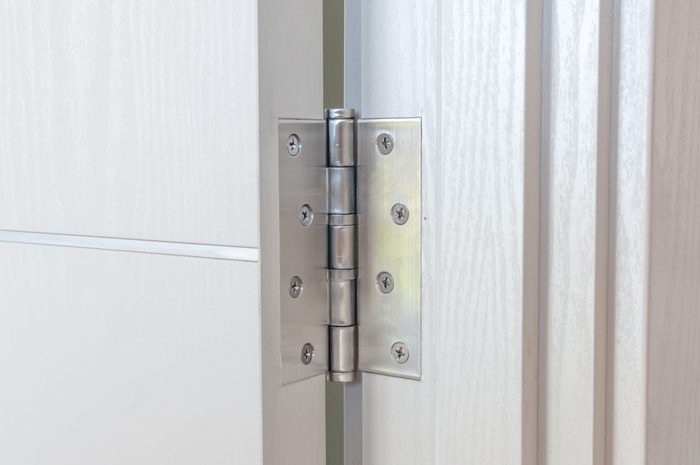
Silencing squeaky hinges is one of the most well-known uses for WD-40 and is probably the reason you have a canister of it in your toolbox. WD-40 can be used on all kinds of noisy hinges, including those on doors, ladders, folding chairs, pruning shears and more. Spray the hinge with a blast WD-40. It will be squeak-free in seconds.
Remove sticky residue
Another of the most popular WD-40 uses is removing sticky residue, such as duct tape residue left on walls or storage bins, stubborn labels on the bottom of glassware or residue from the stickers your kid used to “decorate” the back window of your minivan. To use it, spray WD-40 over the affected area, let it sit for a few minutes, then wipe it away with a cloth or a sponge.
Loosen stuck items
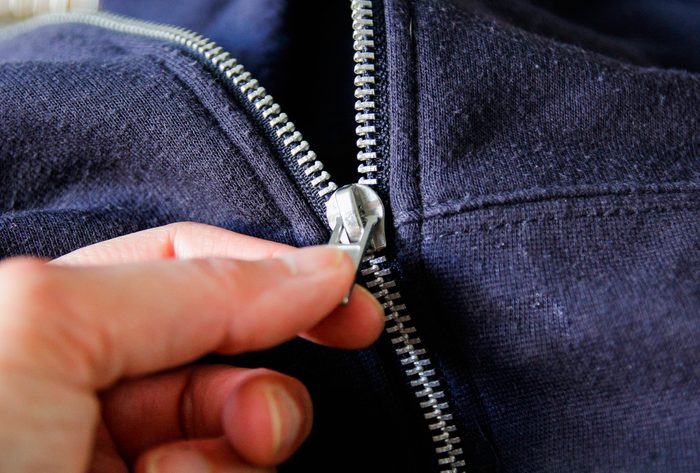
From a zipper that won’t budge to rusted-together nuts and bolts, stuck items are no match for WD-40. Simply spray WD-40 on the trouble spot and allow it to penetrate the area. A jammed zipper may need only a few seconds, while rusted-together nuts and bolts may need up to 30 minutes before they get moving again.
Maintain tools
WD-40 can clean rust and grime from the blades and tines of all your tools. Spray the metal parts of the tool with WD-40, allow it to sit for a few minutes, then wipe it clean with a rag.
Remove wax and glue from surfaces
Get wax and glue off of surfaces without scraping, scrubbing or frustration. Grab some WD-40, spray it on the affected area, allow it to sit for a few minutes, then remove the wax or glue from the surface with a rag.
Cleaning uses for WD-40
WD-40 isn’t just good for unsticking things that are annoyingly stuck. You can also use it to clean bathrooms, floors, stainless steel and more.
Polish stainless steel
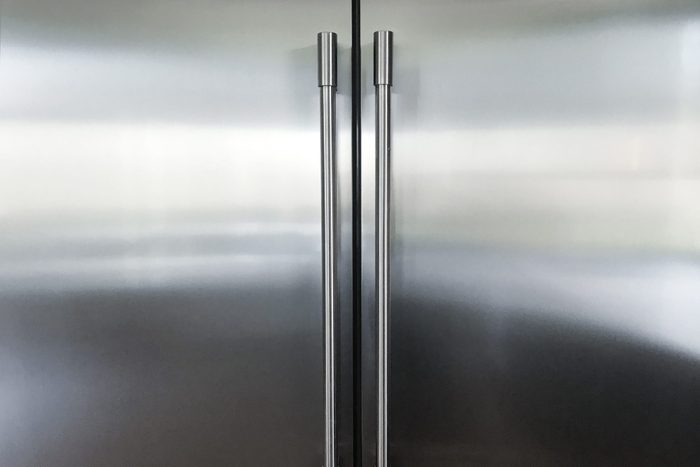
Cleaning stainless steel appliances needs to be a regular part of your cleaning schedule if you want a smudge- and fingerprint-free kitchen. WD-40 can help clean your stainless steel appliances and polish them at the same time. Spray the product onto a rag and buff it into the stainless steel, going with the grain.
Spot-treat stains and scuffs on floors
Cleaning floors is a constant chore, but WD-40 makes it easy to spot-treat scuffs and stains on your floors. Spray the product on the stained area, let it set for a few minutes, then wipe it clean with a rag. The process even works for spilled paint! Just make sure to wipe up any excess product to prevent slips and falls.
Erase crayon marks
Per Harmanlikian, WD-40 is excellent at eliminating crayon marks from just about anything, including wooden furniture, floors and walls. Spray WD-40 onto a rag and rub the affected area until the crayon mark comes off.
Outdoor uses for WD-40
As you might guess, a product that specializes in water displacement and lubrication is useful in outdoor spaces too. Read on to learn about some great WD-40 uses around the house.
Protect pipes from freezing
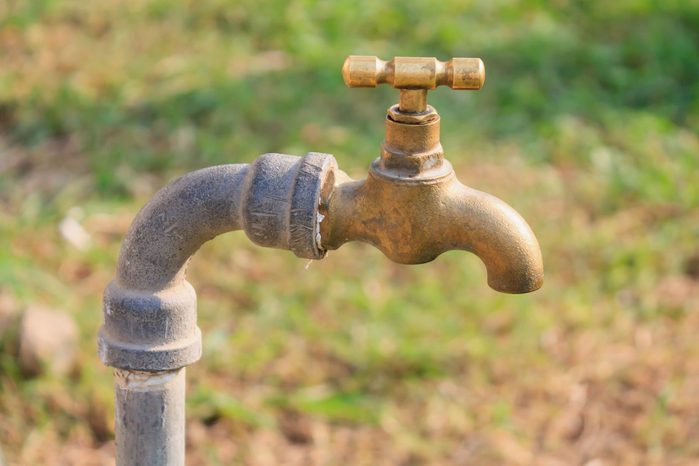
Exposed pipes can freeze in the winter, which can cause big and expensive problems if they burst. In the fall, before cold weather sets in, coat exposed spigots and pipes with a layer of WD-40 to help keep moisture from accumulating.
Prevent snow buildup on windows
Does the weather forecast predict a big winter snowstorm? You can’t stop the snow from falling, but you can prevent it from building up on your house’s windows with this genius WD-40 use. Just spray WD-40 over the outside of your windows before it starts flurrying, and the snow won’t stick.
Repel pests
Spray WD-40 on eaves to prevent wasps from building nests underneath, and use it around exterior window sills and door frames to keep spiders away. According to A-Z Animals, WD-40 repels insects by making surfaces slippery and harder for bugs and pests to grasp onto. Plus, they don’t like its odor. WD-40 also has staying power; the rain won’t wash it away, making it an effective repellant for up to a year.
Keep wooden handles on garden tools splinter-free
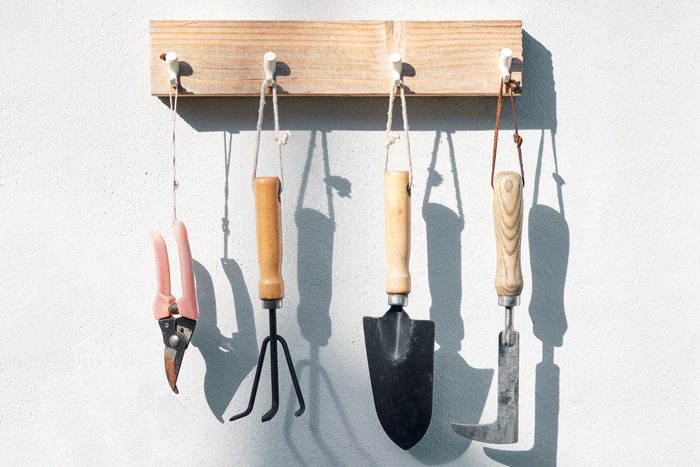
Over time, wooden handles can dry out and eventually splinter, making them not only uncomfortable but also dangerous to use. To prolong the life of your wood-handled gardening tools, refresh them with WD-40. Newer tools need only a light coating, sprayed on and rubbed in with a soft cloth. You may need to sand the handles of older tools before wiping them down with WD-40.
Winterproof boots and shoes
Here’s one of the great WD-40 uses you might not have thought of. Waterproof your winter boots and shoes by giving them a coat of WD-40. It’ll act as a barrier so water can’t penetrate the material.
You can also use WD-40 to remove ugly salt stains from boots and shoes during the winter months. Just spray WD-40 onto the stains and wipe with a clean rag. Your boots and shoes will look almost as good as new.
WD-40 uses for your car
You can use WD-40 to spruce up both the interior and exterior of your car. Just be careful not to use it on plastic bits of the car, as it may damage them.
Polish car exteriors
To remove dirt, grime and paint marks left on your vehicle by other cars, spray WD-40 on a soft cloth and wipe on trouble spots.
Make dashboards and leather shine
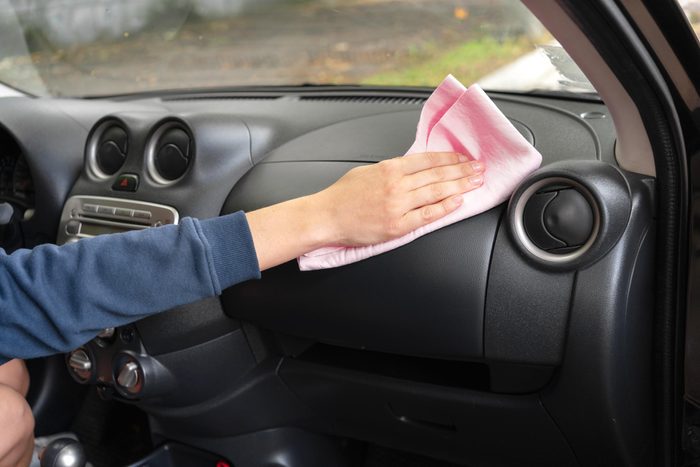
To make leather seats and dashboards gleam, spray WD-40 onto a sponge, then wipe the surfaces. Let the product set for about five minutes, then wipe it dry with a soft cloth. Double-check that your leather interior is not coated with plastic before you start spraying. If it is, avoid using WD-40 on it.
Remove bird poop
Cleaning bird poop from cars can make a bigger mess than you started with if you do it the wrong way. To clean it without having to scrape or scrub, spray the area with WD-40, allow it to sit for about a minute and then wipe or rinse it away.
Restore license plates
To help restore a license plate that is beginning to rust, spray it with WD-40 and wipe it with a clean rag. This will remove light surface rust and will help prevent more rust from forming. It’s an easy way to clean up lightly rusted plates, and it won’t leave a greasy feel.
Clean dead bugs from grilles and windshields
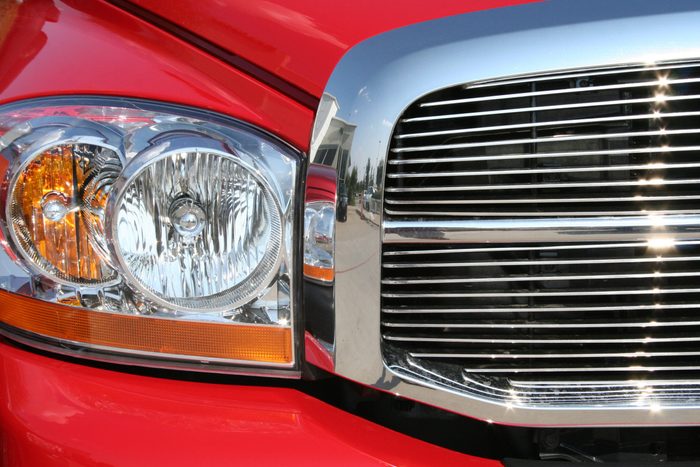
WD-40 is ideal for getting bug splatters off your car’s grille or windshield without damaging the paint. Spray affected areas with WD-40, let the product sit for up to an hour and then rinse it clean. You can also use WD-40 to remove sap and tar from your car without damaging the paint.
Clean oil spots from your driveway
Did a leaky oil pan leave a big, ugly spot in the middle of your concrete driveway? To get rid of an unsightly oil spot, spray it with a generous amount of WD-40 and then hose it down with water.
Unusual uses for WD-40
“Legend has it that police officers used WD-40 Original Formula to lubricate a naked burglar stuck in an air vent and a bus driver [used it] to remove a python from the undercarriage of a bus,” Harmanlikian shares. While you probably won’t find yourself in either of these quandaries, WD-40 has some other unusual uses that you may find applicable.
Get grease or super glue off your hands
If you’ve ever gotten some grease or super glue on your hands, you know it can feel like an exercise in futility to try to wash them with soap and water. Next time, grab some WD-40, apply the product to your palms and rub it around. Wash immediately with soap and water.
Remove gum
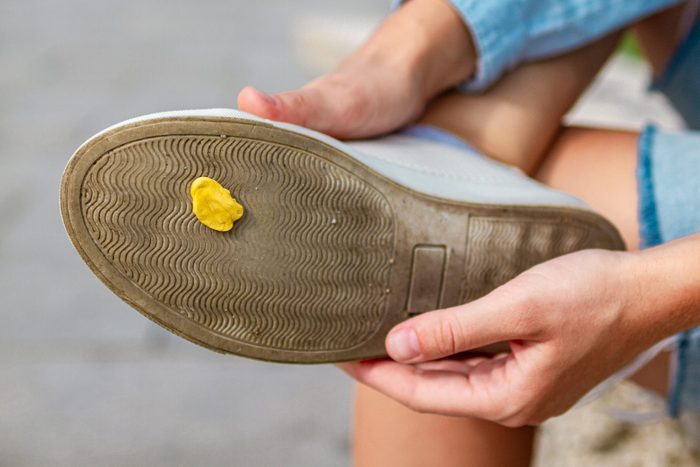
Whether gum has gotten stuck to the bottom of your shoes, the wall, the floor or even in your hair, WD-40 can help, Harmanlikian says. Spray it on the affected area, allow it to penetrate for about a minute and then ease the gum off.
Clean poop off shoes
If you stepped in a mess, remove as much of the poop as possible with a paper towel, then spray WD-40 onto the affected area of the sole of your shoe. It will help loosen the poop so you can scrub it off more easily. Bonus: WD-40 will help keep poop and other dirt from sticking to your shoes in the first place.
Disguise scratches on ceramic, linoleum, marble and wood
WD-40 can fill in scratches on surfaces, including ceramic, linoleum, marble and wood, making them appear less prominent. Spray a rag with WD-40 and buff it into the affected surface.
Condition leather
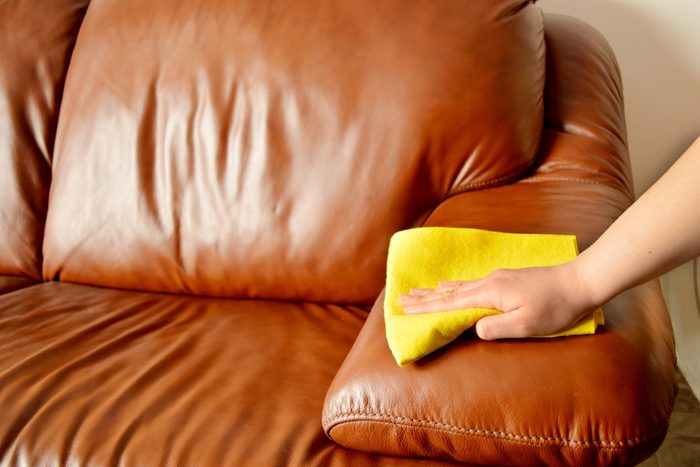
To bring a rich look back to dull or worn leather furniture, handbags or shoes, clean them with a mild solution of dish soap and water on a damp rag. Once the surface is dry, condition and polish the leather by putting a small amount of WD-40 on a rag and rubbing it into the leather.
Prevent fogging on the bathroom mirror
A thin film of WD-40 will keep your mirror clear of steam the next time you take a shower. To keep your mirror free of fog, dampen a rag with WD-40 and wipe the mirror down. Bonus: You’ll clean your mirror at the same time.
Maintain guitar strings
To clean, lubricate and prevent corrosion on guitar strings, apply a small amount of WD-40 after each use. Spray the WD-40 on a rag and wipe the rag over the strings rather than spraying directly on the strings—you don’t want WD-40 to build up on the guitar neck or body. It might seem like WD-40 is a fix-all after reading about all these uses, but there are still times when it’s better not to use it.
Untangle jewelry chains
Don’t risk breaking delicate chains as you detangle them. A spritz of WD-40 on the tangle will lubricate and loosen the knot so you can wear your jewelry again in no time.
De-grime and soften paintbrushes
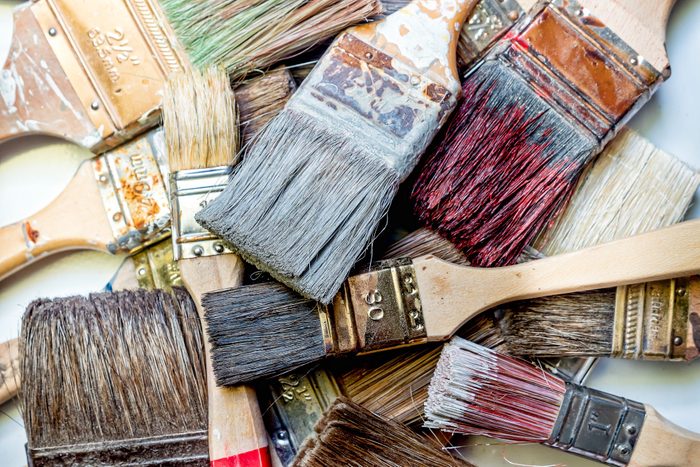
Don’t give up on that old paintbrush yet! To clean brushes, wash them in soap and water, then spray them with WD-40 to help remove stubborn paint.
To soften stiff bristles, simply spray them with WD-40 before storing them. Paint brushes preconditioned with WD-40 are also easier to clean after being used.
Loosen stuck LEGO bricks
Stuck-together LEGO bricks can ruin a good play session, but trying to pry them apart with a knife or other tool can leave marks on the pieces and, worse, injure you. Instead, apply a tiny amount of WD-40, then pull those bricks apart with ease.
Remove tight jewelry
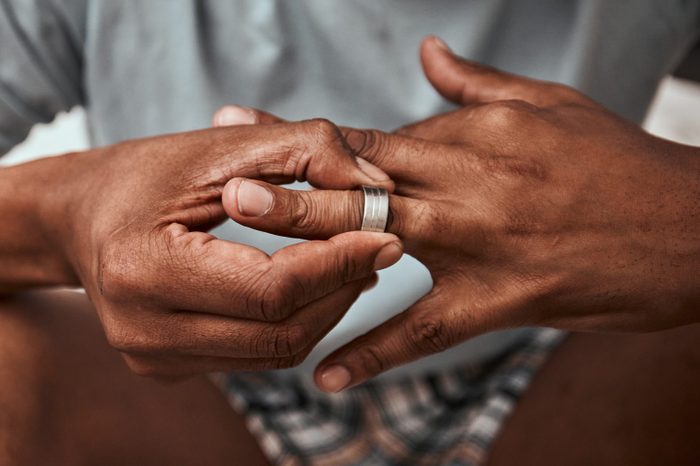
Tight rings aren’t just uncomfortable; if they get stuck, they can be painful and potentially dangerous. Spray a small amount of WD-40 onto the ring, and it should slide off. Be sure to wash your hands thoroughly with soap and water afterward.
Precautions when using WD-40
Before you break out the can of WD-40, it’s important to know the precautions you should follow when using it:
- Use it in a well-ventilated area.
- Avoid contact with your eyes.
- Avoid prolonged skin contact. Wash any skin that comes into contact with WD-40 with soap and water.
- Keep WD-40 away from flames and heat sources, as it’s flammable.
- The contents of a WD-40 can are under pressure, so take care not to puncture the can.
How not to use WD-40
While WD-40 Multi-Use Product has many uses in daily life, it’s important to take note of the times when you shouldn’t use the original formula, including spraying on electronics, plastics, locks or exposed hardware, such as outdoor gate hinges. That said, Harmanlikian points out that there are some special formulations of WD-40 that may be better suited to these uses.
Why trust us
At Reader’s Digest, we’re committed to producing high-quality content by writers with expertise and experience in their field, in consultation with relevant, qualified experts. For this piece, Shifrah Combiths tapped her more than a decade of experience as a cleaning writer. Then cleaning expert Ann Russell, TikTok’s “cleaning auntie” and the author of How to Clean Everything, gave it a rigorous review to ensure that all information is accurate and offers the best possible advice to readers. We relied on reputable primary sources, including cleaning and health experts and reputable organizations. We verified all facts and data and backed them with credible sourcing, and we will revisit them over time to ensure they remain accurate and up to date. Read more about our team, our contributors and our editorial policies.
Sources:
- Stepan Harmanlikian, WD-40 brand manager; email interview, Jan. 5, 2024
- Erika Womack, PhD, Mississippi state chemist and associate research professor and director of the Chemical Laboratory at Mississippi State University; email interview, Feb. 26, 2024
- WD-40: “Safety Data Sheet”
- WD-40: “List of 2000+ Uses”
There are so many things to think about when you’re looking for a new canine companion. Dog behavior, size, age, grooming needs and activity level are all important, but what about male vs. female dogs? Is a dog’s sex something else you should take into consideration before making your decision?
Having been a veterinarian for more than 25 years and a dog parent for even longer, I’ve gotten to know thousands of dogs. Some have conformed to gender stereotypes, while others have not. For example, conventional wisdom says that male dogs are more affectionate than females, and yet, the most affectionate dog I’ve ever had the pleasure of knowing was a male mixed breed named Owen. He followed me everywhere and was simply the most adoring dog you could ever hope to meet. On the other hand, male dogs are also supposed to roam more than females, but it was my female terrier mix, Annie, who simply wouldn’t be fenced in. This little escape artist came to me as a stray, broke out of my well-fenced yard on multiple occasions and loved nothing more than to explore as many mountainsides as possible when we were on hikes together.
But are there some general truisms about male and female dogs? Ahead, we’ll explore what research and anecdotal evidence have to say about the importance of a dog’s sex.
Get Reader’s Digest’s Read Up newsletter for more pets, humor, cleaning, travel, tech and fun facts all week long.
| Reviewed for accuracy by: Wailani Sung, DVM, a vet with a board certification in veterinary behavioral medicine who owns Bay Area Vet Behavior. Dr. Sung is the co-author of From Fearful to Fear Free: A Positive Program to Free Your Dog from Anxiety, Fears and Phobias. |
Does a dog’s sex matter?
Yes and no. Scientific research looking at groups of dogs has found some meaningful differences between males and females, but results like these become almost meaningless if you are interested in the characteristics of a specific dog. For example, spaying female dogs may sometimes lead to increased aggression. However, that spayed female pup you meet at the shelter might be the sweetest thing ever and want nothing more than to sleep in your bed every night. The bottom line: The characteristics of an individual dog are far more important than generalities about their sex. Spending time with a dog, ideally in a variety of situations, is the best way to get a feel for whether its personality will be a good match for you.
Personality differences between male and female dogs
With that said, sex hormones can play some role in shaping a dog’s personality and behavior. Spaying and neutering have a big effect on a dog’s hormonal levels as well, though: Dogs that have been spayed or neutered, particularly at a young age, will usually have fewer hormone-related behaviors.
Personality of male dogs
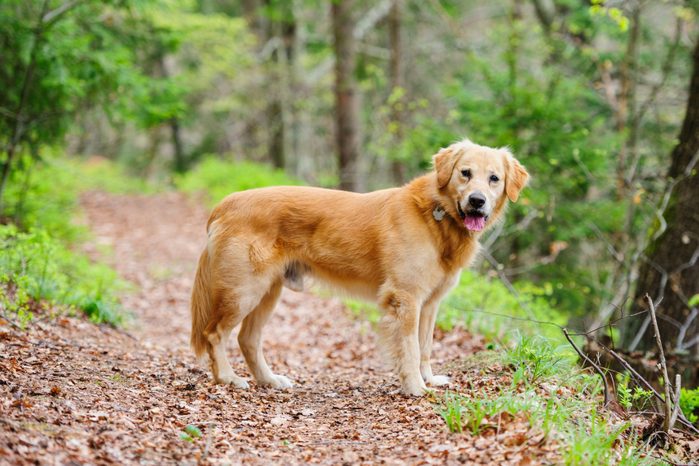
Male dogs that have not been neutered have high levels of testosterone, and testosterone is associated with the problematic behaviors most commonly seen in male dogs. Of course, testosterone isn’t all bad, and it may also play a role in some of the more endearing traits of male dogs.
- Male dogs like to roam. The wild ancestors of dogs were frequently on the move. Males, in particular, had to roam large distances to find mates and defend their territories. This desire to get out and explore is often most evident in intact (non-neutered) male dogs and can lead to problems like getting into dog fights, becoming lost and getting injured.
- Intact male dogs may be more aggressive. In their quest to find a mate, male dogs often have to fight other male dogs. These aggressive tendencies can spill into other parts of their lives, including in their interactions with people. Several studies, including one published in the journal Nature in 2021, have shown that aggression tends to be more common in male vs. female dogs.
- Humping is a bigger problem in male dogs. Humping isn’t always a sexual act in dogs. It’s often just a way to communicate or get attention, or a sign of emotional arousal. That said, male dogs do tend to hump more than females. Dogs can hump other dogs, people and even inanimate objects, which may lead to some awkward conversations!
- Territorial behaviors are more common in males. Male dogs tend to urinate on objects in their environment to mark their territories, which is basically a way of saying, “This area is mine—stay away.” All those stops to pee can make walks slow and more than a little frustrating, but this behavior does have an evolutionary basis. Sometimes the marking behavior can move indoors, which is why you might be looking up how to get dog pee out of your carpet and other surfaces more often than you’d like.
- Male dogs may be more affectionate. People often say that male dogs are more affectionate than females, but there hasn’t been any research to show whether this is actually the case. Of course, it’s the individual’s personality that matters most, but for what it’s worth, my male dogs have always been more willing to dole out the kisses than my females. Many pet parents also say that their male dogs are more active and playful than their female dogs.
Personality of female dogs
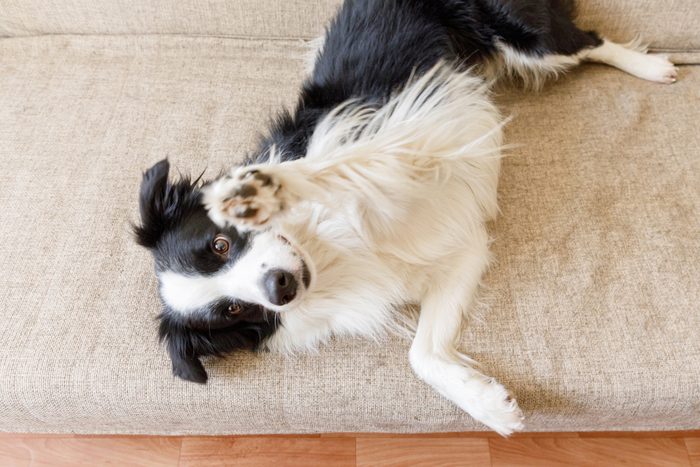
The hormones estrogen, progesterone and oxytocin are all critical to a female dog’s heat cycle and ability to become pregnant and raise a litter of puppies. They may also play a role in some of the personality traits and behaviors that are thought to be more typically female.
- Female dogs tend to be calmer than males. While there haven’t been any scientific studies on the subject, female dogs are often said to be calmer than males. Maybe raising pups requires a degree of level-headedness that male dogs, who aren’t so involved in the upbringing of their offspring, don’t need.
- Female dogs may be easier to train. One study published in Royal Society Open Science in 2017 found that female dogs scored higher than male dogs on measures of obedience, which should make them easier to train. And if female dogs truly are calmer than males, they may be better able to focus on what’s being taught rather than being distracted by every squirrel that runs by.
- Unspayed female dogs need to nurture. After an unspayed female dog goes through her heat cycle, she experiences all the hormones associated with pregnancy, even if she’s not carrying pups! This means that about two months after her heat cycle is over, you might see your dog getting ready to take care of puppies. She may even build a nest. These nurturing tendencies can surface at other times as well, such as when she gently carries a stuffed animal around in her mouth or comforts you when you’re upset.
- Loyalty is a trait often associated with female dogs. In my experience, male and female dogs are both capable of intense loyalty. Nevertheless, females tend to have higher levels of oxytocin, the hormone that promotes bonding between mothers and their offspring, which may explain why female dogs are sometimes said to be more loyal than males. But according to a study published in Science in 2015, you and your female or male dog can experience higher oxytocin levels simply by staring into each other’s eyes.
Health differences in male and female dogs
Dogs of one sex aren’t necessarily healthier than the other, but certain health problems are more common in male vs. female dogs. Of course, conditions that affect the reproductive tract will vary, but there are some surprising differences as well. I can’t explain why, but every dog that I’ve treated for gastric dilatation and volvulus (a potentially fatal twisting of the stomach) has been a male.
Health of male dogs
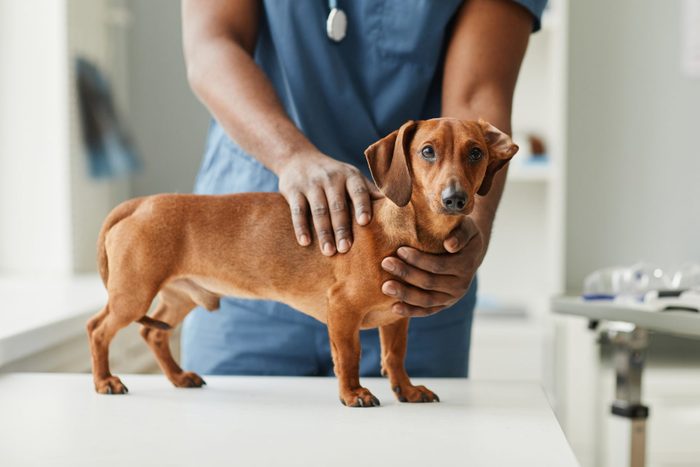
Male dogs are prone to certain health problems because of their anatomy and hormones. Knowing which diseases are most common in your dog will help you know what symptoms to watch for.
- Testicular tumors can develop when male dogs aren’t neutered. Tumors involving the testicles are the most common form of reproductive-tract cancer in male dogs. Most tumors develop later in life and are malignant, although neutering can cure the condition if it’s caught early enough. Neutering is also the best way to prevent testicular tumors in dogs.
- Prostate-gland diseases are common. The prostate gland may cause problems, particularly as dogs age. Benign prostatic hyperplasia (BPH) is the most common prostate disease and usually affects older, intact male dogs, but infections, cysts and cancer are also possible. How will you know if your dog has a prostate issue? These diseases cause the gland to enlarge, which may make it hard for the dog to pee and poop.
- Tumors around the anus can cause trouble. High testosterone levels increase the risk that a dog will develop a type of tumor called a perianal gland adenoma. Most of these tumors are benign, but they may need to be removed to prevent infections; if they get large enough, they can also block the normal passage of poop, causing dogs to strain or poop small amounts more frequently than is normal.
- Male dogs have more inherited joint problems. Perhaps it’s because they tend to grow faster and larger in comparison to females, but male dogs are more likely to develop symptoms associated with joint problems that they inherit from their parents. For example, elbow dysplasia is more common in male vs. female dogs, and while hip dysplasia affects both sexes equally, the condition tends to progress more quickly in males. Affected dogs often develop arthritis in their affected joints, sometimes at a very young age.
Many of these health problems can be prevented by neutering male dogs, but a few actually become more likely, particularly in certain breeds, if dogs are neutered before they have fully matured. For example, it’s best not to neuter male golden retrievers until after they are 1 year old because dogs who are neutered before this time have an increased risk of cancer and joint problems. A veterinarian can help you determine the best time to neuter your dog.
Health of female dogs
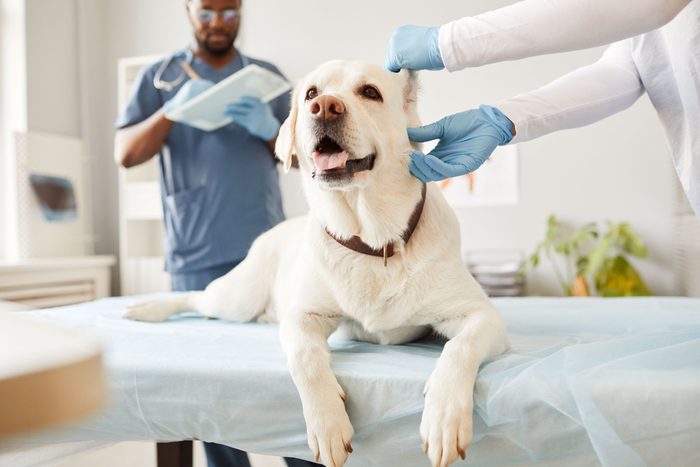
Health problems affecting the ovaries and uterus obviously only affect female dogs, but other conditions are more likely as well if your dog is a female—particularly if she isn’t spayed or was spayed later in life.
- Mammary tumors are common in unspayed female dogs. Because of the effects of estrogen, both benign and malignant mammary (breast) cancer is much more common in female vs. male dogs. Get your dog seen by a veterinarian whenever you notice a lump or bump, because early treatment yields the greatest chance of success. Spaying a dog before she has gone through her first heat cycle almost eliminates the risk of mammary tumors, but this protection disappears after she has gone through two heats.
- Uterine infections can be deadly. A female dog’s uterus can become infected and filled with so much pus that it ruptures. This condition is called pyometra, and it develops because of the hormone changes that dogs go through after every heat cycle. Spaying a dog will block these hormonal shifts and also prevent pyometra. Up to 25% of unspayed female dogs will develop this condition during their lives.
- Female dogs can develop ovarian cancer. Spaying a dog involves removing her ovaries, so her risk of ovarian cancer is eliminated after the surgery. Ovarian cancer can be benign or malignant, but luckily, it isn’t very common, probably because most pet parents elect to spay their dogs before the condition has a chance to develop.
- Urinary tract problems are common. The female urethra is short and wide, giving bacteria easier access to the bladder and increasing the risk of a urinary tract infection. Signs of a urinary tract infection can include experiencing discomfort when urinating, producing small amounts of urine frequently and having accidents in the house. And while spaying helps prevent many health problems in female dogs, some will leak urine after being spayed. Thankfully, medications will usually improve the situation.
A veterinarian can help you figure out if and when your female dog should be spayed based on their breed and overall health status.
FAQs about male vs. female dogs
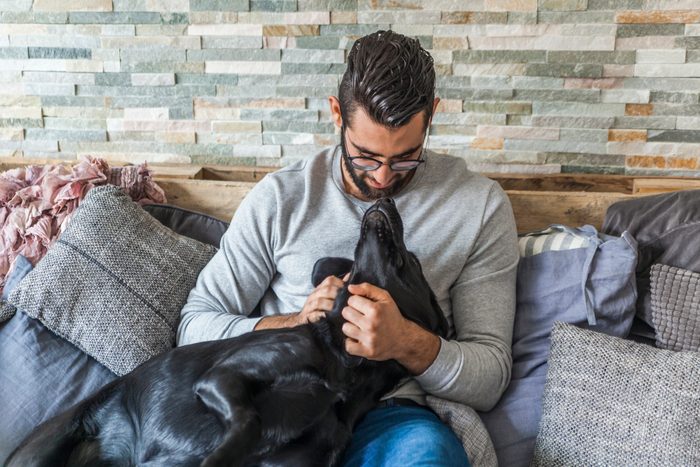
Are male dogs more affectionate?
Male dogs have a reputation for being more affectionate than females, but in truth, you can find many extremely affectionate female dogs and some male dogs who prefer to be left alone. What’s most important is the individual dog’s temperament. Some breeds also tend to be more affectionate than others.
Do female dogs prefer female owners?
Not necessarily. Both female and male dogs feel more comfortable with the types of people they’ve had positive experiences with in the past. So if a female dog had been cared for by a loving female owner, they probably would prefer females, but the same thing would apply to a male dog who had previous good experiences with women.
Are male or female dogs better for emotional support?
Both females and males can be wonderful emotional support dogs; it really depends on the traits you’re looking for. Conventional wisdom says that female dogs may be calmer and more loyal, while males may be more outwardly affectionate, but these are only generalizations and do not apply in every case.
Are female dogs less aggressive?
Studies have shown that, in general, female dogs are less aggressive than males. However, any dog can act aggressively when they are frightened or put in situations that they find threatening.
Are female dogs more loyal?
You’ll often hear people say that female dogs are more loyal than males, but in my experience, both males and females can be incredibly loyal. An individual dog’s personality and how they have been treated by the people around them are far more important than their sex in determining how loyal they will be.
Are male dogs harder to potty train?
There isn’t much of a difference when it comes to potty training male or female dogs. Both sexes require close monitoring, frequent trips outside and lots of positive reinforcement while they are being potty trained. Putting your dog in a comfortable crate when you can’t keep an eye on them can help immensely. However, marking can be a hard habit to break, and it is more common in males than females. Get advice from your veterinarian as soon as possible if your dog likes to pee on everything they see.
Do dogs prefer male or female owners?
Some dogs seem to prefer women over men, probably because traits that are more typically female (a higher voice, for example) are less threatening and more appealing to dogs. However, other dogs prefer men, particularly if they’ve had good experiences with them in the past or if they’ve had bad experiences with women.
Why trust us
At Reader’s Digest, we’re committed to producing high-quality content by writers with expertise and experience in their field in consultation with relevant, qualified experts. For this piece, Jennifer Coates, DVM, tapped her experience as a veterinarian with more than 25 years of professional experience, and then Wailani Sung, DVM, DACVB, PhD, a veterinarian specializing in behavioral medicine and the co-author of From Fearful to Fear Free: A Positive Program to Free Your Dog from Anxiety, Fears and Phobias, gave it a rigorous review to ensure that all information is accurate and offers the best possible advice to readers. We verify all facts and data, back them with credible sourcing and revisit them over time to ensure they remain accurate and up to date. Read more about our team, our contributors and our editorial policies.
Sources:
- Nature: Scientific Reports: “Aggressive behaviour is affected by demographic, environmental and behavioural factors in purebred dogs”
- Royal Society of Open Science: “Assessment of owner-directed aggressive behavioural tendencies of dogs in situations of possession and manipulation”
- Science: “Oxytocin-gaze positive loop and the coevolution of human-dog bonds”
- BMC Veterinary Research: “Prevalence of commonly diagnosed disorders in UK dogs under primary veterinary care: results and applications”
- Frontiers in Veterinary Science: “Assisting Decision-Making on Age of Neutering for 35 Breeds of Dogs: Associated Joint Disorders, Cancers, and Urinary Incontinence”
Learning how to clean your dog’s teeth helps prevent bad breath and tooth pain. But just because dogs won’t naturally open wide and say “ahh,” doesn’t mean you need to turn to a professional every time their teeth need brushing. At-home dog-teeth cleaning can save you major vet costs and even extend your dog’s life (periodontal disease affects the whole body, after all).
As a certified animal behavior consultant, a Fear Free–certified trainer and author of more than 35 pet-care books, I’ve written about and taught cooperative dog-handling tips for more than 30 years. And like your pets, my dog doesn’t automatically accept invasive handling without lots of preparation. Without training, pups dive under the bed, run away or struggle—even if you know how to groom your dog. And the process can break your heart—nobody wants their dogs to be scared.
But never fear. With the help of board-certified veterinary dentist Naomi Hoyer, DVM, I’ve created the ultimate guide to cleaning your dog’s teeth. With the doggy dental tips and tricks below, you can ensure your pup’s teeth get clean. My pets come running for tooth care now—and yours can too.
Get Reader’s Digest’s Read Up newsletter for more pets, humor, travel, tech and fun facts all week long.
About the experts
Reviewed for accuracy by: Wailani Sung, MS, PhD, DVM, DACVB, a board-certified veterinarian and veterinary behaviorist who is the owner of Bay Area Vet Behavior. |
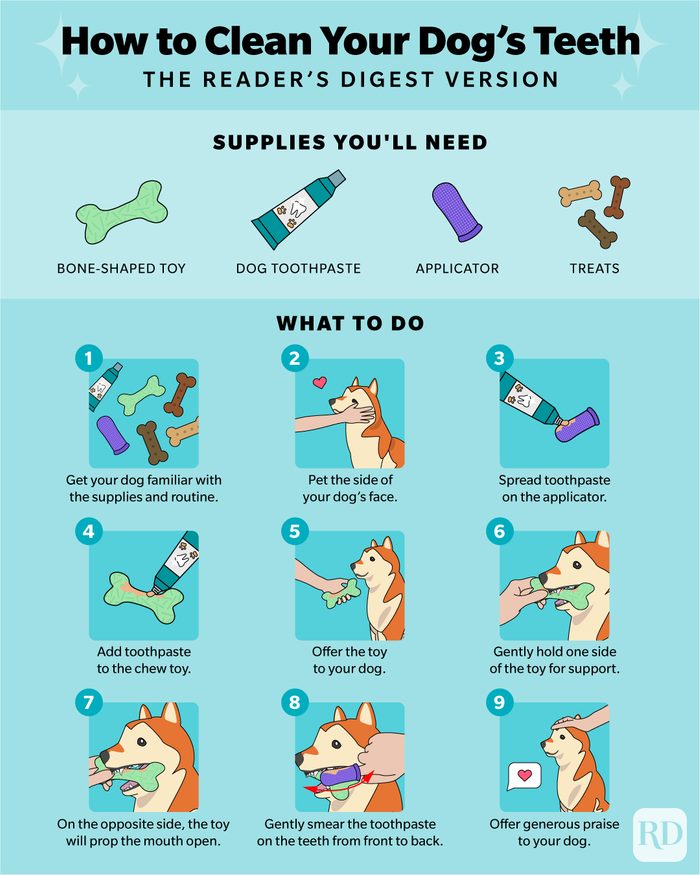
Why is it so important to brush your dog’s teeth?
According to Dr. Hoyer, learning how to clean your dog’s teeth is the best way to control plaque accumulation and prevent dental disease. “Plaque mixes with the minerals in saliva and is known as calculus [tartar] and then is very challenging to remove from teeth.”
And because tartar (the yellow or brown spots you notice on your pup’s teeth) impacts whole-body health, brushing teeth is necessary to prevent additional problems that could cut your dog’s life short. The same bacteria found in a dog’s mouth with dental disease is often implicated in endocarditis, an inflammatory heart disease, according to VCA Animal Hospital experts. The liver and kidneys also are affected by oral bacteria, because these organs filter bad stuff out of the blood.
“Dental disease is the most common disease in our small animal patients (both dogs and cats),” says Dr. Hoyer. “Greater than 70% of dogs more than 3 years of age have some form of dental disease. All dogs, no matter the breed can develop dental disease.”
Besides tooth loss and painful chewing, you may notice a variety of dog illness symptoms in pups with dental disease, including fever, weight loss and loss of appetite.
Also Check: Sweet puppy breath is a fleeting joy. But what causes it and how long can you expect it to stick around?
How often should you brush your dog’s teeth?
Ideally, you should brush your dog’s teeth daily, says Dr. Hoyer. But when you have a busy schedule like I do, it proves challenging to brush a dog’s teeth after every visit to the food bowl. “If the goal is to reduce calculus (mineralized plaque), then you need to brush at least three times per week,” says Dr. Hoyer. Even a couple of times a week improves a dog’s oral health—any amount of dog-teeth cleaning works better than doing nothing at all.
Start brushing your dog’s teeth as a puppy. Youngsters more easily accept tooth brushing as normal—they don’t know any better, and their smaller size makes them easier to manage. Adult dogs may object to the intrusion, but they still can learn to accept tooth care. Cleaning your dog’s teeth is part of grooming and is as important as giving your dog a bath.
How to get your dog comfortable with teeth cleaning
You already know how to brush your own teeth, and the same technique actually applies to cleaning your dog’s teeth. But a vital part of cleaning a dog’s teeth includes teaching them what to expect, so they won’t feel scared. Remember: Teaching any dog takes time. Don’t rush or force your pet. It may take three days or three weeks before a dog will let you clean its teeth. Once a dog understands and accepts the procedure, the teeth cleaning won’t take more than a few minutes. Before you even bring out the toothbrush, take time to train your dog on its new teeth-cleaning routine. Here’s how to get your dog comfortable with teeth cleaning.
Step 1: Schedule training
Dogs love routine, so cleaning your pet’s teeth in the same location and at the time each day can help your furry friend view teeth cleaning as part of a normal day.
Step 2: Signal tooth time with a towel
Until your dog learns to accept you brushing its teeth, things can get messy. A towel helps contain any mess and also lets your dog know what to expect. That can comfort a shy or fearful dog too. For a small dog, spread the towel on your lap. This helps you control the interaction better, as it will feel similar to a snuggle session. For big dogs, lay the towel on the floor and kneel next to your pup, with the dog between your knees, facing out.
Step 3: Touch your dog’s mouth
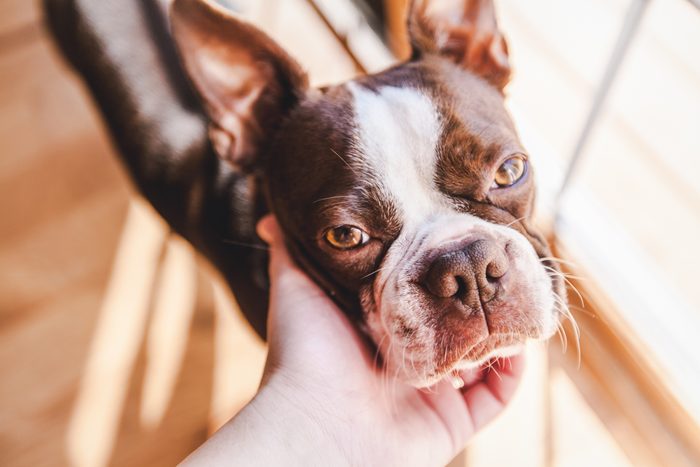
Start by petting the side of your pup’s face, paying particular attention to the outside of their mouth and lips. If you feel comfortable, allow mouthing, which is when a dog puts its teeth and mouth over a person’s skin while using little or no pressure from the jaws. This way, you can easily touch the outsides of the dog’s teeth. Do this for five minutes and offer a treat each time your dog lets you stroke their gums or touch a tooth. Repeat this step once or twice a day for three to five days. After the dog accepts your handling of its mouth, move on to using toothpaste.
Step 4: Teach with a tasty toy bone
Spread dog toothpaste on a non-fabric toy, such as a rubber chew bone. Choose a large chew bone that the dog can comfortably grasp. (It should also be big enough to extend out each side of the mouth and keep the jaw slightly open.) Let your pup lick off the paste—many dogs enjoy flavored pet toothpaste like a treat. Canine toothpaste includes ingredients that help clean teeth even without brushing, so that’s a great first step. You want to associate the toy with the yummy flavor.
Step 5: Offer a toothpaste-coated toy bone
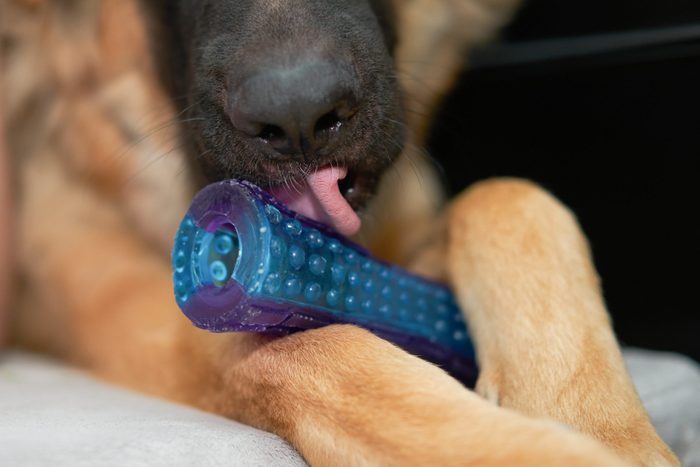
If your dog wants to take the toy into its mouth, that’s great! As the dog takes the toy, say, “Open.” That teaches the cue word and essentially trains the dog to open wide on its own, so there’s no need for scary unproductive wrestling. Eventually, you’ll only need to say the word to prompt the dog to take the toy.
Step 6: Gently hold one side of the toy for support
When your dog has the bone in its mount, hold one side of the toy steady and in place with one hand. That way, the flavored toy props the mouth slightly open enough to offer a gap in which to begin brushing with the other hand. Never squeeze the dog’s muzzle. And keep in mind that dogs are sensitive about toys in their mouth, which makes this an important training step. Ideally, once trained, your dog will know to take the flavored toy into its mouth and allow you to gently hold the toy steady to administer the toothpaste.
Step 7: Get your dog comfortable with the toy routine
Reserve this special toy for teeth cleaning so your pet only gets the yummy paste and other treats for this purpose—they’ll look forward to the fun. When you start out, spend about five minutes playing with the toy, taking it from your dog to add paste. Say, “Open,” to cue your dog to take the toy. Say, “Drop it,” for a release. Praise after each time and reward with a treat. Repeat this step once or twice a day for several days in a row.
Step 8: Introduce the applicator
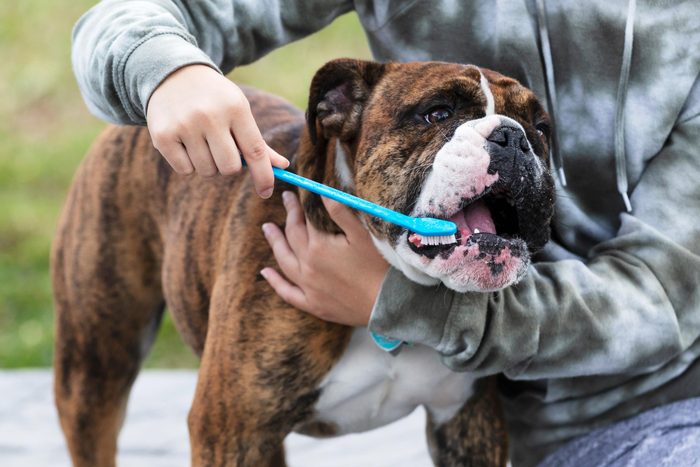
Once your dog accepts the above steps, introduce the applicator of your choice. You must feel comfortable using it or your dog will sense your stress and feel equally uneasy. You can do this! Choose a finger toothbrush, doggy toothbrush or gauze-wrapped finger. Let them sniff your application of choice first. Then add the toothpaste. While holding the toy bone propped inside the dog’s mouth with one hand, use your other hand to slip the toothpaste-loaded applicator inside the dog’s lips. Leave it only a few seconds, then remove and release the dog’s toy bone as you say, “Drop it.” Used consistently, your dog will learn to drop it when you ask.
Step 9: Praise your dog
Give extravagant praise as your dog licks their lips. And congratulate yourself, too. Follow up immediately with a favorite treat or game to reward your dog’s extraordinary intelligence and tolerance. Once your dog acts excited at the sight of the towel, toy and paste, you can move on to routine dog-teeth cleaning.
How to clean your dog’s teeth
I recommend training your dog to accept the process well before you start brushing the teeth. Set aside at least a couple of weeks for preparation and training. Dogs can’t learn when scared, so strive to make the experience pleasant with lots of rewards (treats, cuddling, praise, games—whatever your dog loves). Even the best-natured dogs may growl or snarl when they don’t understand what you want, feel scared or are accidentally hurt. Stop immediately if this happens! That growl or snarl warns you to stop, so feel grateful that dogs communicate with us—and listen to them.
It’s best to begin brushing a dog’s teeth before problems develop. For adult dogs, have your veterinarian provide a professional cleaning first, if needed, so you can maintain the healthy start. Otherwise, dogs won’t want you touching sore, painful gums. I also highly recommend using the rubber bone or toy prop because it gives your dog something to chomp besides your fingers and prevents an accidental bite, which can do major damage.
And pro tip: Don’t touch inside the mouth (behind the teeth). Because the tongue keeps the inside surface of the teeth clean, you only need to clean the outside surface, so don’t risk fingers poking inside the mouth!
Supplies you’ll need
Bring everything you plan to use to the location you’ll be cleaning your dog’s teeth. You may want to keep teeth-cleaning tools in the same place as your other grooming supplies. Your pup should eventually enjoy the experience and expect the event. To speed up the process, choose somewhere your dog already associates with fun times or yummy rewards, like in the kitchen near the food bowl.
- Chew toy: A rubber bone-shaped dental toy works great, sized large enough so that the ends stick out of the dog’s mouth on each side when held. Dental toys usually have nubs that help clean teeth as the dog chews or that hold dog toothpaste.
- Bath towel: A towel provides an easy-to-clean surface for training and eventual teeth cleaning. Using the same towel each time signals to your dog what happens next.
- Dog toothpaste: Never use human toothpaste with your dog. Dogs can’t spit and shouldn’t swallow the fluoride that human products contain. Dogs also hate the foaming action. Don’t use baking soda, either, as the high alkalinity can upset canine tummies when swallowed. Instead, choose a toothpaste designed specifically for dogs. Pet toothpaste comes in flavors that dogs love, like chicken.
- Applicator: Choose a tool you feel most comfortable using. A dog toothbrush, finger toothbrush that slips over your finger or a disposable gauze pad that slips over your finger all work well to spread the toothpaste.
- Bonus rewards: Dogs liked getting “paid” for being good, just like humans enjoy a bonus for a job well done. If your dog loves treats, offer dental treats after the session. Or if a play session or car ride prompt bigger wags, “pay” your dog with the preferred reward.
Step 1: Prepare the applicator with toothpaste
Whether you’re using a finger toothbrush, gauze pad or dog toothbrush, you’ll want to spread dog toothpaste onto the brushing material. You won’t need a lot of paste, so just add enough to cover the end of your finger.
Step 2: Add toothpaste to the rubber chew toy
Spread dog toothpaste on your chosen chew toy. Since you’ve already taught your dog what the yummy-flavored dog toy means, this signals to them that more treats will come.
Step 3: Offer the rubber chew toy
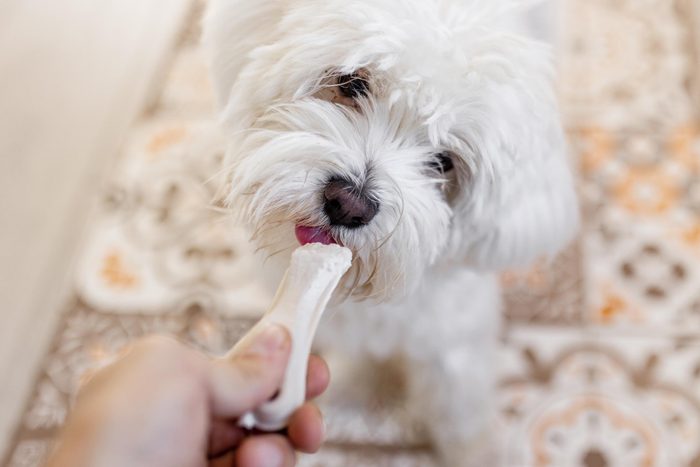
Gently stroke your dog’s face and muzzle in preparation for inserting the toy bone. Say, “Open,” and praise when the dog grasps the toothpaste-covered toy.
Step 4: Hold the toy in place
As your dog closes its mouth around the toy, hold it in place with one hand. Avoid squeezing the muzzle. Your hand should support rather than restrain the dog in this position. For small dogs, it can help to kneel on the floor with your pup between your knees, facing out, so they can’t wiggle away. Holding the toothpaste-coated toy in place should offer a gap in which to begin brushing.
Step 5: Clean one side of the teeth first
With one hand wrapped around the opposite side of the dog’s toy, use the toothpaste-covered applicator to wipe the outside of the dog’s teeth on one side of its mouth. Do the top jaw first, and if your dog is still fine with it, finish with the bottom teeth on the same side. You don’t need to scrub—simply wipe the paste from side to side. Start out with a brief front-to-back (or back-to-front) smear of paste on the sides of the teeth, whichever feels most comfortable for you. Then release and remove the toy. The dog will lick lips and savor the paste you’ve left on the teeth. When you’re first starting out, be satisfied with one side and a quick smear. Then quit for the day.
Step 6: Clean the other side of the teeth
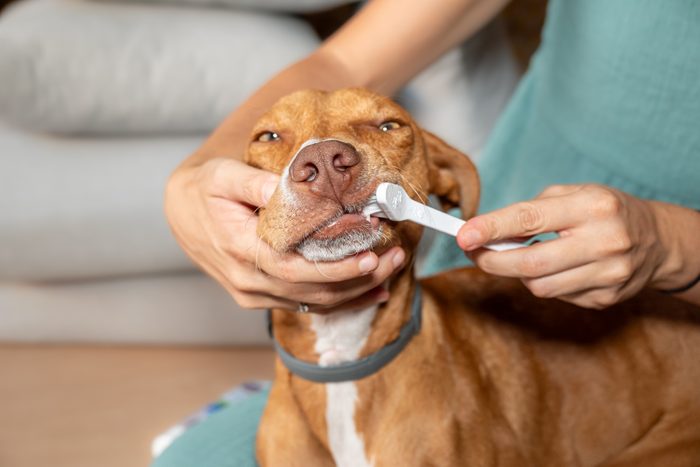
The next day, repeat the previous steps. This time, you’ll clean the teeth on the other side of your dog’s mouth. Remember, there’s no need to clean the inside of the teeth since the dog’s tongue keeps those surfaces clean. Just wipe the outside of the teeth. As your dog builds up tolerance, and you become more comfortable, you can spend more time gently rubbing the teeth back and forth. Again, you’re not scrubbing hard. You want the process to feel gentle and safe.
Step 7: Offer generous praise
Always quit before your dog asks you to stop; it’ll leave your pup wanting more. Then offer praise to your happy dog and treat generously.
Step 8: Move on to cleaning both sides
After two weeks of alternating one-sided teeth cleanings, your dog should understand the process. Hopefully, it also looks forward to this teeth-cleaning routine. Now it’s time to graduate to cleaning all of the teeth at once. This shouldn’t take more than five minutes, including preparation time. If possible, brush daily.
What else keeps a dog’s teeth clean?
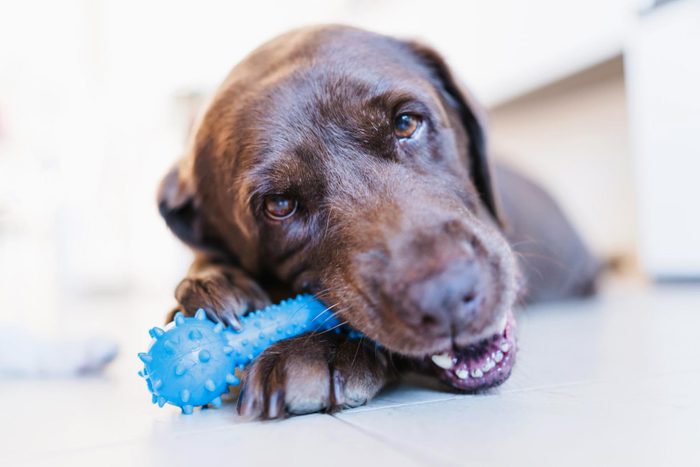
Let’s face it, some dogs refuse to put up with teeth-brushing no matter how slowly and well you train. It’s not worth risking a bite or damaging the relationship you have with your dog. While brushing is ideal, rather than force the issue, there are other ways that help keep your dog’s teeth clean. “If brushing isn’t an option, then other modalities, such as dental diets and dental chews, can be used,” says Dr. Hoyer. “But they aren’t as good as brushing.” Here are some options.
- Dental food: Dogs evolved to gulp and gorge, not to chew. The detergent action of scrubbing teeth by chewing up healthy treats, such as apples and carrots, can help but not as much as we’d like. Thankfully, today we have special foods designed to help reduce or prevent the formation of tartar and plaque. The Veterinary Oral Health Council endorses certain supplements, rinses, pastes and treats that have met this criteria. Look for products that include the VOHC seal of approval and ask your veterinarian for a recommendation.
- Chew toys: Dogs love to chew. Besides the edible chews and treats recommended by VOHC, a wide array of dental chew toys are available. From rope-type dog toys to rubber chews with dental-scrubbing nubs, you can find nearly any size and configuration to fit your tiny-to-giant dog’s mouth. These work by scrubbing the teeth as the dog gnaws. You can improve the effectiveness by adding a dental treat that prolongs the chewing and offers enzymatic or other benefits that address tartar.
- Dental treats: We love to treat our dogs anyway, and offering treats with the VOHC seal ensures we’re helping and not adding to our dog’s dental issues. One of my favorites, Greenies, works great and comes in a variety of sizes and shapes for any size dog. My dog and cats adore Greenies and line up with eager wags and purrs to get their daily treats.
- Dental rinse: There are products you can use to rinse off your dog’s teeth after brushing the teeth. Some you just add to your dog’s water to help keep its teeth clean. They can also help with pungent breath issues.
Do you also have to get your dog’s teeth cleaned professionally?
In a word, yes, says Dr. Hoyer. “Comprehensive anesthetized dental procedures are important, because even if an owner is able to brush every day, there are areas that are impossible to clean unless a patient is anesthetized.” General practice veterinarians are a critical part of providing dental care, and many can perform extractions and other surgical procedures. She says a comprehensive professional veterinary dental procedure includes:
- Pre-anesthetic evaluation (usually including blood work)
- Anesthetized oral examination
- Full-mouth intraoral radiographs (X-rays)
- Cleaning and polishing of all teeth
- Treatment of any identified oral pathology
Dr. Hoyer says monitoring anesthetized pet patients is important. “In dogs, we often don’t know what is actually going on with their oral cavity until after we get the radiographs, which can only be performed in anesthetized patients.”
The general practice veterinarian may not perform specialized procedures like root canals, or want to treat a high-risk anesthesia patient, and instead may refer you to a veterinary dental specialist. Never hesitate to request a referral if you feel more comfortable with a specialist caring for your special pet. “Quality dentistry care is often expensive care,” she says, and it varies so much based on where you live. Call your local veterinarian for a general ballpark, but be aware that the cost may increase depending on what the doctor sees during the procedure.
She suggests asking these questions so you understand the costs involved and what to expect:
- Will the person monitoring my pet’s anesthesia also be performing the dental cleaning?
- What anesthetic monitoring techniques are used?
- Are full-mouth radiographs obtained for every procedure?
- Are the radiographs reviewed by a veterinarian?
- Who performs the anesthetized oral examination?
- What are the plans if my animal develops an anesthetic complication?
- If my pet needs extractions, how will I be informed, and who will perform them?
In most cases, damaged or decayed teeth get removed, not repaired. That’s why brushing your dog’s teeth not only improves their health but also saves you pocketbook pain. You can reduce the frequency of required professional cleanings by learning how to clean your dog’s teeth at home.
Signs of dental disease in dogs
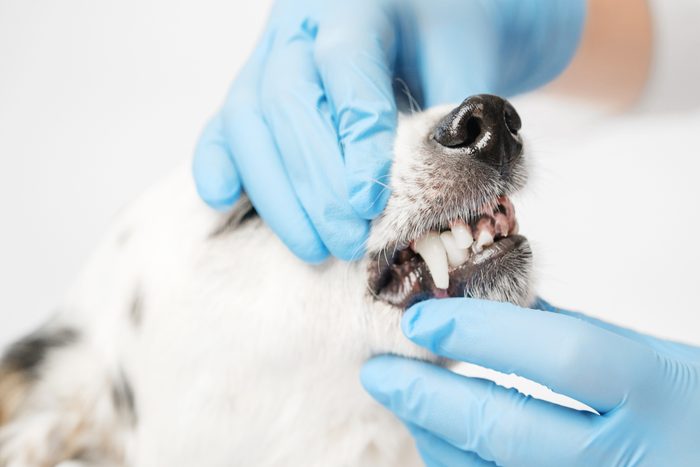
Unfortunately, you probably won’t notice dog dental problems until they become advanced. “Often, pets don’t show any signs of periodontal disease, but things to look for at home include bad breath, red and bleeding gums, changes in eating behaviors and signs of pain around the mouth,” says Dr. Hoyer. Other warning signs may include:
- Broken teeth: Dogs that chew hard objects like rocks, sticks or hard toys may break off or loosen teeth.
- Yellow to brown plaque: One of the most noticeable signs of periodontal disease is a buildup of gross-looking hard deposits at the base of the dog’s teeth.
- Discolored teeth: A discolored tooth could indicate the death of the tooth root or a crack in the enamel. That can cause great pain.
- Facial swelling: Just as with people, an abscessed tooth can cause swelling of the jaw.
- Blood on a toy: You might never notice the dog’s bleeding gums until blood stains a toy.
- Irritability: A classic sign of dog dental issues is a gradual change in behavior. Happy dogs become snappy; energetic dogs may sleep more and become reluctant to play. Once teeth problems resolve with treatment, dog owners often are amazed at how they act like a puppies again.
FAQs
What softens tartar on a dog’s teeth?
Tartar is a film that grows on teeth. It can be dissolved with some of the dental diet and treat formulations (and dog toothpaste) that help prevent it sticking to the teeth or forming in the first place. A dental chew toy can help mechanically remove tartar film, as can brushing the dog’s teeth.
Should I scrape the plaque off my dog’s teeth?
No. Any kind of tool capable of mechanically scraping away plaque could also slip and injure your dog. Plaque also extends below the gum line, and you can’t access that while your dog remains awake.
What is the best natural way to clean a dog’s teeth?
The best way to naturally clean a dog’s teeth is to provide healthy and safe chew options, brush the dog’s teeth and provide a dental diet and/or treats that help prevent tartar buildup.
Is it too late to start brushing my dog’s teeth?
No. While puppies often accept new things more readily, with patience, dogs of any age can learn to accept home dental care.
Why trust us
At Reader’s Digest, we’re committed to producing high-quality content by writers with expertise and experience in their field in consultation with relevant, qualified experts. For this piece, dog exert Amy Shojai, CABC, tapped 30 years of experience teaching and writing about pet behavior, and then Wailani Sung, MS, PhD, DVM, DACVB, a board-certified veterinary behaviorist in San Francisco, gave it a rigorous review to ensure that all information is accurate and offers the best possible advice to readers. For this piece, we relied on reputable primary sources, including a veterinarian and certified dog behaviorists. We verified all facts and data and backed them with credible sourcing, and we will revisit them over time to ensure they remain accurate and up to date. Read more about our team, our contributors and our editorial policies.
Sources:
- Naomi Hoyer, DVM, DAVDC, board-certified veterinary dentist; email interview, Feb. 20, 2024
- VCA Animal Hospitals: “Dental Disease and Its Relation to Systemic Disease in Pets”
- The Veterinary Oral Health Council: “VOHC Accepted Products”
- American Veterinary Dental College: “Mission and Objectives”
- Cornell Richard P. Riney Canine Health Center: “Periodontal Disease”
We’re rounding the corner into 2024, and everyone is more than ready to usher in the new year. Some people are celebrating by throwing a New Year’s Eve party (complete with some super fun games), whereas others are watching New Year’s Eve movies while waiting for the ball to drop.
No matter what you do, though, there’s always room for New Year’s humor. And lucky for us, there are plenty of New Year’s jokes! So kick off 2024 with some laughs by telling these hilarious puns and one-liners all the way to midnight.
Get Reader’s Digest’s Read Up newsletter for more humor, holiday tips, cleaning, travel, tech and fun facts all week long.

The funniest New Year’s jokes and puns
1. What is a New Year’s resolution?
Something that goes in one year and out the other.
2. What do snowmen like to do on New Year’s Eve?
Chill out.
3. Youth is when you’re allowed to stay up on New Year’s Eve. Middle age is when you’re forced to.
4. What do New Year’s Day parades have in common with Santa Claus?
No one is awake to see either of them.
5. My grandparents had resolutions like donating more time and money to charities. I’ve decided to make my own coffee once a week.
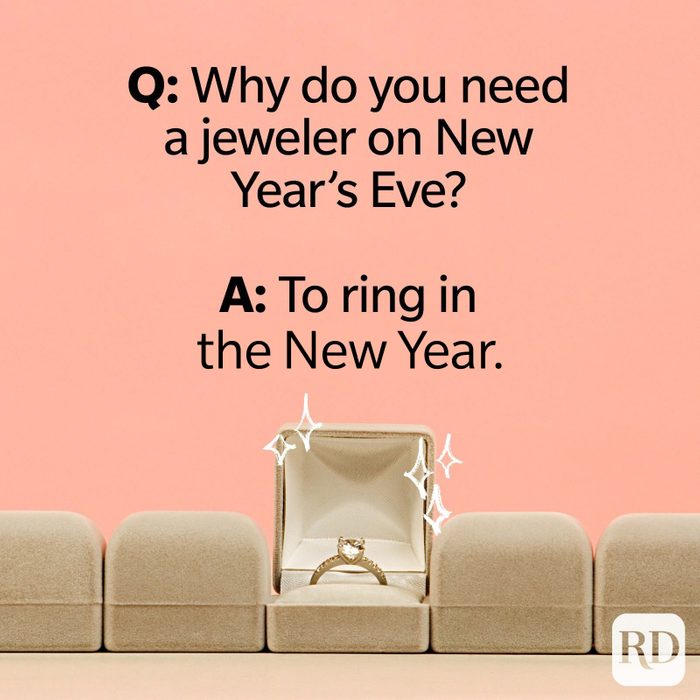
6. Why do you need a jeweler on New Year’s Eve?
To ring in the New Year.
7. My New Year’s resolution is to stop hanging out with people who ask me about my New Year’s resolution.
8. What did the little champagne bottle call his father?
Pop!
9. What’s a cow’s favorite holiday?
Moo Year’s Eve.
10. Where can you find comedians on New Year’s Eve?
Waiting for the punch line.
11. What do farmers give their wives at midnight on New Year’s Eve?
Hogs and kisses.
12. An optimist stays up until midnight to see the new year in. A pessimist stays up to make sure the old year leaves.
Loving these New Year’s jokes? Feel free to use them as funny New Year’s captions on Instagram.
13. What did the ghost say on Jan. 1?
Happy Boo Year!
14. What do you call always wanting a date for New Year’s Eve?
Social security.
15. What’s a digital camera’s New Year’s resolution?
1080p.
16. This New Year’s, I’m going to make a resolution I can keep: no dieting all year long.
17. Knock, knock.
Who’s there?
Abby.
Abby who?
Abby New Year!
18. Where can you go to practice math on New Year’s Eve?
Times Square.
19. Why should you put your new calendar in the freezer?
To start off the New Year in a cool way.
20. What do you tell someone you didn’t see on New Year’s Eve?
I haven’t seen you for a year!
21. This New Year’s, I’ve resolved to lead a better life. Now all I have to do is find someone who will trade lives with me.
22. What happened to the man who shoplifted a calendar on New Year’s Eve?
He got 12 months!

23. What is corn’s favorite holiday?
New Ears Day!
24. What’s the one group that hates New Year’s Day?
The New Year’s Eve cleanup crew.
25. What did Adam say to Eve on Dec. 31?
It’s New Year’s, Eve.
26. Why was the telephone late for work on Jan. 1?
It was busy ringing in the new year!
27. What did George Washington do in the days leading up to New Year’s?
He made a New Year’s revolution.
28. What compliment did the drink glass give to the champagne on New Year’s Eve?
“You’re so bubbly!”
29. I don’t know why people flock to Times Square on New Year’s Eve. They always drop the ball.
30. Why is New Year’s a slice of bread’s least favorite holiday?
It has to make a toast.
31. Why did the man stand on one leg at midnight on New Year’s?
He wanted to start the year on the right foot.
32. Why was the Hershey bar bummed on New Year’s Eve?
It got stuck waiting for a midnight Kiss.
33. What do kangaroos say to each other at midnight on Jan. 1?
“Hoppy New Year!”
34. What did the woman say when she was offered a raisin on New Year’s Eve?
“No thanks. I already have a date.”
Looking for more New Year’s jokes and humor? These funny New Year’s memes will have you laughing into 2024.

35. What was the opening line of the spice rack’s New Year’s toast?
“Cheers to the good thymes!”
36. My dad gave up smoking cold turkey for New Year’s. He’s doing better now but … he’s still coughing up feathers.
37. What was Dr. Frankenstein’s New Year’s resolution?
To make new friends.
38. What do you call someone who says they know all the words to “Auld Lang Syne“?
A liar.
39. What’s the worst part of jogging on New Year’s Eve?
The ice falling out of your drink!
40. I made a New Year’s resolution to drink more water. I’ve only gotten as far as “drink more.”
41. What New Year’s resolution should a basketball player never make?
To travel more.
42. Did you hear about the guy who started fixing breakfast at midnight on Dec. 31?
He wanted to make a New Year’s toast.
43. Why did the man sprinkle sugar on his pillow on New Year’s Eve?
He wanted to start the year with sweet dreams.
44. Knock Knock.
Who’s there?
Radio.
Radio who?
Radio not, it’s a new year.
45. What should people never eat on New Year’s Eve?
Fire crackers.
46. What does a caterpillar do on Jan. 1?
Turns over a new leaf.
New Year’s one-liners

47. This New Year, I resolve to be less awesome … since that is really the only thing I do in excess.
48. Not to brag, but I already have a date for New Year’s Eve—Dec. 31.
49. My New Year’s resolution is to get better at pretending to know the words to “Auld Lang Syne.”
50. My resolution was to read more, so I turned on the subtitles on my TV.
51. I was going to quit all my bad habits for the new year, but then I remembered that nobody likes a quitter.
52. I see no need to make more New Year’s resolutions when the ones already on the books aren’t being enforced.
Submit your best joke here, and get $25 if Reader’s Digest runs it.
Start your morning with a cuppa jokes (and some funny coffee quotes). Drink up these coffee puns based on your flavor-ite songs, bands, movies, TV shows, and books. Cool story, brew! If you like your roast strong, hit the (coffee) grounds running, with these nutty, rich, and stimulating puns! They’re perk-fection for procaffeinating during the daily grind. Stay frappé! (P.S.—save these hilarious wine puns to browse through during happy hour.)
“Pour some sugar on me” with these choc’ n’ roll coffee puns set to music!
“I love brew. I honestly love brew.”
Remember Olivia Brew-ton John’s mega pop hit from the seventies? Her vocal sweetness captures how we all feel about coffee.
“Excuse me while I kiss the chai.”
Imagine if Jimi Hendrix’s legendary rock song “Purple Haze” was really an ode to a chai tea latte? All any of us need is a little caffeine to clear the haze.
“Thank you for bean a friend!”
Of course, The Golden Girls theme song is a celebration of friendship, just like the show itself. Coffee is also your BFF. (Brewed Full-bodied Forever!) Check out these un-beetable vegetable puns for more laughs.
“Wake me up before you cocoa!”
Wham’s totally addictive ’80s pop hit perfectly captures our need for a hot beverage in the morning!
“My coffee amour, milky little cup that I adore.”
Stevie Wonder’s beautiful soul song gets it exactly right when it comes to your love affair with coffee. Why do we love it so much? Check out the things that happen to your body when you drink coffee every day.
Here are your TV show coffee puns—just add streaming and sugar

The X-Filters
This sci-fi classic follows Scully and Mulder as they hunt for the perfect cappuccino and UFOs—Unidentified Fair-trade Organic coffees.
Pretty Little Lattes
A coffee klatch of teen girls face the mystery of a lost barista in this bold drama that’s fresh and flavorful.
Twin Perks
Tensions percolate in this regional tale about dark roasts that move at a slow drip. Will give you the jitters!
Coffee, the Vampire Slayer
Trouble brews when creatures of the dark try to switch to decaf. So, a robust, young woman, “Cuffy,” fulfills her destiny and gets in hot water as she tracks caf-fiends.
Friday Night Lattes
It’s full steam ahead in this show about a beverage joe and his football bean. It may be a small-town Texas bean, but it boasts the greatest joe on earth. The teenaged beans grind it out with a full cold press in this earthy drama. A true brew-mance! Check out the best coffee shop in Texas, and all the 50 states.

Pour-over these addictive novels about coffee—with puns! Hold my brew!
For Whom the Bean Tolls
It tolls for beans! Ernest Hemingway’s classic novel about the nature and experience of Spanish coffee got its title from John Donne’s famous poem about beankind. Because no bean is an island.
David Coffeefield
The famous first line of Charles Dickens’ epic novel states, “Whether coffee shall turn out to be the hero of my own life, or whether that station will be held by tea, these pages must show.” If you enjoy Dickens, next try Great Percolations, Bleak Coffee House, and A Tale of Two Chicories.
The Count of Macchiato
This strong, saucy tale by Alexandre Dumas follows a man who is wrongly given decaf coffee—for years—and justifiably, must seek revenge.
The Lord of the Beans
J.R.R. Tolkien’s epic fantasy about the coffee bean industry of middle earth brims with rich nuttiness.
The Brothers Caramel Mocha
You may find Fyodor Dostoevsky’s bitter, aromatic novel far less sweet than its title suggests. Did you know that people who like to drink their coffee black may be psychotic?
What’s the best band of coffee? Give it your best shot with these coffee pun band names
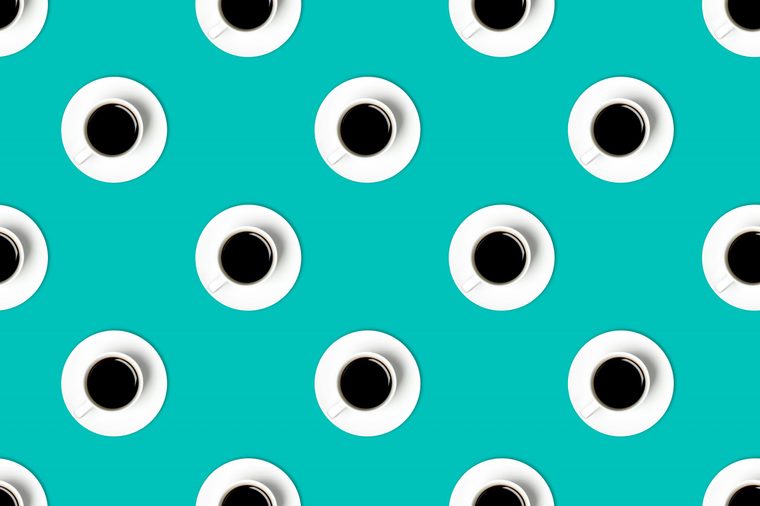
The Smashing Pumpkin Spice Lattes
Their ’90s album “Mellon Collie and the Infinite Sadness” may make you a little despresso.
Rage Against the Espresso Machine
These rock purists feature blends of punk, thrash, metal, and hip-hop in their grinds.
The Red Hot Coffee Peppers
Caffeine-infused vibes and intense percolations make for a robust band of Americano brews.
AC/Decaf
Their vigorous album, “For Those About to Rock, We Salute Brew,” uses hard beans with dark, metallic undertones.
Fleetwood Macchiato
Their pop hit, “Don’t Stop Thinking About Your Coffee,” will really perk you up.
More of a tea person? You’ll love these hilarious tea puns!
Coffee puns at the box office—for some good clean pun! It’s a wonderful latte!
There’s Something about Mocha
It’s the adventure of a bunch of brews obsessed with a brew-tiful blonde.
That Thing You Brew!
This feel-good romp features a perky hit song that you’ll like a latte.
Back to the Frother
When it comes to froth, you need perfect timing. Better latte than never.
The Polar Espresso
Kids escape late at night to visit Sanka, and shouldn’t they be grounded?
He’s Just Not That Into Brew
There are a few frappé cup-ples by the end of this brew-mance that features mugs and kisses. Are you the type to annoy your barista? Check out the 10 rude coffee shop habits you can stop doing a latte.
House-training a puppy, taking in an unruly stray or caring for an older dog requires love, patience and a lot of cleaning. Accidents (of the pee variety) will happen, and if you have carpeting, you’ll be cursing the day you decided against plank flooring. The bottom line: You need to know how to get dog pee out of carpet. The good news is that dogs and carpets have been coexisting for years, and cleaning experts have loads of tips to help.
The bad news? “The smell of urine and feces is reinforcing for dogs,” according to veterinarian and pet behaviorist Amanda E. Florsheim, DVM, owner of Veterinary Behavior Solutions in Carrollton, Texas. That means once a dog picks a spot and goes there, it’s likely to go there again if you don’t take the proper measures. Cleaning the pee spot all the way down to the floor is the first step, but you’ll also need to adjust your dog’s behavior.
Reader’s Digest spoke with three carpet cleaning experts and Dr. Florsheim to help you fix this urgent, and potentially recurrent, problem. Yes, sometimes old or large pee stains are tough to remove, and you may have to hire a pro or even replace the carpet. But let’s cross that bridge when we get there—hopefully, never. Ahead, you’ll learn the right way to get dog pee (and pee smell) out of your carpet and other soft surfaces like upholstery and dog bedding.
Get Reader’s Digest’s Read Up newsletter for more cleaning, pets, humor, travel, tech and fun facts all week long.
|
On This Page About the experts
Reviewed for accuracy by: Ann Russell, TikTok’s “cleaning auntie” and the author of How to Clean Everything. |
What to do before you start stain removal
- Remove your dog from the area. Don’t scold your dog or “rub his nose in it,” says Dr. Florsheim. Dogs will not put two and two together about the pee and why you’re mad. Just lead your dog into another room or outside while you get to work.
- Jump on stains immediately. While it is possible to remove dried dog pee from carpet, “fresh urine is easier to remove, by far,” says Jeff Cross, a cleaning expert from ISSA, a trade group for cleaning professionals. (FYI, the same is true when trying to remove dog poop from carpet.)
- Know your carpeting. Is it silk, wool, synthetic? It’s important to find out, because some cleaners aren’t suitable for certain fibers. Once you know, check the label of your cleaner. The “label is the law” when it comes to cleaning products, according to professional janitor Brandon Pleshek. “Make sure to read it, and use as directed.”
- Test for colorfastness. Your carpet’s already covered in pee—don’t wreck it further by spraying an untested chemical all over it. First, test the cleaning solution on an inconspicuous area. This is especially important if you don’t know what kind of carpeting you have.
- Soak up the pee. No matter what cleaning method you use, you need to get up as much of the urine as possible, Pleshek says. So stock up on plain white paper towels, which will get the job done and prevent color transfer.
How to get dog pee out of carpet with enzymatic cleaner
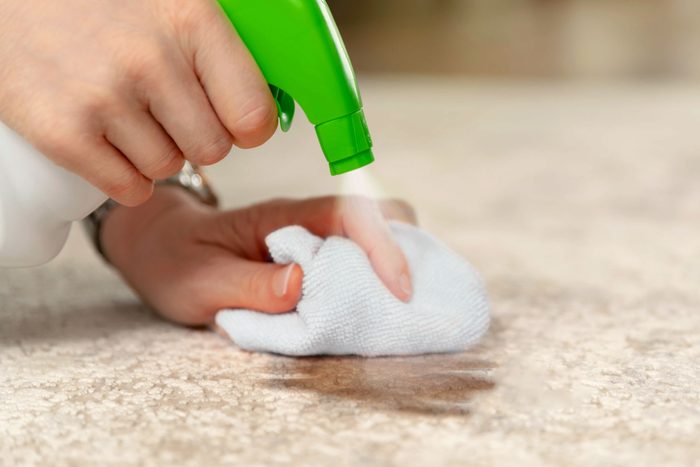
Every expert we consulted praised enzymatic cleaners, since they work by “digesting” the pee on your carpet. “But you need to follow the directions exactly,” says Cross. Some require diluting, while others should be used at full strength. Certain formulations can be used in a carpet-cleaning machine; others are made just for spraying. You’ll also need to give them ample time to work.
Supplies you’ll need
- Enzymatic carpet cleaner
- Plain white paper towels, or towels
- Vacuum cleaner
Directions
- Read the label, since instructions may vary slightly from brand to brand.
- Using an absorbent towel or lots of paper towels, soak up as much pee as possible.
- Dilute the enzymatic cleaner as directed on the package, or apply it at full strength if indicated.
- Saturate the pee spot. Make sure the solution reaches all the way to the base of the carpet.
- Allow the cleaner to sit for the recommended amount of time, usually about 10 to 15 minutes (to start).
- Blot the spot with a towel to remove excess liquid.
- Allow the spot to dry for 24 hours. The enzymes will keep working as long as there’s pee to digest. Keep pets away during this time.
- Once the time is up, vacuum to remove cleaner residue.
- If you still see a stain or smell an odor, re-saturate the spot with the enzymatic cleaner. Lift up the carpeting to saturate the pad or floor for best results.
- Allow to dry completely, usually for 24 hours. Many enzyme cleaners do not require rinsing, but double-check to make sure.
How to get dog pee out of carpet with dish soap and vinegar
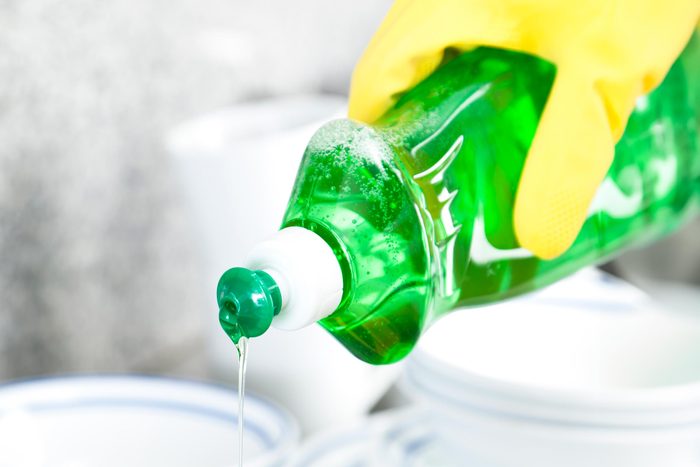
Out of enzymatic cleaner? Cleaning expert Karen Cady of the Carpet and Rug Institute (CRI) Seal of Approval program says that simple homemade cleaners, like a solution of vinegar and liquid dish soap, can also get dog pee out of carpet. Vinegar works because it can break down uric acid, which is what makes d0g pee smell, and also neutralize bacteria. Like enzymatic cleaner, this method works best on fresh pee.
Before we dive into the directions, a few important notes: Don’t use dish soap that contains bleach or lanolin, Cady says. Bleach could discolor the carpet, and lanolin could make the stain worse. And only use liquid dish soap, never dishwasher detergent or laundry detergent. For more CRI-certified cleaners, check out the CRI database, or look for the CRI seal of approval on the package.
Supplies you’ll need
- Dish soap
- Plain white paper towels
- Small bowl
- White vinegar
Directions
- Remove as much pee as you can by blotting the area with plain white paper towels.
- Mix a solution of 1/4 teaspoon dish soap and 1 cup lukewarm water. Work up some suds.
- Dunk a clean paper towel into the solution, and repeatedly blot the stain. Use a fresh spot of the towel each time to avoid transferring pee back to the carpet.
- Wet fresh paper towels with lukewarm water. Blot the area repeatedly to rinse it. Move to a new spot of the paper towel each time, until the area is no longer soapy.
- Reapply the dish-soap solution. Continue rinsing and blotting with the solution and water as long as you see the stain getting better, or there’s no more pee transferred to the towel, Cady says.
- Next, mix a solution of 1 cup white vinegar and 2 cups water. Saturate clean paper towels with the vinegar-and-water solution, and dab it onto the stain. Make sure the solution reaches all the fibers. (Don’t rinse.)
- With a fresh paper towel, blot the area dry. Then “apply a half-inch layer of paper towels to the affected area, and weigh down with a flat, heavy, non-fading object,” Cady says.
- Change the paper towels frequently until the area is completely dry—possibly 24 hours or more.
How to get dried dog pee out of carpet
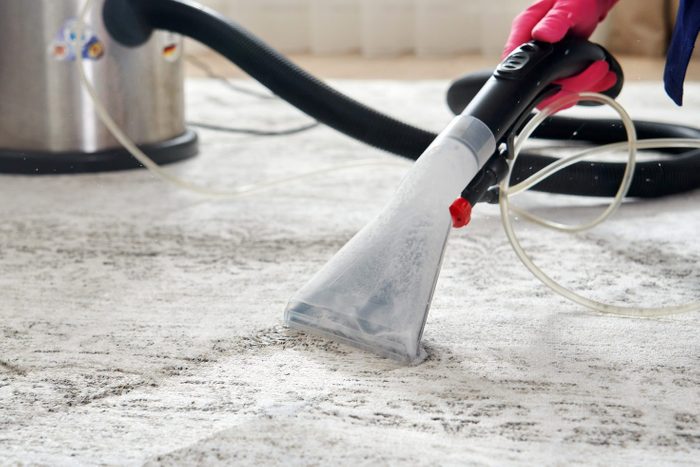
Dried pee can be very challenging to remove. Your dog is likely to smell and revisit the pee spot, and it doesn’t smell so great for you either. Urine is mostly water, but it’s the other stuff, particularly uric acid, that binds to the fibers (and smells) as the pee dries. “Unless an area is cleaned with a good enzymatic cleaner, dogs can still smell the small remnants that regular cleaning can leave behind,” Dr. Florsheim says. That’s why Pleshek recommends an enzymatic cleaner, combined with a carpet-cleaning machine or attachment that fits on a wet-dry vacuum, and he walks us through the steps below.
Supplies you’ll need
- Enzymatic pet stain cleaner concentrate for carpet machines
- Carpet-cleaning machine, or wet-dry vacuum attachment
Directions
- Dilute the cleaner 50-50 with water, or as indicated on your carpet-cleaning concentrate.
- Saturate the stain completely, all the way to the base of the carpet.
- Let it sit for 35 minutes to an hour. “The key here is to let the enzymes work,” Pleshek says.
- Suck the cleaner out of the carpet with the machine or attachment. (Pleshek recommends the SOS Sub Surface Carpet Extraction Tool.)
- Rinse, if indicated on the cleaner. Dump out the dirty extracted water, and fill the machine with fresh water. Make passes over the area until the machine no longer extracts any dirty cleaning solution.
- Dry the carpet completely, which could take 24 hours or more. Use fans to speed things along.
| ♦ Pro tip |
| If you don’t have a carpet-cleaning machine or proper attachment, follow the enzymatic-cleaner directions for fresh pee, and make sure the cleaner reaches all the way to the pad. If pee remains behind, your dog will smell it, and you may need to keep him out of the area to prevent him from peeing there again. |
How to get dog pee out of upholstery
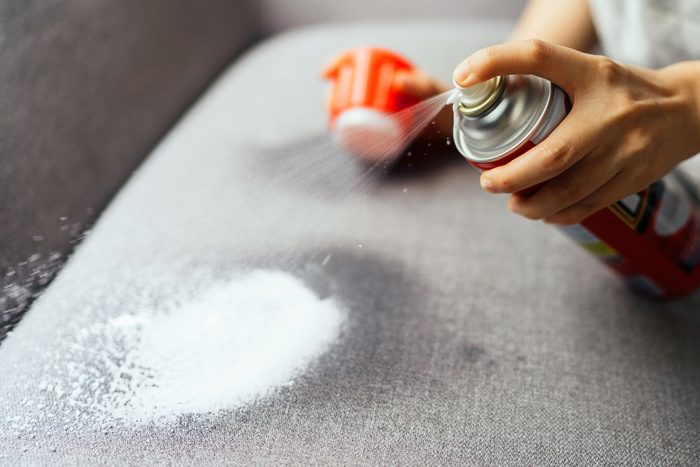
Cross says to clean upholstery the same way you clean carpeting, but use more care so you don’t damage the thinner fabric on couches and chairs. The first rule is to check your furniture’s care label. Some fabrics and fill material must be dry-cleaned, while others can tolerate carpet shampoos and water. If your furniture has a removable cover or slipcover, take it off and clean it as indicated on the label. You may be able to toss it in the wash, although a gentle cycle is probably in order.
If you don’t have a washable slipcover, follow the steps below, but remember that your specific label should always reign. Furniture is expensive, so always test a small area in an inconspicuous spot before proceeding, especially if you’re not sure.
Supplies you’ll need
- Enzymatic cleaner, carpet shampoo, dish soap or vinegar
- Plain white towels or paper towels
- Small bowl
Directions
- Blot the stain with paper towels or towels to absorb as much liquid as possible. If you get to it quickly, it may not soak into the cushion.
- Remove the cushion cover or slipcover if you can. This will make it easier to assess how far the pee has penetrated, as well as let you wash and dry the cover separately, whether by hand or in the washing machine.
- If pee has penetrated the foam, spray the spot with enzymatic cleaner, fully saturating it. Follow the instructions on the cleaner.
- If you can’t remove and/or wash the cover in the machine, and it doesn’t say “dry clean only,” apply enzyme cleaner to the cover and cushion. Allow it to work for the recommended amount of time, generally 10 to 15 minutes to start.
- Blot to remove excess cleaner, and allow it to dry for 24 hours. If necessary, repeat the application. Do not rinse unless the cleaner says to do so.
- Alternatively, mix 1/4 teaspoon dish soap and 1 cup warm water; 1 cup vinegar to 2 cups water; or a spot cleaner that’s approved for upholstery.
- Apply, blot and rinse the spot and cushion until you no longer see or smell pee on the towels or cushion. Use a fresh section of the towel each time to avoid transferring pee back to the upholstery. Make a new solution if it gets dirty.
- Do a final rinse by blotting with fresh water and paper towels.
- Dry the cover and furniture thoroughly before replacing the cover or using the couch or chair.
How to get dog pee out of dog beds
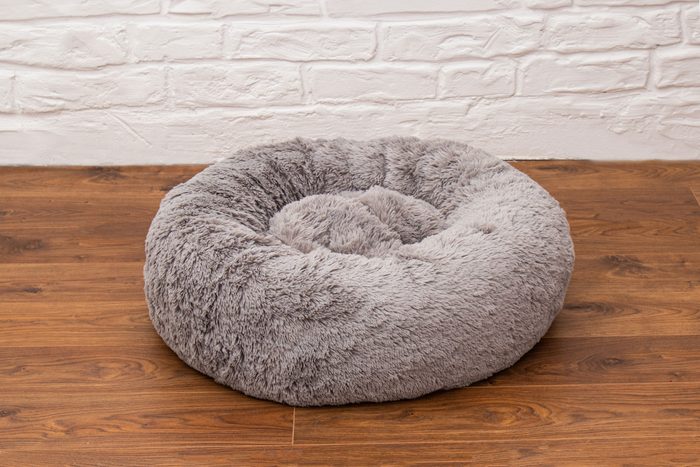
Your dog’s bed probably smells pretty bad on a good day, but the addition of pee? No thanks. Hopefully, the bed has a removable cover. (If not, someone really should have a word with that dog-bed manufacturer.) Sop up any pooled pee, carefully take off the cover and launder it. Air out the bed while the cover gets clean. If pee soaked into the foam or fill, here’s what to do.
Supplies you’ll need
- Mild laundry detergent
- Bathtub or large sink
Directions
- Read the care label on the bed. You may be able to wash the entire bed in the washing machine.
- If not, fill your bathtub about a third of the way with cool water. Add a small amount of mild, pet-safe laundry detergent, and swirl it around.
- Submerge the entire dog bed in the water, and squeeze to get the soap into the foam.
- Soak for 15 minutes, then squeeze and agitate to clean the pee from the cushion.
- Rinse well by draining and refilling the bathtub until no soapy residue remains. Squeeze out as much excess water as you can.
- Air-dry outside, if possible. Alternatively, your dog bed might be able to go in the dryer on low; check the label, and if so, toss in some tennis balls or dryer balls to fluff it. Another option is to use a drying rack or hang it indoors in a well-ventilated area until completely dry.
How to get a dog to stop peeing in the house
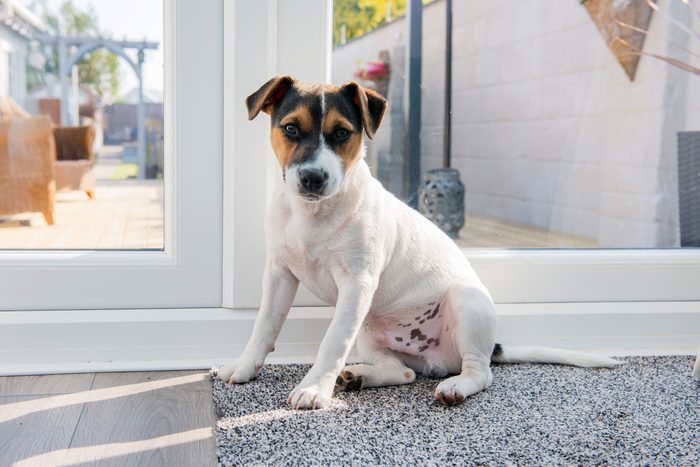
Cleaning up after your dog is a labor of love, but let’s be real: You need your dog to stop peeing in the house. That’s easier said than done, of course, but getting all the pee out of the carpet and upholstery will help. Remember, dogs aren’t trying to pee in the wrong place—they actually think it’s the right place to go! If you want to spend less time cleaning up after your dog, you need to figure out the root of the problem. If the peeing is new, says Dr. Florsheim, take your dog to the vet “to help rule out problems like bladder infections, stones and pain.”
If everything checks out medically, here are some strategies that can help eliminate accidents.
- House-train your dog. Every time your dog goes to the bathroom in the house, it is self-reinforcing. They have pressure from their bladder or colon, they go, and then they feel better. That’s a powerful reward, Dr. Florsheim says. That’s why she doesn’t advise using pee pads, unless you always plan to have them available (for their entire life).
- Use positive reinforcement. Just like peeing feels good to your dog, so does your praise. Never yell at or strike your dog. “Instead, if you catch them in the act, interrupt them as neutrally as you can and redirect them outside,” Dr. Florsheim says. If you find the pee even a second after your dog is done, it’s too late. Just clean it up and work on house-training.
- Go outside with your dog. “The best way to encourage a dog to go where you want them to is to go with them,” according to Dr. Florsheim. When your pup pees outside, give plenty of praise and a high-value treat. Reward “right as you dog finishes going, not when they come back in the house,” Dr. Florsheim says, or they’ll associate the reward with coming inside and may not even go!
- Reduce anxiety. Marking, or peeing on things deliberately, can be a sign of stress due to other dogs in the home, or even people your dog is wary of. Does it happen at certain times of day? Is it the weather? Try to narrow down the triggers, and talk to your vet about ways to reduce your dog’s anxiety.
- Be patient. Dogs newly introduced to your home may have trouble adjusting to the feel of new grass or turf, or strange noises. And puppies and dogs from mills or other abusive conditions may have never seen or felt grass at all, Dr. Florsheim says. They don’t know the yard is for peeing until you show them and reinforce the good behavior.
FAQs
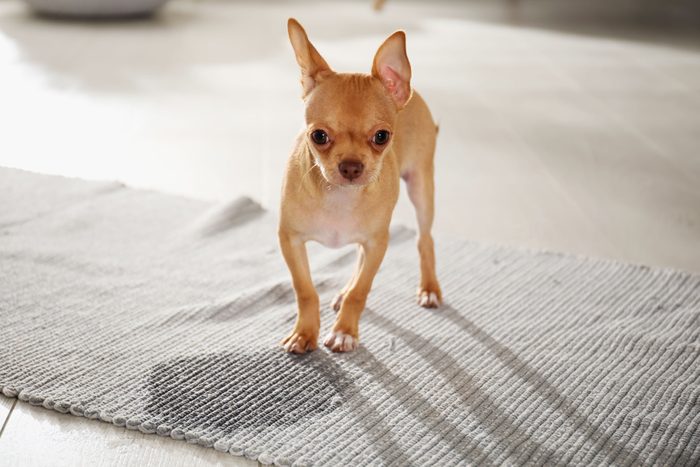
What kills the smell of dog urine in carpet?
Enzymatic cleaners (also called enzyme cleaners). While you can buy any number of products that promise to get rid of odor, they often just mask it. Then, “in times of high humidity, the odor may reappear,” Cady says. Enzymes actually digest the molecules that make up the stain and smell, allowing their byproducts to evaporate. By using an enzyme cleaner correctly, you’re really getting rid of every last drop of pee. No more smells, for you or your dog.
Why does my carpet still smell like pee after cleaning?
Quite simply, because there’s still pee in it. If you don’t get every last bit of pee out out of your carpet, it changes over time and gives off really toxic-smelling odors. Cross says it’s chemistry. “Over time, urine changes from an acid to an alkaline, and that’s why you get the ammonia smell,” he explains. “This is really tough to remove.” If you haven’t tried an enzyme cleaner, do. If it still smells like pee, repeat, lifting up the carpet to get underneath. If that fails, call a pro.
Will vinegar stop a dog peeing in the same spot?
Maybe, maybe not. Vinegar is a great cleaner and it does neutralize the pee odor, but dogs have incredible senses of smell. To really destroy the reason they are coming back to the same spot, use an enzyme cleaner, which leaves nothing behind if used correctly.
Does dog pee destroy carpet?
It can. If you clean fresh pee right away and dry your carpet completely, it will likely be fine. But repeated peeing that’s allowed to sit and soak? That’s definitely going to wreck your carpet. Dog pee reacts with the dyes in the carpet, and prolonged moisture can cause delamination, where the carpet fibers separate from the backing, according to the CRI. Then there’s the smell. Clean up pee immediately for the best chance of success.
If you’ve tried these methods to remove pee and your carpet still stinks, or it’s discolored, bleached or fraying, call a professional. If the problem is confined to one area, they may be able to patch the carpet. Otherwise, you might need to buy a new one.
Why trust us
At Reader’s Digest, we’re committed to producing high-quality content by writers with expertise and experience in their field in consultation with relevant, qualified experts. For this piece on how to get dog pee out of carpet, Ally Childress tapped her experience as a home and cleaning journalist, and then Ann Russell, TikTok’s “cleaning auntie” and the author of How to Clean Everything, gave it a rigorous review to ensure that all information is accurate and offers the best possible advice to readers. We relied on reputable primary sources, including carpet-cleaning experts and a veterinary behaviorist, verified all facts and data and backed them with credible sourcing, and we will revisit them over time to ensure they remain accurate and up to date. Read more about our team, our contributors and our editorial policies.
Sources:
- Karen Cady, program manager, CRI Seal of Approval program; email interview, Feb. 5, 2024
- Jeff Cross, media director at ISSA; email interview, Feb. 1, 2024
- Amanda E. Florsheim, DVM, veterinarian and owner of Veterinary Behavior Solutions; email interview, Feb. 6, 2024
- Brandon Pleshek, janitor and cleaning expert at Clean That Up; phone interview, 2022
- CRI Technical Bulletin: “Pet Urine and Carpet”
If you own a dog, you’ve no doubt been there: You’re eating lunch, and your dog’s eyes are following your movements. You’re brushing your teeth, and your dog is looking up at you. You’re watching TV, and your dog is watching you. You wouldn’t be alone in wondering, Why does my dog stare at me?
Dogs have been at our side for more than 10,000 years, becoming master observers of human behavior. Although being stared at by our pets can be uncomfortable, this behavior serves many practical—and usually harmless—purposes for our four-legged companions.
As a veterinarian, I am well versed in dog behavior and have extensive knowledge about why dogs do what they do. So let’s explore the reasons your dog may be staring at you and how this staring behavior is good for you both.
Get Reader’s Digest’s Read Up newsletter for more cleaning, humor, travel, tech and fun facts all week long.
| Reviewed for accuracy by: Wailani Sung, DVM, a vet with a board certification in veterinary behavioral medicine who owns Bay Area Vet Behavior. Dr. Sung is the co-author of From Fearful to Free: A Positive Program to Free Your Dog from Anxiety, Fears and Phobias. |
Why does my dog stare at me?
Dogs can’t talk (although we sometimes wish they could), so they rely on their body language and facial expressions to communicate with us. When our dogs stare at us, they use their eyes to tell us something. It’s up to us to figure out what that something is and respond accordingly.
It’s getting to know you better
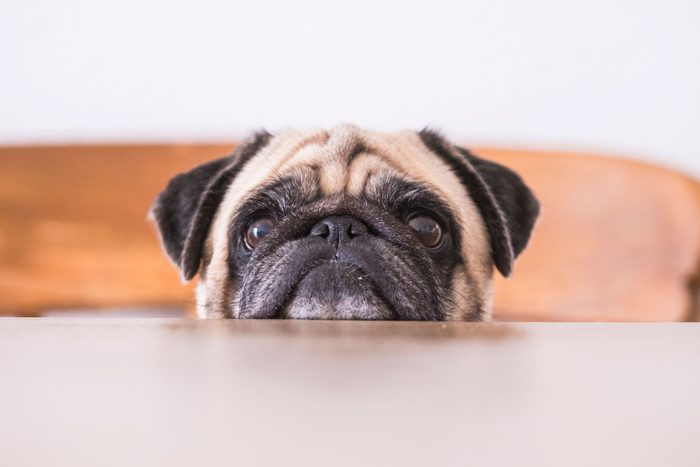
Over the thousands of years that dogs have been in our lives, they have not tired of observing us. When your dog stares at you, it’s trying to understand various things about you, like your habits, body language, facial expressions and tone of voice.
Your dog will also stare at you to gauge how you’re feeling. If you’re moping around the house, your dog will likely be able to pick up on that negative energy and possibly try to comfort you.
It’s telling you what it needs
Wouldn’t it be nice if our dogs could say, “I need to go to the bathroom” or “I’m hungry”? Since they can’t, they use their eyes to communicate these needs to us. For example, if your dog needs to pee, it might stand by the door and look at you to signal that it needs to go outside.
If your dog stares at you and licks its lips while you’re eating, it’s probably begging for food. Be careful with this type of stare, because giving your dog a tasty morsel of food will only reinforce the begging. Instead, encourage your pup to busy itself with another activity, such as a food puzzle toy, while you eat.
It’s expressing emotion
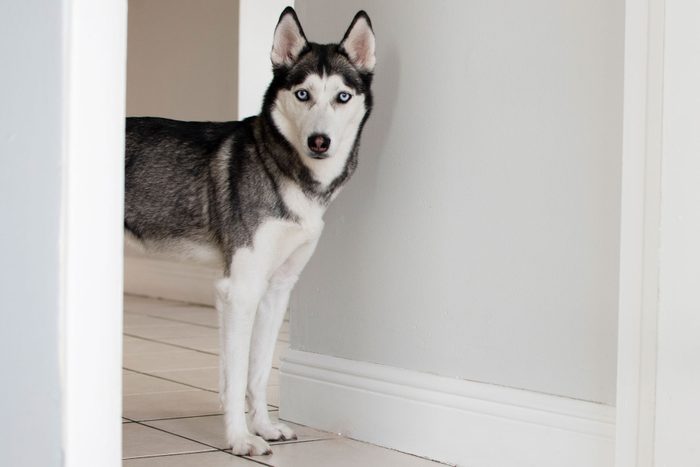
Love is one of the most powerful emotions our dogs can express to us through their eyes. A pup’s loving stare—the kind with slightly squinted eyes—will stimulate in its owner the release of oxytocin, the so-called love hormone. According to a study published in the journal Science, oxytocin strengthens the affectionate bond between you and your dog.
Dogs also stare to communicate aggression. An aggressive stare, accompanied by a stiff posture and unblinking eyes, tells you to back off. This type of stare, which you should not return, is often associated with resource guarding (for example, guarding dog toys) and signals a need for behavioral modification.
It wants attention
Quality time with our dogs is the highlight of our day—and theirs. If your dog is staring at you expectantly with a toy in its mouth, it’s urging you to give it attention and play with it.
If your dog shares your bed, it may stare at you to express a desire for some cuddle time before dozing off into dreamland.
It’s confused
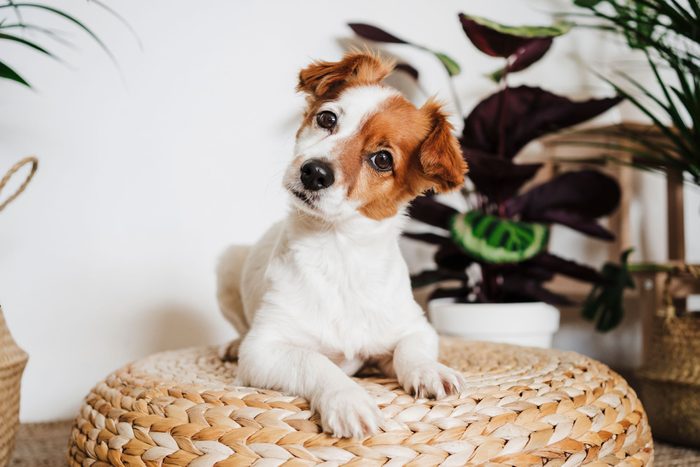
Quite literally, our dogs look to us for instruction. If your dog does not understand your command or is in an unfamiliar situation, it will stare at you for clarity on what to do.
Let’s say that you’re walking your dog and come to a crosswalk. Your dog might stare up at you, waiting for you to tell it when it’s safe to cross the street.
It’s pooping
Dogs have some odd bathroom habits. (Spinning before pooping, anyone?) You may have also noticed your dog staring at you when it poops, and there’s a reason for that. Squatting to poop puts your dog in a vulnerable position, so it’ll stare at you for reassurance that you will protect it while it’s doing its business. Be a good protector by scanning the area for potential dangers, such as another dog.
It’s sick or injured
Dogs depend on us to take good care of them. If your dog is injured or not feeling well, staring at you is its way of telling you that something is wrong and it needs your help. If your dog is acting out of the ordinary—say, being less active or acting extra clingy—it may be time for a trip to the vet.
It’s experiencing separation anxiety
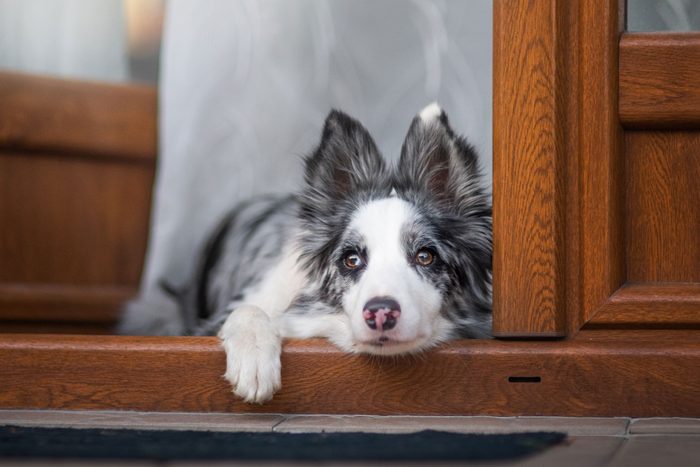
If your dog follows you everywhere and staring at you to ask for attention, it may be experiencing separation anxiety. Left unchecked, this can lead to destructive behavior and can negatively affect your dog’s physical health, causing issues such as vomiting and diarrhea.
If you suspect your dog has separation anxiety, talk to your veterinarian, who can refer you to a veterinary behaviorist. Severe cases of separation anxiety may require anti-anxiety medication in addition to behavioral modification.
Its brain function is declining
Older dogs can experience cognitive dysfunction, which is like human dementia. Signs of the disorder include confusion, anxiety, sleep disturbances and less interaction with owners, according to a study published in the journal Veterinary Clinics of North America, Small Animal Practice. Another red flag? Staring into space or at you.
If you have an older dog that is staring at you but doesn’t seem quite “there,” schedule a visit with your veterinarian for further examination.
Why it’s OK to make eye contact with your dog
“Why does my dog stare at me?” isn’t the only question you should be asking. Just as important is this: Why does human-canine eye contact matter?
Making eye contact with your dog helps you communicate with each other. Being able to interpret your dog’s stares will help you better understand what it needs and wants from you. Take, for instance, the process of training your dog. This is an ideal time for eye contact—your dog’s stare will indicate a need for instruction and reassurance as it learns new skills.
And let’s not forget the loving gaze! It helps strengthen the bond you share with your dog. As the researchers reported in the Science article, the oxytocin response between humans and dogs is a loop: When dogs stare at us, our level of the love hormone increases, which increases dogs’ oxytocin in turn.
Why trust us
At Reader’s Digest, we’re committed to producing high-quality content by writers with expertise and experience in their field in consultation with relevant, qualified experts. For this piece, JoAnna Pendergrass, DVM, tapped her experience as a veterinarian and journalist covering pets, and then Wailani Sung, MS, PhD, DVM, DACVB, a board-certified veterinary behaviorist who owns Bay Area Vet Behavior, gave it a rigorous review to ensure that all information is accurate and offers the best possible advice to readers. For this piece, we relied on reputable primary sources, including professional organizations and academic institutions, as well as our writer’s personal experience. We verified all facts and data and backed them with credible sourcing, and we will revisit them over time to ensure they remain accurate and up to date. Read more about our team, our contributors and our editorial policies.
Sources:
- Zoological Research: “Deciphering the puzzles of dog domestication”
- Science: “Oxytocin-gaze positive loop and the coevolution of human-dog bonds”
- Veterinary Clinics of North America, Small Animal Practice: “Canine Cognitive Dysfunction: Pathophysiology, Diagnosis, and Treatment”
- Journal of the American Veterinary Medical Association: “Review of epidemiological, pathological, genetic, and epigenetic factors that may contribute to the development of separation anxiety in dogs”
Dogs love to stick close to us, following us everywhere and getting comfortable on our laps while cuddling on the couch. It’s also not unheard of for our furry friends to lean against us when we’re near, though this behavior is a little trickier to interpret. In over 13 years as a certified professional dog trainer, I’ve had plenty of dogs lean against me or sit on my feet. And just as many clients have asked, “Why does my dog lean on me?”
If you find yourself confused by dog behaviors like this, you aren’t alone. It can be tricky to understand our four-legged friends because they have their own canine culture and language. When your dog howls, paws at you or showers you with slobbery kisses, it’s trying to tell you something. The same is true when your dog leans on you.
So what should a good pet parent know about this behavior? To get the best possible advice, I turned to a trio of experts—certified canine behaviorists and dog trainers—who are well-versed in the topic. Read on to learn why your dog leans on you and to dig deeper into when this common dog behavior signals a problem.
Get Reader’s Digest’s Read Up newsletter for more pet insights, humor, travel, tech and fun facts all week long.
About the experts
Reviewed for accuracy by: Wailani Sung, DVM, a vet with a board certification in veterinary behavioral medicine who owns Bay Area Vet Behavior. Dr. Sung is the co-author of From Fearful to Fear Free: A Positive Program to Free Your Dog from Anxiety, Fears and Phobias. |
Why does my dog lean on me?
One trick for understanding how dogs use touch to communicate is to consider the human equivalent. “The common element between most instances of dogs making physical contact with us is because it feels safe,” says certified behavior consultant and dog trainer Devan Amundsen, CBCC-KA, CPDT-KA. “I think I’d describe it like holding hands with someone. Sometimes it’s because you’re nervous, other times because you’re content and other times because there’s a lot going on and I want to watch [where I’m walking] without losing track of you.”
With the help of the experts, we’ll explore the most common answers to the question “Why does my dog lean on me?”
It’s showing affection
Our pets don’t have opposable thumbs to hold our hands or give our arm a squeeze. So how do dogs show us they love us? According to Sagi Denenberg, DVM, a veterinary behaviorist at North Toronto Veterinary Behaviour Specialty Clinic, dogs use leaning as an affiliative behavior. It’s a way to forge social and emotional bonds. “Dogs don’t hug, kiss or pet,” he says. “These are human ways of showing affection. Dogs lean or huddle.”
Certified behavior consultant and dog trainer Valerie Balwanz, CBCC-KA, CPDT-KA, points out that dogs express comfort and affection with other dogs through touch. And they use that love language on us as well. “Dogs that like each other will hang out near each other, and sometimes that includes pressing up on each other while sitting or sleeping. Because dogs include humans in their social circle, they extend these behaviors of proximity and contact to us too.”
It’s anxious
Dr. Denenberg believes the other major reason dogs lean on people is because they’re anxious. If an anxious dog can keep tabs on its human, it feels reassured, and what better way to do that than with physical contact? “An anxious dog will lean on its attachment figure [when possible] for comfort and mostly to know where the person is while keeping their eyes on someone else or sleeping,” he says. “This way, the dog knows exactly where you are even without looking and knows you cannot disappear [e.g., leave the house] without them knowing.”
Balwanz points out that steady pressure is comforting for some dogs, which may relate to their leaning behavior. For example, snug-fitting shirts can ease canine anxiety, as can certain types of massage. “Leaning on a favorite person provides pressure, which is comforting,” Balwanz says. “If your dog is following you around the house and seeking excessive contact, it’s possible that this indicates anxiety.”
Think your dog is leaning on you because it’s anxious? It’s important to build its self-confidence so it feels more at ease in the world.
It wants something
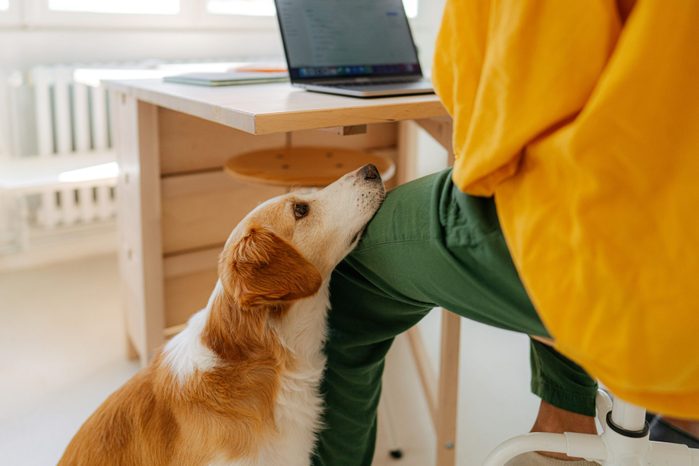
Your dog might also lean on you because it has learned that you pay attention to it when it does this. After all, it’s hard to ignore the contact, especially from the largest dog breeds. Balwanz explains that dogs do whatever helps them get what they want. “If a dog has learned that leaning on you makes you pet them or give belly rubs, then leaning is a behavior they will repeat in the future,” she says.
Amundsen doesn’t blame dogs for resorting to obvious signals like leaning to express themselves. “Humans are notoriously awful at reading dog communication. We miss so much of what our dogs are telling us,” he says. “As a result, I think dogs quickly learn what behaviors humans won’t miss and will get the dog what they want. Leaning is one of those behaviors. It’s usually pretty clear communication from the dog that they’d like a little bit of physical contact right now.”
To reduce this type of leaning, Amundsen suggests teaching your dog a different way to ask for physical attention. But he advises teaching your dog how to ask for that attention to stop as well. “I’d love for more people to talk about offering consent in dog interactions,” he says. “Our dogs aren’t here for us to do whatever we want to them. We’ve evolved side by side for thousands of years to be collaborative partners.” While you’re at it, find out why does your dog has whiskers. It turns out that they play a crucial role in the way dogs approach the world around them.
Is my dog leaning on me to establish dominance?
Although dog leaning can, at times, indicate a problem with your dog, it’s not about dominance. Dr. Denenberg explains that dogs’ relationships with humans are about attachment, not hierarchy—just like kids and their parents. If you think about it, pet dogs are our dependents. They can’t get anything in life, including food, toys, affection or exercise, unless we give it to them.
On top of that, dogs don’t show dominance that way. “When dogs lean against people, they often show very relaxed or vulnerable body posture and language, not confident and aroused like two dogs or wolves in conflict for status,” Dr. Denenberg says. “A dog vying for high status stands over [another animal], tenses its body and gives many signals. They don’t lean against the other dog, close their eyes or look elsewhere.”
A study in the journal PLOS ONE that examined the behavioral measures of dominance in dogs explained that what the researchers called “high posture” (head up, tail up, pricked ears, and straight back and legs) was the best status indicator for dominance during dog-to-dog interactions. That’s a far cry from your dog comfortably leaning against you.
Another study, published in the journal Animal Behaviour, examined how the social relationship between dogs impacts their stress levels. To measure that relationship, the scientists looked at canine behavior. They labeled one of the affiliative behaviors “body contact”—something they defined as “staying [for at least 10 seconds] with at least a part of the body in contact with the other subject, in a relaxed position.” Sounds a lot like leaning to me.
How do I know if my dog’s leaning is a problem?
Equally as important as asking “Why does my dog lean on me?” is questioning when your dog’s leaning behavior is a cause for concern. Balwanz says leaning on you could be a sign your dog is experiencing a medical condition involving its balance. “If you feel your dog is unsteady on their feet and leaning on you for support, it’s best to consult your vet,” she says.
That said, anxiety is the most likely cause for problem leaning. But how do you know if that’s why your dog leans on you? Amundsen cautions against jumping to conclusions; you need to look at your dog’s behavior as a whole. “If the leaning is paired with some combination of drooling, fast breathing, trembling, lowered posture, tucked tail, ears back, etc., we should address the dog’s emotional state,” he says. “There’s no one behavior that ‘means’ something. Everything has to be taken in context.”
Dr. Denenberg explains that anxious dogs require support, so they often lean against their owners, especially in the case of separation anxiety, where the dog is afraid to be alone. “A dog with separation distress often cannot sleep, as it worries the owner may sneak out,” he says. “The best way to sleep is to lean against the owner. It is an alarm system; the owner cannot move without the dog knowing.” If you believe your dog is suffering from fear or stress, work with a trainer or behavior consultant to calm your dog’s anxiety.
Why trust us
At Reader’s Digest, we’re committed to producing high-quality content by writers with expertise and experience in their field in consultation with relevant, qualified experts. For this piece, Stephanie Gibeault, MSc, CPDT-KSA, tapped her experience as a certified professional dog trainer and journalist, and then Wailani Sung, DVM, a vet with a board certification in veterinary behavioral medicine who owns Bay Area Vet Behavior, gave it a rigorous review to ensure that all information is accurate and offers the best possible advice to readers. We verified all facts and data, backed them with credible sourcing and will revisit them over time to ensure they remain accurate and up to date. Read more about our team, our contributors and our editorial policies.
Sources:
- Devan Amundsen, CBCC-KA, CPDT-KA, certified behavior consultant, certified dog trainer and owner of Animal Welfare United; email interview, March 1, 2024
- Valerie Balwanz, CBCC-KA, CPDT-KA, certified behavior consultant, dog trainer and owner of Dog Training by Valerie; email interview, March 10, 2024
- Sagi Denenberg, DVM, veterinary behaviorist at North Toronto Veterinary Behaviour Specialty Clinic; email interview, March 9, 2024
- PLOS ONE: “Dominance in Domestic Dogs: A Quantitative Analysis of Its Behavioural Measures”
- Animal Behaviour: “Relationship quality affects social stress buffering in dogs and wolves”
Many dog owners have backyards that look like they’ve suffered a gopher invasion. But it’s not rodents to blame—it’s the dog. It may be stereotypical, but dogs do bury bones and other goodies all the time. And if it’s not in the yard, it’s somewhere in the house, such as under a pile of blankets. When he was younger, my Chihuahua used to leave all kinds of presents hidden in the bed. I never knew what I’d find under my pillow.
Dog behavior can seem odd to us. After all, they live in our homes and even wear adorable sweaters, but they are animals with a wild history. In more than 13 years as a certified professional dog trainer (CPDT-KSA), I’ve had loads of exasperated clients request advice on how to stop a dog’s digging habit and ask me, “Why do dogs bury bones?” Understanding why they bury perfectly good bones and other treats or toys is confusing. Why hide something you love?
Let’s explore the reasons for this common dog behavior and how you can address it.
Get Reader’s Digest‘s Read Up newsletter for pet insights, humor, cleaning, travel, tech and fun facts all week long.
About the experts
Reviewed for accuracy by: Wailani Sung, DVM, a vet with a board certification in veterinary behavioral medicine who owns Bay Area Vet Behavior. Dr. Sung is the co-author of From Fearful to Free: A Positive Program to Free Your Dog from Anxiety, Fears and Phobias. |
Why do dogs bury bones?
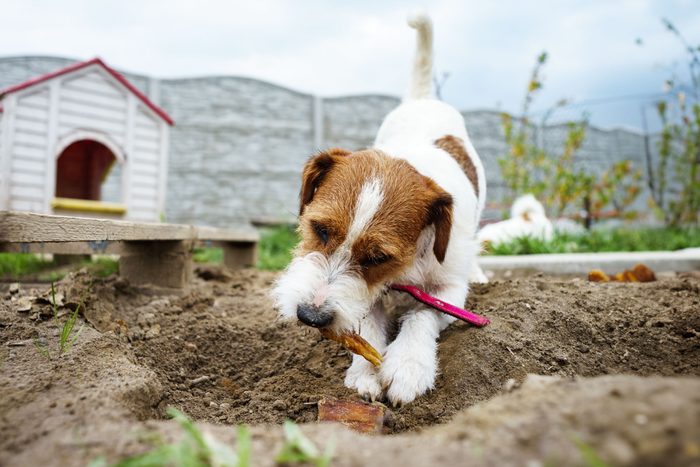
Remember that dogs didn’t always live in houses or apartments. In fact, they were once wild animals and share a common ancestor with gray wolves. Much of what they do today can be explained by looking at that heritage, and burying bones is no exception. Before they got their food in fancy bowls, dogs hunted for their dinner, and there was competition for those meals. So let’s look at some of the reasons why dogs bury bones.
It’s an instinct
Many canid species cache their food, meaning they dig a hole and bury food in it for later. But what purpose does that serve? A study in Behavioural Processes that looked at caching in red foxes, coyotes and gray wolves states that “food caching gives animals a biological advantage over non-cachers, as it allows for the control over the availability of food in harsh or changing environments.” In other words, animals that bury their food for later are playing it safe in case of a proverbial rainy day.
And as dogs evolved from a wolf ancestor, they play it safe too, whether they are free-roaming or living as pets. Rachel Lane is a certified behavior consultant, dog trainer and the owner of the dog-training company Leash & Learn. She says burying food like bones is rooted in a dog’s genetics and may have once been essential for survival, as it serves as an advantage in case of a food shortage. “Even though most companion dogs do not experience a lack of food, they still may bury their bones and other resources because it is instinctual,” she says.
So if it’s an instinct, is it equally strong in every dog? The connection to ancestral roots may seem obvious in wolflike dogs such as huskies or German shepherds, but do dogs like pugs and bulldogs dig and bury too? According to celebrity dog trainer Nicole Ellis, dogs that are bred to hunt and chase are the ones that most often bury things. However, digging is an innate desire of many dogs. “Some dogs may simply enjoy the act of digging without the act of hiding something,” she says.
Indeed, any dog may hide or bury items, even if it’s not typical for the breed. A recent study in Science looked at how dog genetics align with breed characteristics. The researchers discovered that greyhounds weren’t big on burying their toys. In fact, 90% of the greyhounds in the study never performed that behavior. However, three of the greyhound subjects were described by their owners as “frequent buriers.” So even when you might not expect it, a dog can love digging and burying bones.
It keeps their food fresh
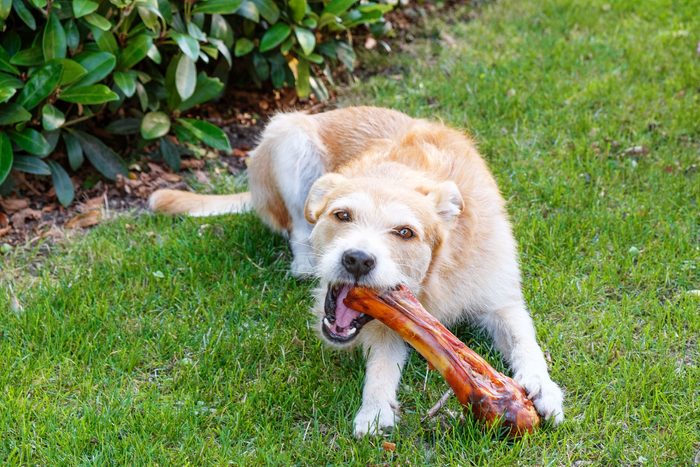
It’s obvious a buried bone is hidden safely for later, but will it be any good when the dog returns to enjoy it? After all, it will be covered in dirt. Ellis says burying meat in the soil is actually a way of preserving it because it won’t go rancid as quickly as it would if it was left sitting in the hot sun. No wonder that instinct to cache is so strong.
But dogs will bury items even inside the house. If you have one of those pets, you’ve probably wondered, Why does my dog hide his treats under my pillow? It’s the same caching behavior. Lane says that when your dog can’t get outside to bury a beloved object, it will do so inside instead. “Burying toys, bones and treats under pillows or blankets serves the same function as burying these items in the dirt–it’s to save them for later and to prevent predators and competitors from accessing them,” she says.
Whether it’s inside or outside, do dogs remember where they buried their bones? Or are they just sniffing for them with their superior sense of smell? Of course, dogs can find hidden food by smell alone, but veterinary psychiatrist Sagi Denenberg, DVM, a diplomate of the American College of Veterinary Behavior, says dogs remember where objects are hidden too. “We know they also use memory because tests show that even if other areas are smell-baited, they still choose based on memory,” he says.
In fact, a recent study in PLOS ONE discovered that both wolves and dogs are able to use spatial memory, the ability to recall the location of objects, to find cached food. When the animals watched the experimenters hide the food, they retrieved more caches and were more efficient for the first few caches than if they searched by smell alone. The researchers concluded that the animals don’t “simply rely on scent to find the rewards.”
It helps them cope with anxiety
Dogs may also bury bones and other items in an attempt to prevent any competitors from accessing them. But due to this, burying can be tied to canine anxiety and resource guarding, a behavior in which dogs feel a need to protect and defend objects they deem important. Lane says this motivation for burying is more common in dogs that live with other dogs and those that have or have had scarce resources.
Dr. Denenberg explains that all resource guarding is rooted in anxiety, whether that guarding involves the owner’s attention, spaces or toys and food. The dog is worrying about losing something it needs now or will need in the future. “It is a question of value and anxiety,” he says. “If the dog values the item [like food or toys], it will protect it.”
Ellis adds that digging is a soothing behavior for some dogs, so anxious dogs may do it more often. Burying can also help a nervous dog protect its resources, even if there is more than one bone or toy available. For example, if there is another dog around, burying the object will help calm the anxious dog, as it knows it can come back to eat or play with the object later when it’s alone and feels more comfortable.
It relieves boredom
Dr. Denenberg lists a final reason dogs bury items: boredom. Dogs that don’t have enough to do or that live in an environment that lacks enrichment often turn to digging as an outlet for excess energy. Plus, he says, “a bored dog may hide a resource if they need [or] want it in the future.”
How to stop your dog from digging and burying things
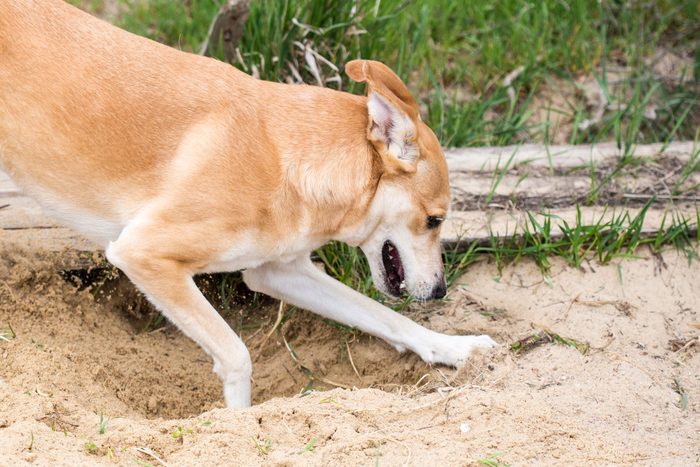
“If the digging is not bothering the owner, becoming compulsive, somehow causing physical harm to the dog or contributing to resource guarding, it’s fine to let your dog dig as much as they want,” Lane says. But if you want to save your garden, the following strategies will help curtail your dog’s digging and burying behavior.
- Provide your dog with an appropriate outdoor digging spot. For example, Ellis recommends filling a kiddie pool with sand or dirt and encouraging your dog to dig and bury in that location instead of in the yard.
- Keep a variety of bones and toys in rotation so your dog doesn’t become bored with what it has available. But Lane suggests not having too much of a surplus to encourage your dog to use what’s available versus stashing extras away.
- Ensure your dog has sufficient resources to avoid the need to resource guard. Dr. Denenberg suggests training your dog to leave toys in a dedicated container in a quiet corner of the house. Show your dog the container and place some treats there so your dog learns to visit the location. Then place its favorite toy or chew inside and encourage it to take the item there instead of burying it somewhere else.
- Teach your dog to love its crate and go there when it wants to chew or play with a bone or toy. Then encourage your dog to leave the bone in the safety of its crate when it’s finished.
- Give your dog an indoor digging toy, like the iDig by iFetch. This toy has a plastic base containing layers of machine-washable flaps. You can hide treats inside the flaps and let your dog “dig” them out.
- Teach your dog to go to its place, like a dog bed or crate, and reward it with its bone when it’s there. This will teach your dog where it’s appropriate to enjoy that treat. Make sure it’s a safe place where other animals can’t steal your dog’s bone.
- Redirect your dog if you see it digging. Don’t reprimand it but rather call it over to you and reward it heavily for leaving the area and coming to you.
- Add walks and playtime to your daily routine to fight doggy boredom. If your dog has other stimulating outlets, it will be less likely to dig and bury for entertainment.
- Put digging on cue. Then, Lane says, you can ask your dog to dig at specific times and in specific places that are convenient for you.
Why trust us
At Reader’s Digest, we’re committed to producing high-quality content by writers with expertise and experience in their field in consultation with relevant, qualified experts. For this piece, Stephanie Gibeault, MSc, CPDT-KSA, tapped her experience as a certified professional dog trainer and journalist, and then Wailani Sung, DVM, a veterinarian who owns Bay Area Vet Behavior, gave it a rigorous review to ensure that all information is accurate and offers the best possible advice to readers. We verify all facts and data, back them with credible sourcing and revisit them over time to ensure they remain accurate and up to date. Read more about our team, our contributors and our editorial policies.
Sources:
- Rachel Lane, CBCC-KA, CPDT-KA, MSc, certified behavior consultant, dog trainer and owner of the dog-training company Leash & Learn in New York City; email interview, March 11, 2024
- Nicole Ellis, CPDT-KA, author of Working Like a Dog, celebrity dog trainer and expert dog trainer on Amazon Prime’s The Pack; email interview, March 5, 2024
- Sagi Denenberg, DVM, veterinary behaviorist at North Toronto Veterinary Behaviour Specialty Clinic; email interview, March 5, 2024
- Behavioural Processes: “Revisiting the concept of behavior patterns in animal behavior with an example from food-caching sequences in Wolves (Canis lupus), Coyotes (Canis latrans), and Red Foxes (Vulpes vulpes)”
- PLOS ONE: “Observational spatial memory in wolves and dogs”
- Science: “Ancestry-inclusive dog genomics challenges popular breed stereotypes”
When my son was diagnosed with autism at age 4, I had mixed emotions. I was relieved to finally have an explanation for his developmental delays and rigid behaviors, but I worried about his future—life is often harder for those who dance to a different drum. It took me a while to embrace some of those unique traits and to see strength in difference.
I was helped along this road by a friend who shared the poem “Kids Who Are Different” by Digby Wolfe. The last lines really hit home:
“For when they have grown, as history’s shown,
It’s their difference that makes them unique!”
Since then, we’ve strived to live life to its fullest and dream big for our son. We celebrate his love of nature by exploring national parks, make travel easier by visiting autism-friendly resorts and try to educate others about autism to promote inclusivity and acceptance.
April is Autism Awareness Month, a designated time to talk about autism, celebrate individuals on the autism spectrum and raise awareness about the neurodevelopmental disorder that affects 1 in 36 children in the United States. For parents out there with a recently diagnosed child, or individuals who have received a diagnosis as an adult, let the words of those who have lived, researched and written about autism lift your spirits, like Wolfe’s words lifted mine. Read on for 20 inspirational quotes about autism for Autism Awareness Month.
1. “I am different, not less.” ―Temple Grandin, professor, author, animal behaviorist and autism self-advocate
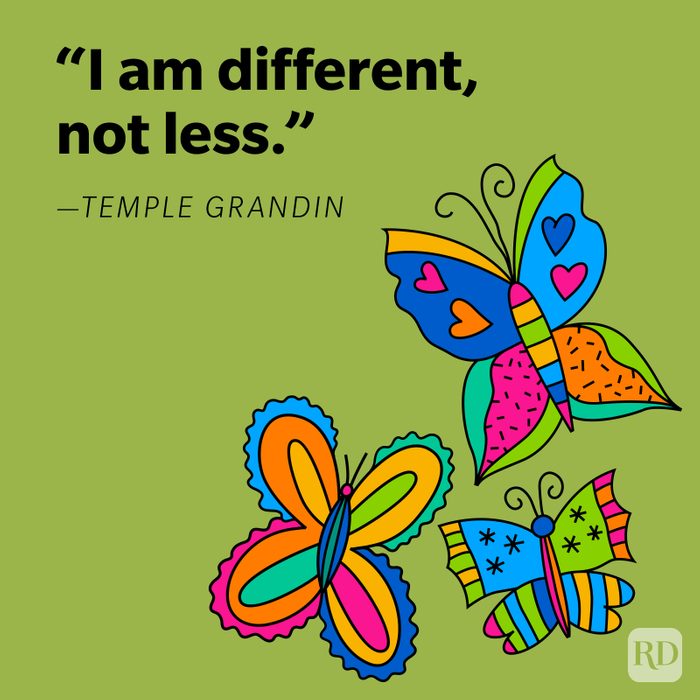
2. “There is no ‘real’ child hidden behind the child you know. Look at him—that’s your kid. Love him—he’s your kid. Enjoy his strengths and quirks—they make up the unique person who is your kid. But also help him overcome his areas of weakness—he’s your kid and you owe him that.” —Lynn Kern Koegel, co-author, Growing Up on the Spectrum
3. “People think autistic people don’t have empathy, but that’s not true. Sometimes I can’t tell if someone’s upset, but once I know, I feel lots of empathy … maybe even more than neurotypicals.” —Sam Gardner, character with autism on the hit TV show Atypical
4. “I don’t want to be a genius or a freak or something on display. I wish for empathy and compassion from those around me, and I appreciate sincerity, clarity and logicality in other people. I believe most people—autistic or not—share this wish. And now, with my newfound insight, I’m on the way to achieving that goal. I hope you’ll keep those thoughts in mind the next time you meet someone who looks or acts a little strange.” —John Elder Robison, author, Look Me in the Eye: My Life with Asperger’s
5. “When raising a child with a disability a parent doesn’t always enjoy the typical things that so many other parents take for granted—i.e. first words, riding a bike, crossing the monkey bars, etc. We parents of children with disabilities don’t take anything for granted. Everything my son did was a miracle. I like to reverse the astronaut’s quote and say, ‘What is one small step for a typical kid is a giant leap for my special child.’ Every seemingly small achievement is a miracle to me.” —Elaine Hall, neurodiversity advocate and pioneer
6. “I used to think, when I was first diagnosed with Asperger’s Syndrome—a form of autism—about what I can’t do, rather than what I can do, which was a mistake in thinking.” —Merrick Egber, administrative assistant and Els for Autism Foundation Chair of the Advisory Board
7. “There is no doubt that autism makes my life difficult, but it also makes my life beautiful. When everything is more intense, then the every day, the mundane, the typical, the normal … those things become outstanding.” —Erin McKinney, basketball operations assistant with the Memphis Grizzlies
8. “If you’ve met one person with autism, you’ve met one person with autism.” —Stephen Shore, professor, autism advocate and person living with autism
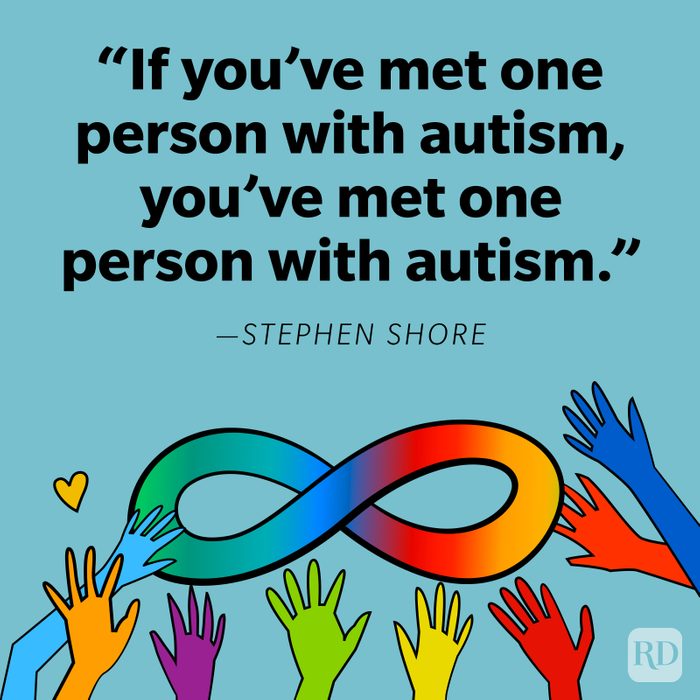
9. “Trying to fit in just seems like too much of a hassle for me, and I would much rather make friends with people who can accept me for who I am, since that is the very thing that makes a friendship a friendship. Though it may be difficult for some people on the spectrum to make and keep friends due to the complexity of friendships, any friend who has the understanding and acceptance they are looking for is going to be very lucky.” —Kaitlin Smith, author, Take It from the Expert: Sixteen Years of Experience Living on the Autism Spectrum
10. “Autism doesn’t come with an instruction guide. It comes with a family who will never give up.” —Kerry Magro, disability advocate, national speaker and bestselling author
11. “I work hard to celebrate my son Bennett’s milestones, like learning to put his shoes on and hopping on one foot and singing ‘Bingo,’ because for Bennett, little triumphs that go unnoticed in other children are huge; they are small steps on his slower, windier road to (fingers crossed) independence. We don’t know where the road will go, so we try to enjoy the bumpier ride.” —Lisa Kadane, journalist whose son has autism
12. “Autists are the ultimate square pegs, and the problem with pounding a square peg into a round hole is not that the hammering is hard work. It’s that you’re destroying the peg.” —Paul Collins, author whose son has autism, from his book Not Even Wrong: A Father’s Journey into the Lost History of Autism
13. “Look, I know I sometimes say or post strange things, but that’s just how my brain works. To anyone who’s been offended, I just want to say I reinvented electric cars, and I’m sending people to Mars in a rocket ship. Did you think I was also going to be a chill, normal dude?” —Elon Musk, founder of Tesla and person living with Asperger’s Syndrome
14. “I might hit developmental and societal milestones in a different order than my peers, but I am able to accomplish these small victories on my own time.” —Haley Moss, attorney with autism and autism advocate
15. “Wanting to be free
Wanting to be me
Trying to make people see
And accept the real me.”
—Scott Lentine, autism self-advocate who writes poetry
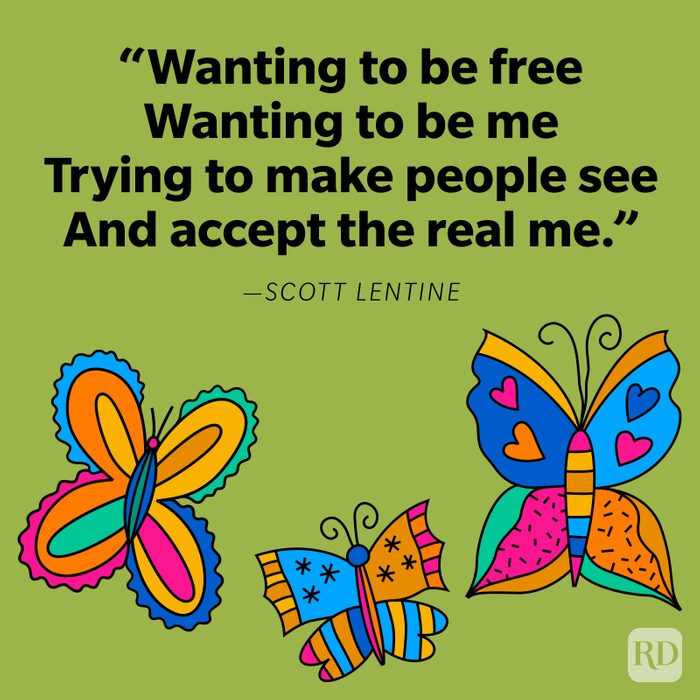
16. “What would happen if the autism gene was eliminated from the gene pool? You would have a bunch of people standing around in a cave, chatting and socializing and not getting anything done.” ―Temple Grandin, professor, author, animal behaviorist and autism self-advocate, from her book The Way I See It: A Personal Look at Autism & Asperger’s
17. “I believe that inside every person who is bullied there is a strength and a tenacity to survive. You don’t always know that this strength exists, but if you make it through those dark times, you become aware. You become a survivor, someone whose courage and spirit is far stronger than all of the hate and cruelty of their bullies. The one thing that I want to impart to children with autism is knowledge of their own inner strength, and the belief that one day at a time, they, too, can get through this.” —Amy Gravino, autism advocate
18. “It takes a village to raise a child. It takes a child with autism to raise the consciousness of the village.” —Elaine Hall, neurodiversity advocate and pioneer
19. “I’ve learned that every human being, with or without disabilities, needs to strive to do their best, and by striving for happiness you will arrive at happiness. For us, you see, having autism is normal—so we can’t know for sure what your ‘normal’ is even like. But so long as we can learn to love ourselves, I’m not sure how much it matters whether we’re normal or autistic.” —Naoki Higashida, author of The Reason I Jump
20. “No matter how many ways life’s circumstances attempt to restrict me from being ‘normal,’ I’ve learned that when we try to look past ‘labels’ and resist the urge to limit ourselves and others, we will learn to finally start living. We will learn to believe in our greatest potential. We will learn that we are all strong.” —Lamar Hardwick, The Autism Pastor
Source:
- “Kids Who Are Different” by Digby Wolfe
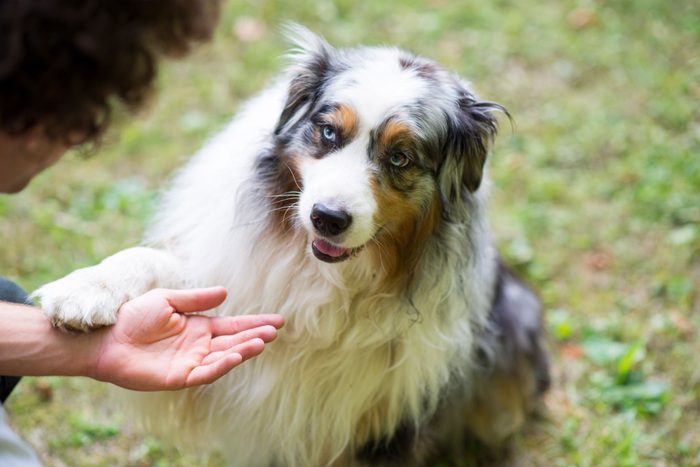
It’s an all-too-familiar scenario: You’re watching TV or attempting to work when you’re interrupted by your dog pawing at your leg. That small action can turn any pet owner into an amateur sleuth bent on answering a single question: Why do dogs put their paw on you? Do they want attention? Did you forget to serve dinner? Or are they just saying “hello”?
Let’s face it: Dogs can be a total mystery sometimes. If only we could ask them what they were thinking, we would have a much better time understanding dog behavior. And the more we understand what our dogs are trying to accomplish, the better we can respond. That might involve giving a dog affection or teaching it a less demanding way to communicate.
In over 13 years as a certified professional dog trainer—and even longer as a dog owner—I’ve been pawed plenty of times. It’s especially common during training classes; it doesn’t take much time for my canine clients to sniff out the freeze-dried liver in my pockets. That’s given me particular insight into the question of why dogs put their paw on you. Luckily, we have a very good idea of their motivations. Read on to learn the different things dogs are saying with their paws.
Get Reader’s Digest’s Read Up newsletter for more pet insights, humor, travel, tech and fun facts all week long.
About the experts
|
Why do dogs put their paws on you?
Chances are, your dog learned that pawing you is a great way to get a response. As veterinary behaviorist Isabelle Bazin, MV, DES, of the Daubigny Veterinary Center in Quebec City points out, pawing is hard to ignore. “It might happen through trial-and-error learning, but because there is physical contact, there is a good chance the human is going to react,” she says. But what are you reacting to? Is your dog pawing to ask for something, or is it just an annoying way to demand affection? Let’s look at the top reasons dogs use their paws.
They’re communicating with you
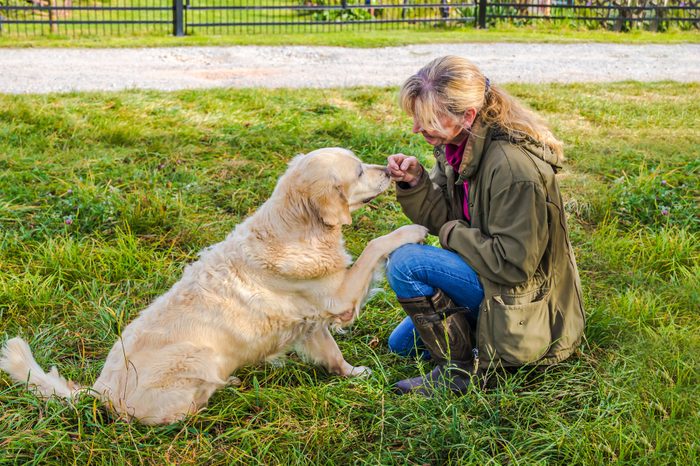
Dogs communicate using vocalizations, olfactory signals, facial expressions and body language, says certified behavior consultant and dog trainer Rachel Lane, CBCC-KA, CPDT-KA, MSc, owner of the dog-training company Leash & Learn. Their body language repertoire is vast, and it includes the use of their paws. So just as your dog stares at you to tell you something, it may also put its paw on you.
Certified behavior consultant and dog trainer Valerie Balwanz, CBCC-KA, CPDT-KA, points out that dogs use their paws to communicate with other dogs too. “Dogs will often paw at another dog in an attempt to get them to play,” she says. “Because dogs include us in their social circles, they use these communication signals with us too.”
Just how much communicating a dog will do with its paw depends on the pup’s personality. When a dog lacks frustration tolerance (the ability to deal with frustrations), the behavior is even more noticeable. Are you taking too long to prepare your dog’s dinner or folding the laundry when it’s time for a walk? Be prepared to feel that paw.
You can use that pawing behavior to your advantage, though, especially if you enjoy trick training with your dog. “If your dog is using their feet a lot, it’s fun to capitalize on this and teach them some tricks where they would use their paws, such as ‘shake,’ ‘high-five,’ ‘wave’ or ‘hit a buzzer,'” Balwanz says.
They’re showing affection
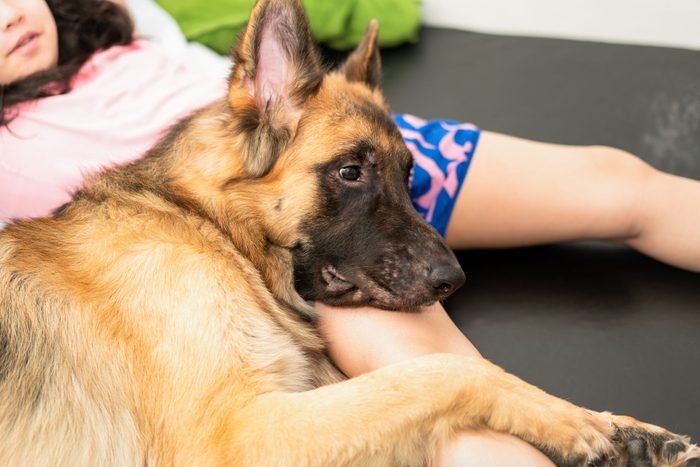
Rather than scratching at their favorite human, some dogs like to rest their paws on people in what looks like the canine version of holding hands. Why do dogs put their paw on you in this way? And do dogs love you if they put their paw on you?
Balwanz says dogs enjoy being in physical contact with people they know and trust. “If your dog is pawing at you to ask for petting or resting their paw on you while cuddling, it certainly indicates a special level of comfort and affection they wouldn’t exhibit with a stranger,” she says.
Dr. Bazin agrees that some dogs are looking for ways to be in contact with their family members. You probably recognize that your dog lying side by side with you is a sign of trust and love. Resting a paw on you is another way for your dog to show how it feels. And although it seems like a stripped-down version of cuddling together, it doesn’t mean your pup likes you any less.
They’re trying to get your attention
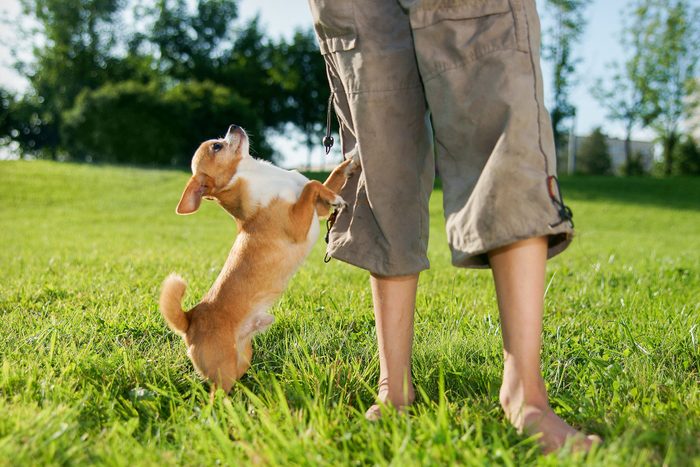
Another reason dogs paw at you is because they’ve learned it’s a great way to get your attention. “Dogs repeat behaviors that work to get them something that they want,” Balwanz explains. “In the case of pawing at you, there is a good chance your dog tried this once, or it happened accidentally, and it resulted in something that they wanted, probably your attention. Your dog learned ‘pawing at my person makes them pay attention!’ The pawing then gets repeated and works again. Because it works, your dog keeps doing it.”
In Dr. Bazin’s opinion, pawing is usually related to attention-seeking. “I think most of these dogs have been taught to shake a paw, and they have learned that when they do that, people are very happy. The dogs get treats, and they get attention. Then they try to reproduce that to get treats or attention in other contexts.”
They need something
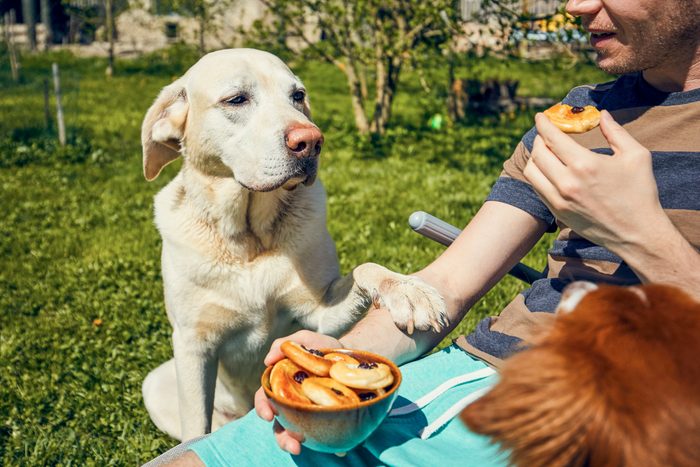
Lane points out that there are other rewards for putting a paw on somebody besides attention. For example, the dog might like food, time to play, a chance to go for a walk or the opportunity to potty outside.
Why do dogs put their paw on you when they want something instead of, say, barking or rubbing up against you? Chances are, your dog has used pawing to get something in the past. Now it sees the action as a way to express its needs.
Dr. Bazin says that when something works, and pawing usually does, the dog is going to continue that behavior and won’t try another way to get what it wants as long as it keeps working. Therefore, if you fill your dog’s water bowl when it paws at you, you’ve now established pawing as a way to ask for water. Your thirsty pooch won’t ask for water with a different behavior until you stop responding to pawing by filling the water dish.
They’re bored
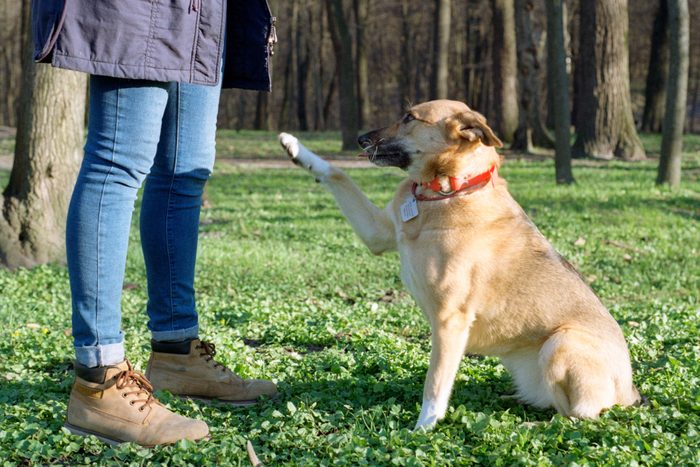
Our pups know that we’re often the bearers of entertainment, providing them with games and toys. So they may paw at us when they’re bored. “They know that the person is often the source of reinforcers, and they are looking for something to do or some sort of enrichment,” says Lane. The best way to handle that is to provide for your dog’s needs. If you’re too busy to play, for example, she suggests giving your dog some sort of puzzle toy or a food-stuffed toy to help prevent pawing.
Dr. Bazin advises prevention first. For instance, if your dog regularly paws you at a certain time of day to tell you it has to go potty, schedule your walks for that time so your dog won’t need to ask. And keep those enriching toys in your dog’s environment so it can use them to stay physically and mentally active. “Then he will ask less of you at those times because he’s better in general,” she says.
They’re anxious
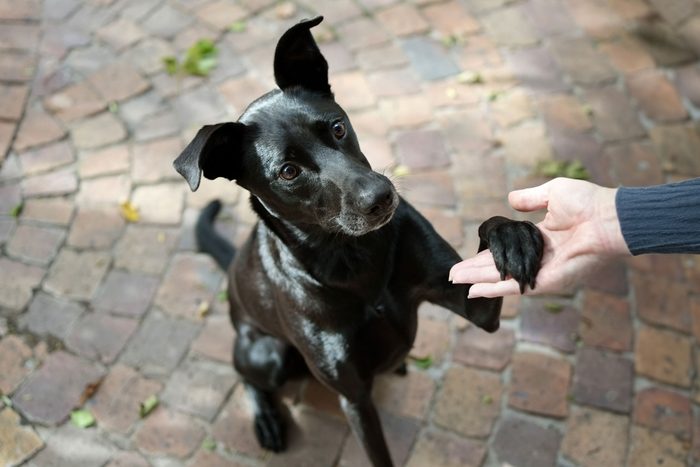
Although pawing can be normal in certain circumstances, excessive pawing may be a sign of dog anxiety. Dr. Bazin recently saw a dog that, when staying with the owner’s mother, would paw the mother 10 to 15 times a day to get whatever it needed, including potty breaks and treats. It was a nervous dog that had a hard time resting and calming down, and pawing was a way for it to express its stress and anxiety.
Of course, you’ll know if your dog is acting out of anxiety only if you assess the entire situation. Dr. Bazin recommends looking at the dog’s body language. I always look for subtle signs, including a tucked-in tail, pulled-back ears, lip licking and yawning.
Putting a paw on you may be a way for your dog to seek social support, says Lane. It can be a signal that your pup feels ill-equipped to deal with its current situation and is asking you for help. She suggests you respond to this kind of pawing, as your dog needs you at that moment.
“This can help dogs learn healthier ways of coping with stress in the future, as well as develop a positive relationship between dog and owner,” says Lane. “When a dog is pawing at the person because they are anxious, it is also important to work with a dog trainer or behavior consultant to address the underlying anxiety and fear so that it resolves in the future.”
How to stop a dog’s pawing habit
If you’ve provided for your dog’s daily needs, including sufficient exercise and mental stimulation, and it is still pawing at you, that’s likely because it has learned that pawing gets it what it wants. In that case, to eliminate the behavior, you need to ignore it completely.
Dr. Bazin warns that, when training your dog out of this behavior, you shouldn’t move toward or look at your dog when it’s putting its paw on you—even a glance is attention. You might think you’re punishing your dog by yelling, “Bad dog!” But that could actually be reinforcing because it’s attention, and that’s what the dog is looking for.
Be aware that when a behavior is no longer reinforced, such as when you ignore your pup, the intensity of that behavior will likely increase before it gets better. If you react in that moment, you will only create an even bigger problem, so you absolutely must continue to ignore the behavior until it finally disappears. It can be a long process, and it requires consistency and the entire family’s participation.
The last part of breaking your dog’s pawing habit is to reinforce the behavior you would like to see in its place. It’s essential to never take good behavior for granted. “If you want your dog to bring the ball instead of pawing at you, then if he brings the ball to you, please give him attention and give him a treat,” says Dr. Bazin. “You’re going to reinforce the behavior you really want in your dog.”
Why trust us
At Reader’s Digest, we’re committed to producing high-quality content by writers with expertise and experience in their field in consultation with relevant, qualified experts. For this piece, Stephanie Gibeault, MSc, CPDT-KSA, tapped her experience as a certified professional dog trainer and journalist, and then Wailani Sung, DVM, a vet with a board certification in veterinary behavioral medicine who owns Bay Area Vet Behavior, gave it a rigorous review to ensure that all information is accurate and offers the best possible advice to readers. We relied on reputable primary sources, including certified canine behaviorists and dog trainers, as well as our writer’s personal experience. We verified all facts and data and backed them with credible sourcing, and we will revisit them over time to ensure they remain accurate and up to date. Read more about our team, our contributors and our editorial policies.
Sources:
- Valerie Balwanz, CBCC-KA, CPDT-KA, certified behavior consultant, dog trainer and owner of Dog Training by Valerie; email interview, March 10, 2024
- Isabelle Bazin, DVM, DACVB, veterinary behaviorist at the Daubigny Veterinary Center in Quebec; video interview, March 13, 2024
- Rachel Lane, CBCC-KA, CPDT-KA, MSc, certified behavior consultant, dog trainer and owner of Leash & Learn; email interview, March 11, 2024
There are some things we definitively know about dogs, like why dogs get the zoomies or what it means when a dog licks you. We also know they love their toys. It’s one of life’s simple pleasures to watch our pups happily chew and toss around their favorite indestructible dog toy or try to uncover the treats in a challenging puzzle toy. But when it comes to coveted toys, there’s one thing that confounds many people: What’s the appeal of squeaky toys? To mere humans, they’re kind of annoying. Yet, dogs can’t get enough of them. It’s crazy how many times a dog can make a toy squeak in an hour and then return to it later like it’s brand new! So, why do dogs like squeaky toys so much? We spoke to dog behavior experts and veterinarians for answers. Here’s what three experts say.
Get Reader’s Digest’s Read Up newsletter for more pets, cleaning, humor, travel, tech and fun facts all week long.
About the experts
Reviewed for accuracy by: Wailani Sung, DVM, a veterinarian with board certification in veterinary behavioral medicine. Dr. Sung is the director of the behavior and welfare programs at the San Francisco Society for the Prevention of Cruelty to Animals and is the co-author of From Fearful to Free: A Positive Program to Free Your Dog From Anxiety, Fears and Phobias. |
Why do dogs love squeaky toys so much?
1. Squeaky toys mimic the thrill of the chase
Here’s one popular theory shared by canine experts that answers, “Why do dogs like squeaky toys?” The squeaks sound similar to the prey they are hardwired to hunt and kill. Of course, the dogs we have as pets today don’t have to hunt for food; their food is conveniently ready to eat in a bowl each day. Still, that instinct is in their blood.
“Lots of breeds have histories that involve chasing and catching such small animals,” says veterinarian Matthew McCarthy, DVM, founder of Juniper Valley Animal Hospital in Middle Village, New York. For example, labradors and Weimaraners were bred as gun dogs, and adorable small dog breeds like the Yorkshire Terrier were once used to chase and kill rodents.
“Watching your dog tear into, shake silly and disembowel a stuffed squeaky toy until it is ‘dead’ certainly is evidence of this theory/mechanism at work,” notes Dr. McCarthy.
The theory is further reinforced by watching non-hunting breeds. For instance, the Samoyed, a sled dog, isn’t as likely to be interested in squeaky toys because it was bred to stay focused on the trail and not be distracted by small creatures nearby. But Dr. McCarthy points out that this isn’t a hard-and-fast rule, as some breeds, regardless of their ancestral past, may still love squeaky toys.
2. Squeaky toys activate the feedback loop
Think of it this way: When something feels good and is fun to do, you want to keep doing it. The same is true for dogs, of course. When a dog chomps down on a squeaky toy, they hear a sound that triggers an immediate gratifying auditory reward, which, of course, is one of the reasons why dogs like squeaky toys.
“Several studies have shown that certain sounds like those a squeaky toy makes trigger reward centers in the brain to release the feel-good chemical dopamine—much like a runner’s high,” says Dr. McCarthy. Those happy feelings encourage your pup to return to the squeaky toy repeatedly, instilling a feedback loop. That makes sense!
3. Squeaky toys are an invitation to play
From the subtle signals of a dog’s tail to the more obvious signs of an anxious dog hiding under the bed, pet parents can pick up certain communication cues from their dogs. But other messages from our pups are more cryptic and charmingly clever. Have you ever noticed that your pup often likes to play with the squeaker toy right next to you? Why do dogs like squeaky toys when they are in your vicinity? There may be an ulterior motive.
According to Dr. McCarthy, as soon as we engage with them by picking up the squeaky toy, it releases dopamine and oxytocin, which cements their bond with us. “When the dog interacts with the squeaker toy, she is reinforced both by the toy itself as well as with attention from the person,” adds Karen Sueda, DVM, a veterinarian at VCA West Los Angeles Animal Hospital.
4. Squeaky toys seem like real prey
A squeaky squirrel has a tail your pooch may love to swing around and chomp on to make it squeak. Or maybe he goes nuts over his favorite goose toy, wildly shaking it to activate the squeaking sound. You’re not imagining it: Your dog likely loves this pastime because these toys look and sound like real prey. And it’s not just the resemblance of prey or the ear-piercing shrieks that makes this so appealing. Dogs like squeaky toys because they go back to that instinctual nature of hunting, killing and tearing up the prey.
“The squeaker hiding inside comes to somewhat mimic the internal organs of critters,” says Adrienne Farricelli, a certified professional dog trainer at Brain Training for Dogs. “No wonder Rover is so intent biting into it! It squeaks like an animal, and on top of that, it’s so fun to unstuff and disembowel—much to the owner’s dismay.”
High-pitched vs. low-pitched squeaky toys
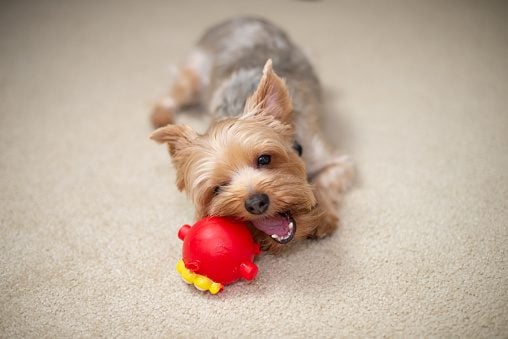
Does your dog act differently when playing with high-pitched and low-pitched squeaky toys? Maybe. “Generally, high-pitched, staccato noise tends to encourage activity, while lower-pitched, longer-duration noise tends to be more calming,” Dr. Sueda says.
Still, some dogs aren’t fans of squeaky toys, no matter what they sound like. “If the dog shies away or seems fearful when you squeak the toy, the sound may bother her,” Dr. Sueda explains.
It’s no big deal from an entertainment perspective if your dog doesn’t enjoy playing with squeaker toys, but the lack of interest could point to other mental and health woes. “If the dog experiences a lot of sound sensitivities, consult with your veterinarian about ways to address your dog’s more general fear of noises,” advises Dr. Sueda. Also, your pooch may have dental or oral pain that prevents him from chomping down to activate the squeaker.
How to use squeaky toys for training
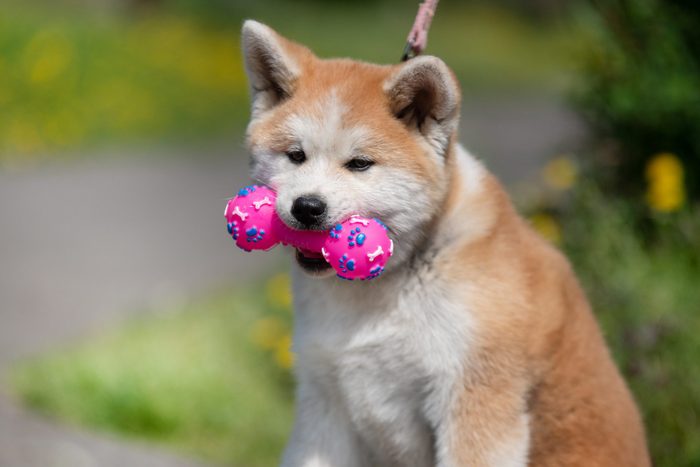
Just when you thought you knew all the dog trainers’ training secrets, the squeaker toy comes along and proves you wrong. Whether it’s a squeaky rope or chew toy, it can be a sneaky way to reinforce your dog’s behaviors, Farricelli says. “Hide a squeaky toy behind your back, call your dog, and reinforce him for coming to you by praising and providing access to the toy as you squeak it and toss it for him to catch.” The squeaker’s sound can also divert your dog’s attention from something they shouldn’t be getting into or unwanted behavior like nipping.
Perhaps the most fun way to utilize a squeaker toy is to capture your dog’s attention when taking pictures. While your dog is in a solid sit/stay position, squeeze the toy to get his full attention. “I get the best pictures this way as they are sitting nicely composed while their ears are perked up, their eyes are bright, and they have a focused, alert expression,” says Farricelli. If she’s lucky enough, she gets the adorable head tilt, too!
Are squeaky toys okay for dogs?
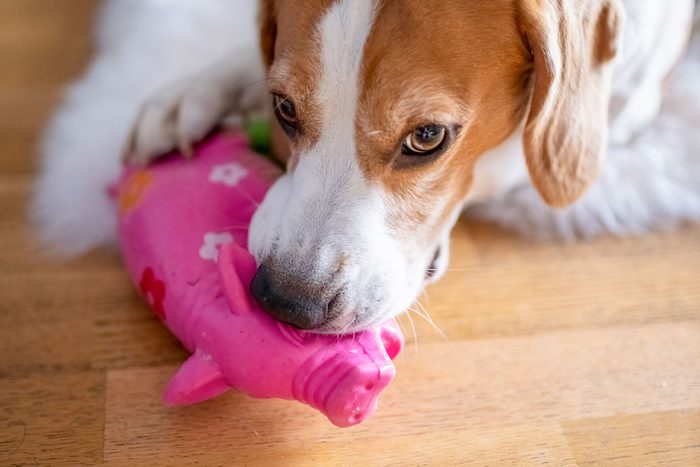
What’s the danger in some good, old-fashioned, instinctual fun? Nothing … unless your pup ingests the squeaker or stuffing after he’s torn the toy to shreds. Dr. McCarthy says that some of his patients pass the material and squeaker when they poop, while other dogs end up with an intestinal blockage that requires surgery to remove them. That’s why it’s so important to keep an eye on your dog when he’s playing with toys, especially squeaky ones.
Equally important is training your dog early on to “drop it” or “leave it” on cue. But if he ignores this command and you can’t get the toy away from him, Farricelli has a suggestion: a high-value swap. Offer your dog something edible that he goes bonkers for, whether it’s a dog treat or a peanut-butter-stuffed Kong.
“The goal is to make the dog feel that when we approach him to remove a toy, we have something far better to offer,” says Farricelli. “[That helps] prevent resource guarding and teaches the dog to voluntarily give up things rather than give us a hard time—like running away with it, baring teeth or trying to bite.”
How to choose safe squeaky toys
There’s no shortage of squeaky toys to choose from. Some toys are cuter and look more fun to play with than others, but what really matters is durability and safety. Plush toys filled with stuffing are the least durable and most likely to be destroyed quickly, and you’ll have to replace them more often. “I recommend rubber or plastic toys, preferably with a raised, ridged or spiked surface, as this helps clean your dog’s teeth and gums while chewing,” Dr. McCarthy says. “And look for BPA-free, food-grade material, which means it is antibacterial and holds up better over time to dog slobber and repetitive cleaning.”
When you need a break from squeaky toys
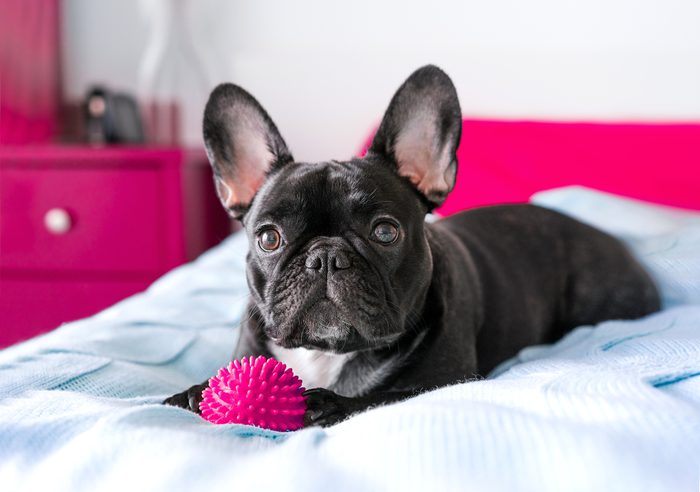
As pet parents, we might not appreciate the seemingly endless loop of the squeaker, and we might hope for what Dr. McCarthy calls a “squeakectomy.” Luckily, there’s a way your dog can still go nuts over a squeaky toy without having to sacrifice your sanity. “Dogs can hear ultra-high-pitched noises that we can’t,” Dr. McCarthy explains. “There are ‘silent’ squeaky toys that operate in these human-sparing frequencies that have all the benefits without the noise!”
Why trust us
At Reader’s Digest, we’re committed to producing high-quality content by writers with expertise and experience in their field in consultation with relevant, qualified experts. For this piece, Lisa Marie Conklin tapped her experience covering pet behavior and training, and then Wailani Sung, DVM, a vet who works at the Behavior Specialty Clinic part of the San Francisco SPCA, gave it a rigorous review to ensure that all information is accurate and offers the best possible advice to readers. We verify all facts and data, back them with credible sourcing and revisit them over time to ensure they remain accurate and up to date. Read more about our team, our contributors and our editorial policies.
Sources:
- Matthew McCarthy, DVM, veterinarian and the founder of Juniper Valley Animal Hospital; interview, November 2022
- Karen Sueda, DVM, veterinarian with a board certification in veterinary behavioral medicine at VCA West Los Angeles Animal Hospital; interview, November 2022
- Adrienne Farricelli, a certified professional dog trainer at Brain Training for Dogs; interview, November 2022
For animals that eat out of the garbage and roll around in the grass, dogs sure do love their creature comforts, especially a snugly place to sleep. From a cozy dog bed to your memory foam mattress, the softest location is often your dog’s top pick when it comes to getting some shut-eye—usually after it has twirled in an adorable little circle. But your pup isn’t the only one with that puzzling ritual. In more than 13 years as a certified professional dog trainer, I’ve heard plenty of pet owners ask, “Why do dogs circle before lying down?”
Dog behavior is a mystery to many people. And it’s no wonder! We’re two different species with different evolutionary backgrounds. You would never think of barking at the mail carrier or drinking from the toilet bowl. And you generally don’t walk in a circle before lying down to snooze. My Chihuahua, however, is a different story. He naps on a throw pillow on top of the couch, and before he lies down, he makes a “nest.” He spins in circles and paws at the cushion until his bed is just right.
This circling behavior is common in dogs, whether they’re on a blanket or in the dirt. But what exactly are they trying to accomplish, and can circling ever be a cause for concern? I talked to animal behaviorists and dog trainers and asked them pet owners’ pressing question: Why do dogs circle before lying down? Keep reading to find out what they said.
Get Reader’s Digest’s Read Up newsletter for more pet insights, humor, travel, tech and fun facts all week long.
About the experts
Reviewed for accuracy by: Wailani Sung, DVM, a vet with a board certification in veterinary behavioral medicine who owns Bay Area Vet Behavior. Dr. Sung is the co-author of From Fearful to Free: A Positive Program to Free Your Dog from Anxiety, Fears and Phobias. |
Why do dogs circle before lying down?
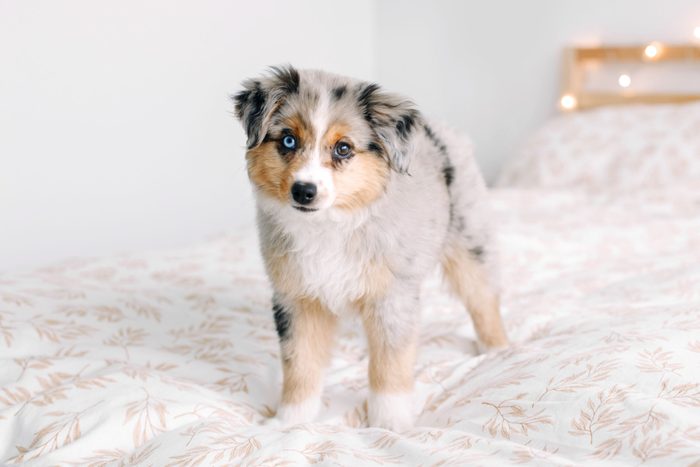
Although it’s hard to imagine your cuddly Cavapoo living in the wild, dogs share a common ancestor with gray wolves. And that ancestor defended a territory, hunted for food and slept on the ground. That heritage has left an impact on today’s pet dogs that has likely contributed to their habit of circling before they lie down.
Keep reading for the top four reasons your pup is circling before lying down.
They’re acting on instinct
Certified professional dog trainer Nicole Ellis, CPDT-KA, says there is no definitive answer as to why dogs circle. What we do know is that this isn’t a modern impulse. “It’s something dogs and wolves have been doing for a very long time,” she says.
Some experts believe a dog’s circling tendency is a genetic predisposition that stretches back to its wolf ancestors, says Mary Burch, PhD, a certified applied animal behaviorist and dog trainer. In other words, your pet’s motivations may be connected to the wolf’s reasons for circling up before bedding down.
One of those reasons could have to do with their powerful sense of smell. Ellis says some people think wolves circle before lying down to suss out the direction of the wind. Then they can arrange themselves to better sniff any intruders approaching in the night.
They’re doing a safety check
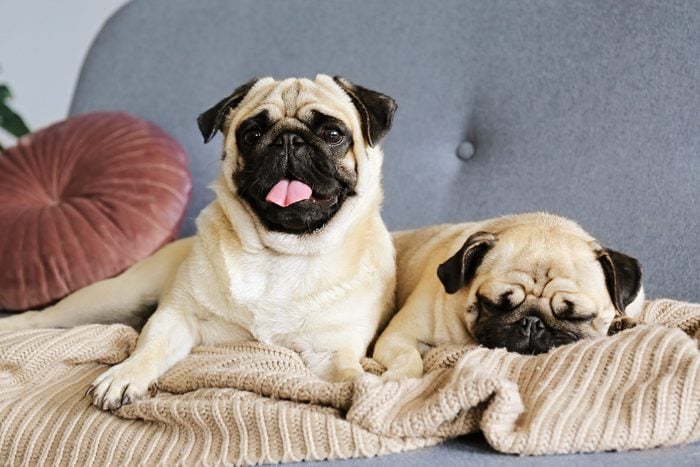
Circling before they lie down might also serve as a 360-degree safety check. Ellis says dogs’ ancestors could have circled to scan the environment and ensure their pack members were accounted for before going to sleep. Or it could have been one last look out for approaching danger.
It could have been a way to focus on nearer dangers too. Remember, the habit hearkens back to a time when plush doggy beds weren’t an option. Dirt and grass—dogs’ former sleep spaces—are very different from the environments most dogs live in today. “Some believe that their ancestors did this to stomp down tall grass and move away any snakes and insects, and it’s carried down through generations,” says Ellis.
They’re regulating their temperature
Along with circling, dogs often dig in their beds. And that may serve to help them regulate their temperature. Think about it: Digging in the dirt on a hot day will expose cooler soil underneath. And digging and circling in the snow can create a compacted nest for holding in body heat.
Burch once had a Siberian husky who loved to sleep outside in the winter, even though he was welcome inside the house. “He would turn around two to three times, as though he was patting down the snow, and lie down in a ball,” she says. “The only one who didn’t sleep well when he was outside in the snow was me—I was constantly checking to make sure he didn’t want to come inside.”
Certified behavior consultant and dog trainer Devan Amundsen, CBCC-KA, CPDT-KA, believes that modern dogs sleep curled up because the position is great at conserving heat around the core of their body. (Some of us humans even sleep curled up on our sides when we’re extra chilly!) Amundsen’s dog has a short coat with an almost bald chest and belly. “When he curls up into a little ball, it’s super obvious that his bald chest/belly gets toasty warm,” he says. “If it’s too hot out, he’ll start uncurling.”
They’re getting comfortable
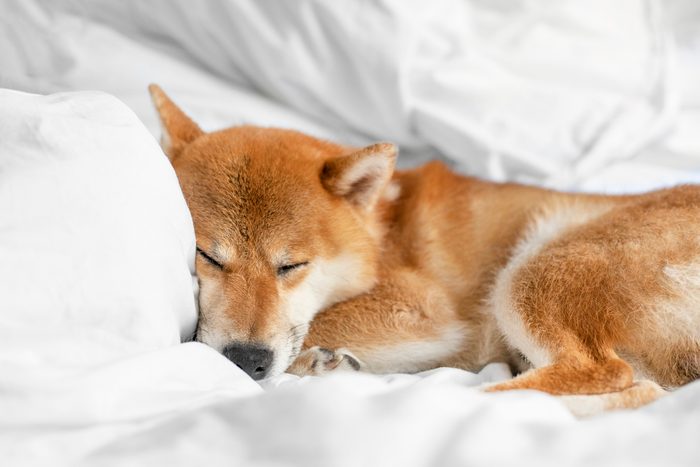
Amundsen says a reason dogs’ ancestors spun around before lying down could be as simple as getting more comfortable. “My understanding of the circling behavior is that it’s creating a relatively flat, circular spot to curl up in,” he says. “Think of how it might look if the dog was in tall grass or soft soil and did those circles. It might pat down the area, find any big uncomfortable rocks, etc.”
But what about when your dog is sleeping inside? Could comfort still be the issue? Absolutely. “With modern dogs who sleep in a cozy dog bed with padding or blankets, the dog can be circling to get the bedding just right,” Burch says. “Think of the dog who does this at bedtime as arranging the blankets and fluffing his pillows.”
When is a dog’s circling behavior a problem?
If you’re worried about your furry best friend’s over-the-top circling, take heart: Turning in circles is normal dog behavior. And it’s not limited to naptime.
Ellis notes that dogs spin in circles at other times too, such as when they are excited. Some dogs even spin around before pooping, which may be an effort to line themselves up with the Earth’s magnetic field. (A study in the Journal of Veterinary Behavior found that dogs prefer to go to the bathroom with their bodies lined up in a north-south direction.) All of that points to the fact that spinning doesn’t signify something’s wrong with your pup—but unusual or too much spinning could.
“Spinning that is excessive or out of the ordinary can be a sign of trouble that indicates the dog has a problem, such as pain [like hip dysplasia], a neurological problem or an inner ear problem [like vertigo],” says Burch.
Cognitive dysfunction in dogs may also lead to spinning, according to Ellis. This medical condition is similar to dementia in humans and can cause a dog to become disoriented and exhibit repetitive movements. Some of those movements can include head bobbing, pacing or walking repeatedly in a circle.
So how do you know when your dog’s circling behavior is cause for concern? Ellis recommends observing your pet for unusual behavior, like spinning away from the bed or having trouble walking in a straight line. Those actions would necessitate an immediate visit with your vet. Also look for signs your dog is experiencing discomfort. “If your dog is spinning for longer periods or getting up a lot after lying down and it seems it may be hard for them to get comfortable, it might be time to speak to your veterinarian and see if there is arthritis or other pain that could be affecting your pet,” she says.
FAQs
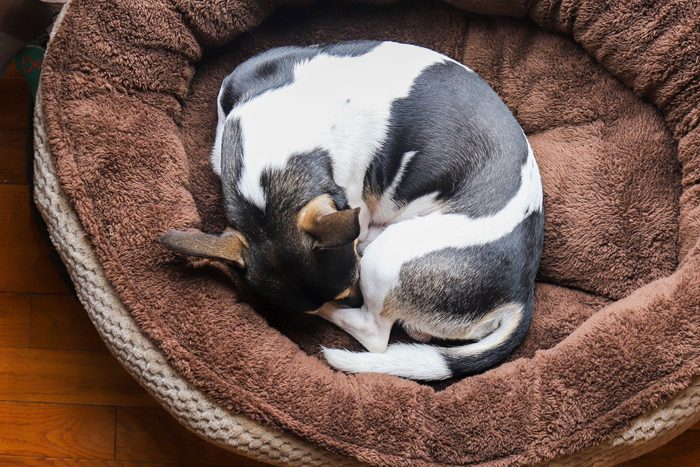
What is the fox sleeping position in dogs?
The “fox position” is a tight ball that dogs curl into before sleeping. Like circling before lying down, this common canine sleep position is also connected to dogs’ innate need for safety.
“From the early days of the ancient dog, it is thought that dogs sleep in the curled-up ‘fox position’ as a way to stay protected from animals who might be inclined to attack,” Burch says. “Sleeping in a balled-up position will ensure that an attacker can’t get to your vital organs.”
Why do dogs sleep curled up next to us?
There are a lot of reasons dogs sleep curled up next to their humans, including a desire for comfort, a sense of safety and the reminder of sleeping with their littermates when they were puppies.
Burch says dogs sleep next to us because they like us. “We give them security, and in some cases, they want to protect us,” she says. “Dogs sleep next to us as a way of being affectionate. Curling up next to one’s person can be a comfortable way for a dog to sleep—it can keep the dog warm.”
In the end, says Amundsen, it comes down to companionship. “Dogs have been by our sides for so long, both literally and metaphorically,” he says. “My own dog is curled up on his bed next to my desk right now, despite there being other bigger/softer beds available in other places in the house. Dogs are social animals. They like being around us because we’ve [selectively bred them] for exactly that for thousands of years.”
Why trust us
At Reader’s Digest, we’re committed to producing high-quality content by writers with expertise and experience in their field in consultation with relevant, qualified experts. For this piece on why dogs circle before lying down, Stephanie Gibeault, MSc, CPDT-KSA, tapped her experience as a certified professional dog trainer and journalist, and then Wailani Sung, DVM, a veterinary behaviorist who owns Bay Area Vet Behavior, gave it a rigorous review to ensure that all information is accurate and offers the best possible advice to readers. We verify all facts and data, back them with credible sourcing and revisit them over time to ensure they remain accurate and up to date. Read more about our team, our contributors and our editorial policies.
Sources:
- Devan Amundsen, CBCC-KA, CPDT-KA, certified behavior consultant, certified dog trainer and owner of Animal Welfare United; email interview, March 1, 2024
- Mary Burch, PhD, certified applied animal behaviorist, dog trainer, author of Citizen Canine and director of the American Kennel Club Family Dog program; email interview, March 11, 2024
- Nicole Ellis, CPDT-KA, celebrity dog trainer, author of Working Like a Dog and expert dog trainer on Amazon Prime’s The Pack; email interview, March 10, 2024
- Journal of Veterinary Behavior: “Directional preferences of dogs’ changes in the presence of a bar magnet: Educational experiments in Israel”
Dog parents love their pets—and want them to love them back in equal measure, as evidenced by the billions of dollars pet owners spend each year on treats, toys and more for their four-legged friends. Given this desire for affection, it’s natural that some pet parents might interpret a dog licking their face or hands as kisses or as expressions of love. But is that what they are, really?
As a board-certified veterinary behaviorist, my favorite part of what I do is educating pet parents on dog behavior and answering the multitude of questions that start with “Why does my dog … ?” One of the most common questions I’m asked is “Why does my dog lick me?”
A simple scientific answer would be that human skin is salty and dogs like the salty taste of our skin. The anthropomorphic response would be “He is telling you he likes you.” Which one is correct? Is your dog just treating you like a salt lick or do dog licks mean kisses? Read on to find out.
Get Reader’s Digest’s Read Up newsletter for more pet insights, humor, cleaning, travel, tech and fun facts all week long.
About the experts
Reviewed for accuracy by: Amy Attas, VMD, an award-winning veterinarian, the founder of City Pets and the author of |
Why do dogs lick you?
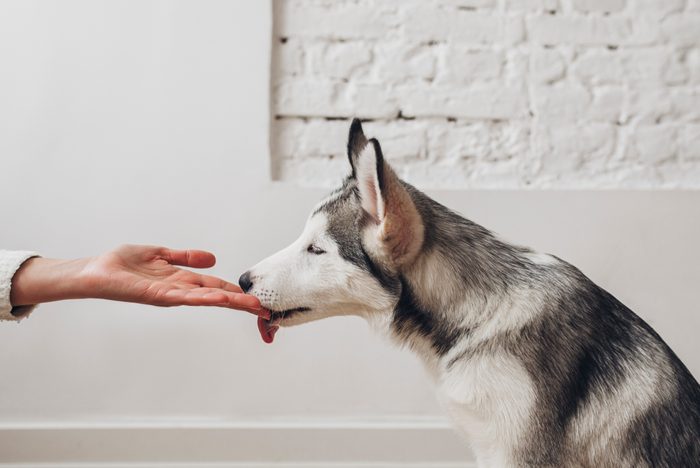
In general, licking is your dog’s way of communicating and learning more about the world. The reason (or reasons) a dog licks you depends on the animal, the situation and the person being licked.
They want a taste
Dogs receive sensory information regarding the item they lick. For example, dogs lick food to get a taste to decide if they do—or don’t—want to bite into said item. When it comes to people, some dogs may like the taste of the salt and may be more likely to lick people when they are crying or sweating. Some dogs may also lick you when your skin is wet, such as when you just stepped out of the shower.
A dog might lick your face or hands after you eat to clean up anything you did not wipe off with your napkin. (If you have toddlers, your dog may need to work extra hard.) Here, dogs are doing double duty in cleaning up the person or child and also getting a taste of human food.
They want a better sniff
The moisture from dog saliva can reactivate some volatile compounds left in dried residues, such as dried saliva or urine. Dogs may lick a person’s hands if they smell food residue on them. After a dog licks the residue, leftover volatile compounds are released into the air again and may provide the dog with additional smells.
They are saying hi
Some dogs might lick as part of their greeting behavior when they are comfortable and happy to see a person. Instead of staring at their owner to get attention, some have learned to use licking as a way to get the person’s attention. Most people find it difficult to ignore a dog that licks them, whether the lick is wanted or not, and will have some type of reaction, be it positive (looking at, speaking to or petting the dog) or negative (moving away).
They’re showing their submissive side
A puppy or other subordinate dog might lick a more confident or assertive adult dog as a way to appease it. This instinct may transfer over to a person they’re uncertain about too. Here, they’re demonstrating “I don’t know where I stand with you or whether you like me or not, so I’m going to lick you to show you that I am not a threat so you don’t get upset with me.”
Should you let your dog lick you?
Most dogs will lick you on your hands or arms, your legs if you’re wearing a skirt or shorts, or your face if they can reach it. In most circumstances, it’s fine for a dog to lick a person, as long as the person is OK with it.
When is it not OK for a dog to lick you?
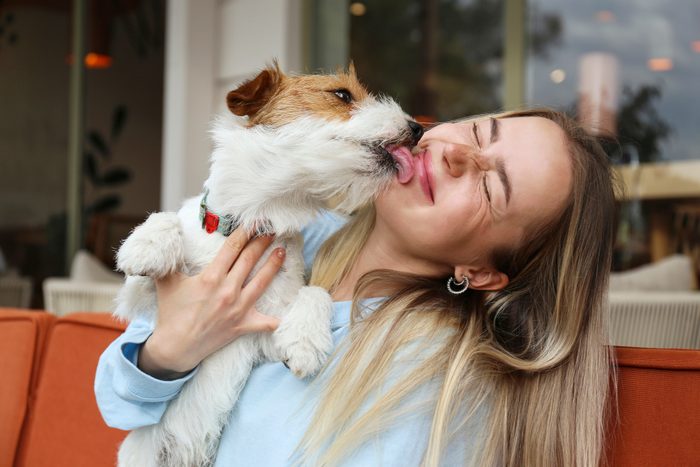
When a person is allergic to dog saliva, immunocompromised or simply does not like being licked, a dog should not lick them. People who are allergic to dog saliva should immediately wash the licked area or wipe it down with a skin-safe disinfectant wipe. Dogs should not be allowed to lick a person’s open wounds, especially if they are immunocompromised, as numerous bacteria, such as clostridia, enterococcus and streptococcus, can live in a dog’s mouth.
When is licking a problem?
Licking is normal dog behavior, and some dogs lick more than others. Licking becomes problematic when:
- A dog won’t stop licking you and you don’t want them to. Some people may be grossed out by dog saliva, and others just prefer not to feel a moist dog tongue on their skin.
- The dog continually licks you in one spot on your body. Repeated dog licks on the same area can be a bigger issue, as it has the potential to irritate your skin. The dampness and bacteria present in your dog’s saliva and on your skin can form a perfect condition for a skin infection to occur.
- A dog repeatedly licks the air or an inanimate, inedible object. This may be a sign of an underlying medical condition, such as dental disease or gastrointestinal discomfort.
- A dog licks one area of its own body repeatedly. This may be an indication that that area is itchy or painful.
Dogs that lick the air, inanimate objects or one area of their body repeatedly should be examined by a veterinarian.
How do you teach your dog to stop licking you?
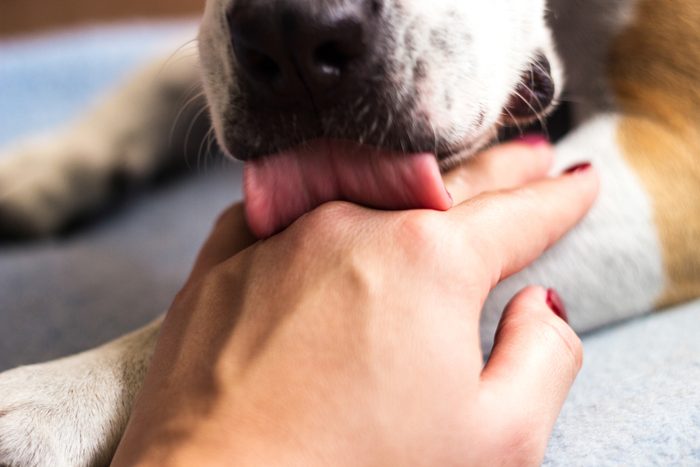
Even though licking is a normal dog behavior, if you do not like it, you can teach your dog to stop licking.
1. Redirect the behavior
The best strategy is to teach and reinforce alternate behaviors. Here’s how that works: If your dog always licks you when he approaches you, ask your dog to sit before he has a chance to lick you, then reward that behavior with a treat, a toy or praise.
2. Ignore the behavior
Another option is, the next time your dog starts licking you, simply get up and walk away, go into another room and shut the door so your dog cannot follow. Your pup will gradually learn that licking makes you go away and, if they don’t want you to leave, then they need to stop licking you. Keep in mind that you need to be consistent with your training, because it takes some time for even the smartest dog to learn the association that licking causes people to ignore him and potentially walk away.
The bottom line of dog licking
I don’t know of any research that definitively states that when dogs lick people it releases endorphins, the feel-good hormone, for the dog. However, if a dog finds licking people to be a rewarding behavior, then endorphins can be released. I think that licking causes people to pay attention to their dogs, and the positive interaction between the person and the dog is rewarding and also may release endorphins for both the human and the dog. While I do not enjoy being licked on the face by my dog, I do see it as a sign of affection.
Why trust us
At Reader’s Digest, we’re committed to producing high-quality content by writers with expertise and experience in their field in consultation with relevant, qualified experts. For this piece, Wailani Sung, DVM, a vet with a board certification in veterinary behavioral medicine, tapped her experience as a certified professional dog trainer and then Amy Attas, VMD, an award-winning veterinarian and the author of Pets and the City: True Tales of a Manhattan House Call Veterinarian, gave it a rigorous review to ensure that all information is accurate and offers the best possible advice to readers. We verify all facts and data, back them with credible sourcing and revisit them over time to ensure they remain accurate and up to date. Read more about our team, our contributors and our editorial policies.
Sources:
- Centers for Disease Control and Prevention: “Capnocytophaga”
- Journal of Veterinary Behavior: “Gastrointestinal Disorders in Dogs with Excessive Licking of Surfaces”
- PLoS ONE: “The Canine Oral Microbiome”
The belief that dogs can sense ghosts is nothing new. The Aztecs of Mexico believed dogs could not only see ghosts but also protect their people from them. They even buried dogs with their dead so that the dogs could guide the recently deceased in the afterlife. The Mayans shared similar beliefs and the Inuit people of the Arctic believed dogs had a connection to the paranormal.
So can dogs see ghosts? It depends on whom you ask—and whether that person believes in ghosts or not.
To dive deeper into the answer, Readers Digest spoke to a number of dog owners who report their dogs have seen ghosts, dog behavior experts and a pet medium. Read on to learn more about dogs and ghosts.
Get Reader’s Digest’s Read Up newsletter for pet insights, humor, cleaning, travel, tech and fun facts all week long.
About the experts
|
Can dogs see ghosts?
Several readers we spoke to shared stories of their dogs’ ghostly interactions, which led them to believe that yes, their own dogs can see ghosts.
“When we first moved into our home that was built in 1940, I could not get two of my Briards (a large herding breed) to leave the mud room—and they’re normally Velcroed to me,” shares Merry Jeanne Key Millner. “We eventually learned we had a grieving mother whose infant son died in the old kitchen (now our mud room), who a year later died herself. Our Briards didn’t want to leave her alone. Minnie (the ghost) has now embraced our crazy family and helps us find lost things!”
Joanna King shares this example about her German pinscher, Parker. “After my father died of pancreatic cancer, at times, Parker would lie down on the floor in the same position as an Egyptian sphinx and I would smell dad’s aftershave. I knew then that the conversation between Parker and my dad was starting. Parker would lift his head up and his eyes would never look anywhere else just at the room’s doorway. The scent of aftershave got stronger, then Parker would tilt his head and respond to dad vocally. When Parker stood up I knew Dad had left. These visits always brought me peace.”
And another, from Margot Keast, who calls herself “a non-professional psychic medium” and shares this story about her late dog, Twinkle, who she believed saw spirits. “I am certain that after my mother died, she would visit and Twinkle was always thrilled to see her. Twinkle would prick her ears and make a high-pitched whistle sound to communicate what she saw. Twinks would behave just like she was schmoozing and talking to her favorite person while I could feel Mum’s energy. Twinkle is now with Mum I am sure.”
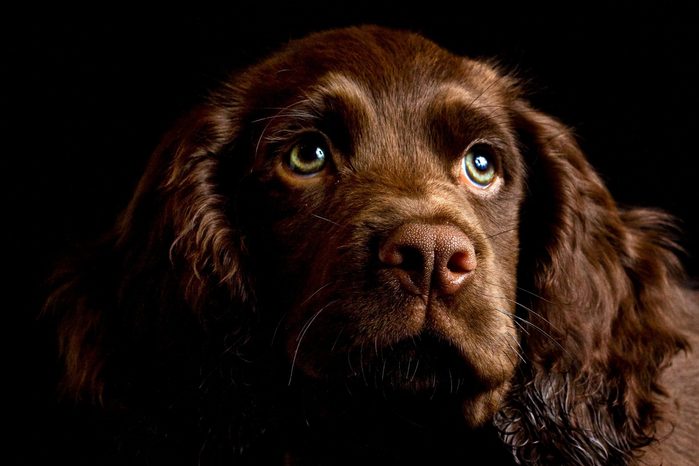
What the scientists say about dogs and ghosts
Despite what the dog owners above report, our expert scientists remain skeptical, after all there aren’t any scientific studies that prove the existence of the paranormal, such as spirits, demons or ghosts. And there certainly aren’t any studies that prove dogs can (or can’t) see spirits, demons or ghosts.
“What I suspect is happening here is people are looking at dog behavior and wanting an explanation, and being reluctant to look at the more obvious ones,” says Alexandra Horowitz, PhD, a senior research fellow and adjunct associate professor at Barnard College.
Those more obvious explanations may include a dog’s keen sense of smell and hearing. “Dogs are naturally equipped with one of the best senses of smell in the animal kingdom,” Jesus Aramendi, DVM, a former senior veterinarian for Chewy and founder of FurLife Vets in Delray Beach, Fla., tells Reader’s Digest. “A dog’s sense of smell can be 10,000 to 100,000 times more sensitive than a human’s.”
As for hearing, dogs can hear twice as many frequencies as humans. According to Dr. Aramendi, dogs can pick up sounds that are four times farther away than humans would be able to detect.
“The human part of the equation is that even when dogs are doing dog-normal behaviors, some people have a tendency to assume there’s something psychic or supernatural about their capacities,” says Stanley Coren, PhD, professor emeritus in the Department of Psychology at the University of British Columbia and an adjunct professor at Bergin College of Canine Studies. “So instead of just hearing a noise outside that prompts a dog to alert bark, one might get the sense they are barking at ghosts.”
Finally, not every behavior a dog—or person, for that matter—does means something, Coren says. “Sometimes dogs are just looking, or smelling, just as we might sit, look into the distance, and daydream or plot dinner or think.”
What the medium says
Science or not, according to a 2024 poll, 64% of those surveyed believe in ghosts, with 20 percent claiming to have personally experienced them. In other words, for a majority of Americans, the question “can dogs see ghosts?” isn’t about whether ghosts exist but rather, whether dogs are capable of seeing them. To learn more, we spoke to Charles Peden a psychic medium and animal communicator whose clients praise his uncanny ability to provide details nobody else could have known about pets and people who have passed on.
According to Peden, all dogs can see ghosts, but not all humans can see the same spirits. “If we could constantly see all the spirits in our lives, we’d be overwhelmed. Dogs don’t go out of their way to pick up on ghosts, and they learn to ignore those that are around them, just as they would learn to ignore their reflection in a mirror. The spirits are always there, but they don’t really affect them, so dogs pay no attention even though they clearly can see them.”
Peden recalls one case in which his client had two dogs, one of which refused to go near the garage. “The dog communicated to me that there was a big scary male spirit in there … and when I went in, she was right! That spirit then communicated that he was connected with the tools. But when I spoke to the clients they had no idea who I was talking about—until the husband mentioned a man he used to work with as a mechanic years ago, and who matched the description exactly.”
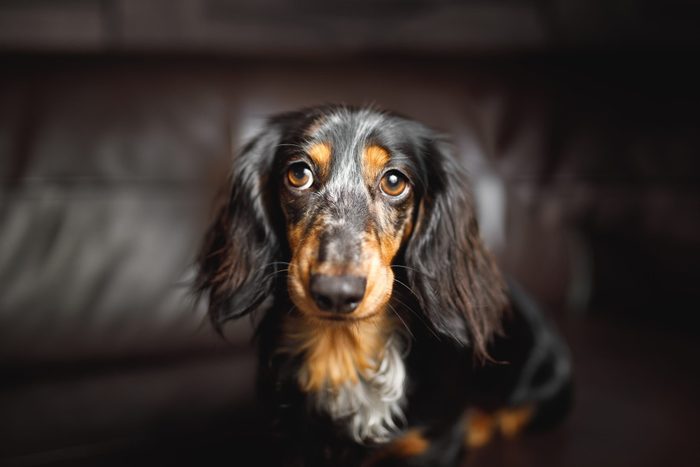
Do dogs have a sixth sense?
“The sensory ability of dogs, at least in the realms of smelling and hearing, are well beyond those of humans,” says Coren, which may lead some owner to believe their dogs have a sixth sense. We do know that dogs can sense many things we can’t. They can hear high-frequency sounds we can’t, smell an entire world of odors we can’t and see in the dark and detect slight movements we can’t see. Dogs have even been shown to react to the earth’s magnetic field and some can sense impending seizures in their person.
Can dogs see things we can’t?
The human and canine visual worlds are very different. Dogs can’t see the spectrum of colors humans can and have poorer vision for details. But they can see in the dark far better than we can, because their eyes are built to gather more light through their larger cornea and lens, to let more light in through their larger pupil, to detect more light with their greater abundance of light-sensitive cones, and to reflect light that gets past them for a second chance of detection by means of a mirror-like structure at the back of the eye. When you’re out at night tripping over lawn furniture your dog is nimbly galloping and jumping, wondering what is wrong with you. Dogs can also detect flickering light at a much faster speed than we can.
Can dogs sense bad/good energy?
From a scientific point of view, dogs can smell when people are nervous, and even detect when they are lying by sniffing their sweat on their clothing. So in that sense, yes. From a paranormal view, assuming they can sense energy, then yes again, they could pick up on good vibes versus bad vibes, but again, the answer is subjective.
Sources
- Alexandra Horowitz, PhD, senior research fellow and adjunct associate professor at Barnard College and author of Inside of a Dog: What Dogs See, Smell and Know; email interview on April 2, 2024
- Jesus Aramendi, DVM, former senior veterinarian for Chewy and founder of FurLife Vets in Delray Beach, Fla.; interview March 2022
- Stanley Coren, PhD, professor emeritus in the Department of Psychology at the University of British Columbia and an adjunct professor at Bergin College of Canine Studies. He’s the well-known author of several books about dogs, including Gods, Ghosts and Black Dogs; email interview on April 4, 2024
- RealClear Opinion Research Poll
- Charles Peden, psychic medium and animal communicator; phone interview on April 4, 2024
- Ecology: “Magnetic alignment enhances homing efficiency of hunting dogs”
- PLOS ONE: “Dogs can discriminate between human baseline and psychological stress condition odours”
